
Riding Europe 2003
Note: This is not the first time riding in Europe or the last. Just part of 8 years on the road with motorcycles placed in different land masses.
April 7, 2003
 We’ve been here for a week now, back in the Paris we are so familiar with that it doesn’t seem remarkable any more. Looking around, however, there’s plenty to see if you just keep your eyes open. We are staying at the eastern edge of Paris this time, away from the touristy, sophisticated and glamorous center and from here we walk everyday into town. Paris is so densely concentrated that one can walk from one side of town to the other in half a day, were you so inclined. We pass through a very ethnic neighborhood that is an exotic stew of immigrants, mostly North African Arab immigrants; Algerians, Tunisians and Moroccans, with a sprinkling of Asians and Turks. An occasional black African woman resplendent in eye-blinding colored cotton clothing strides down the street, matching turban on her head and plastic thong sandals on her bare feet. Her meeker African sisters, swathed from head to toe in bright colored gauzy fabric, walk escorted by the family’s elder males. Groups of Arab men having a heated discussion on the sidewalk or sitting in a café smoking and drinking tea. The Arab woman crouched on the pavement outside the metro, selling bunches of wilted lilac branches out of a metal bucket.
We’ve been here for a week now, back in the Paris we are so familiar with that it doesn’t seem remarkable any more. Looking around, however, there’s plenty to see if you just keep your eyes open. We are staying at the eastern edge of Paris this time, away from the touristy, sophisticated and glamorous center and from here we walk everyday into town. Paris is so densely concentrated that one can walk from one side of town to the other in half a day, were you so inclined. We pass through a very ethnic neighborhood that is an exotic stew of immigrants, mostly North African Arab immigrants; Algerians, Tunisians and Moroccans, with a sprinkling of Asians and Turks. An occasional black African woman resplendent in eye-blinding colored cotton clothing strides down the street, matching turban on her head and plastic thong sandals on her bare feet. Her meeker African sisters, swathed from head to toe in bright colored gauzy fabric, walk escorted by the family’s elder males. Groups of Arab men having a heated discussion on the sidewalk or sitting in a café smoking and drinking tea. The Arab woman crouched on the pavement outside the metro, selling bunches of wilted lilac branches out of a metal bucket.
Our hotel is across the street from a large parking lot, which on the weekends transforms itself into a tent city of a market, large umbrellas shading cheap merchandise from third world countries; plastic shoes, rugs, clothing, electronics and toys, fabric, cosmetics and sunglasses. The occasional stall features used goods and “antiques” that couldn’t be more than 15 years old. Islamic goods- prayers beads, lace trimmed white head scarves, books and objects with Arabic script are common as most of the vendors are Algerian. The periphery of the market reveals another layer of society; the two young men being detained by stern looking police, or the one-armed beggar with his jacket slipped coyly off one shoulder to reveal a smooth round shoulder and a scar where his arm should be, another man with bare feet stretched out on the sidewalk in front of him, small round toes perched on swollen misshapen feet like a handful of garbanzo beans. Knots of young men stand around eyeing the passersby. A few people stand by the fence almost furtively, with a few meager things to sell on the sidewalk in front of them. Others hunched over these items, inquiring the price of a worn pair of ladies shoes or an old boom box.
It was raining when we arrived in Paris but the sun is shining today. The wind is icy, though, and we are bundled against the cold as we shoulder our way through the market to walk into town. I am wearing both of the sweaters I brought to Europe, a rain jacket and a wool scarf that wraps around my head and neck to keep any cold air out. Mike arrived in Paris with a cold, and I, suffering initially with a bad allergy attack now seem to have also succumbed to a cold as well, so we leave a trail of damp Kleenex behind us as we make our way towards town. We vow to not come to back to Paris before summer again and Mike says if he talks again about wanting to spend winter in Europe, I have permission to smack him. There are flowers blooming; cherry trees with branches densely covered with pink blossoms, forsythia bushes with their starry yellow blooms, lilacs just starting their purple display. Elsewhere, trees with branches pruned to blunt clubs show few sprouts and just the barest hints of buds unfurling mint green leaves against the grey sky.
After spending the day in town, we came back to the hotel at 7:30 with the sun still in the sky. The market was being quickly and efficiently torn down and by dark an hour later, all that was left was the detritus of the day; plastic bags, tissue paper, shoe boxes blowing in the wind, wrapped around light poles or swirling high into the air in a mini cyclone. The city had already sent out their clean-up trucks and soon the piles of garbage were safely stowed in the garbage truck while stray pieces of garbage were chased down the street by an army men wielding leaf blowers.
Inspired by the wintry weather, we decided to have dinner at a restaurant that specializes in the food of Savoy. Consisting of various ways to serve cheese, potatoes and cold cuts, the cuisine from the Alps of France is comforting and warming. I had my favorite dish, the Tartiflette which is similar to scalloped potatoes; potatoes baked in a dish with reblochon cheese, crème fraiche, onions and chunks of ham or thick bacon. Mike had Raclette; he received a platter of cheese and cold cuts and a bowl of boiled potatoes. Each table has a small grill about one foot square built into the table which the waiter heated up for us and soon mike was able to melt the cheese to put over his potatoes and to cook some of the meats provided. Fondue is also a typical dish from this area; not a place for those on a weight-loss diet.
April 9, 2003
Some of you have asked why we are in Paris when you thought we were going to Sevilla…that’s a good question. We aren’t scheduled to move into our apartment until the 17th of April. In hindsight, maybe we should have waited in Paris until the last minute then blast our way south, but I’ll talk about that later. We wanted to give ourselves some time to have a nice, leisurely trip to southern Spain and to visit some new places on the way, so we bought a ticket on the Auto-train which would carry us and the motorcycle to the south of France overnight. The weather in France was really too cold to enjoy and the weather in Spain should surely be nicer.... Hoping to get somewhere close to the border of France and Spain, we tried getting a ticket to Biarritz or Narbonne but the trains were already full of French people going to the south of France for their Easter holidays. We finally settled on the train to Toulouse on Monday, the 7th.
On Monday, after dropping the bike off at the train station, supervising the strapping down of the bike, and a very nice dinner with some ex-pat friends of ours, we went back to the station to catch our 11pm train. On the train, we shared a 6 bunk sleeping compartment with 4 French women and their backpacks, who were off to walk the pilgrimage for their holidays. People have been making the pilgrimage to Santiago de la Compostela in the northwest corner of Spain as an act of faith or endurance ever since the Middle Ages.
The train arrived in Toulouse 6:30 in the morning and after showering at the train station and having a quick breakfast (part of the train ticket price), we were ready to hit the road. Of course, it’s freezing cold and we can see our breath as puffs of steam. Overnight, my cold has settled into my chest and I would really rather go back to bed. We are committed at this point though, so we head off to find the highway. Finally out of town, the countryside is beautiful and the sun seems to be trying to break through the clouds. The Pyrenees are off to our left as we parallel them heading for the coast. The auto-train is a really nice concept, great for getting from one place to another quickly with your vehicle while you sleep, but in reality you don’t sleep real well, so when we stopped at a rest area for some gas, Mike lay down on a bench and was soon fast asleep in the weak sun. I went wandering around and visited a small museum on the site which was devoted to the pilgrimage of Santiago. Tradition says that a tomb was discovered in Santiago de la Compostela in the year 830 after St. James appeared to Charlemagne in a vision commanding him to find his tomb which could be found by following the star. Whether this was a special star a la the star the Three Wise Men followed to find the Christ Child or whether he was to follow the Milky Way, I am not sure, but ever since then people with faith have walked the routes leading to Santiago. The pilgrimage took 4 main routes through France, funneling into two main roads that led across the north of Spain to the beautiful cathedral at Santiago where St. James’ remain are still said to be. Some of the more devout would continue on to the lands end at Finisterre or A Coruna where they would collect cockle shells to adorn their staff or hat to show they had made the journey but nowadays one only needs to visit the souvenir shop in the plaza. To this day the cockle shell is a symbol of the pilgrimage and can be seen in places that might have sheltered a pilgrim, carved into walls or laid as a mosaic floor. One such place is in Paris, the medieval Hopital de Cluny which today houses a museum of medieval art. The outside of the building has magnificent carvings which include the shells I spoke of.
So anyway, we ended up for the night in a cute French beach town called St. Jean de Luz about 30 miles south of Biarritz. After a few tries we got a room in a hotel by the sea with a view of a vast green lawn that looked like a golf course rolling down towards the water. Duh, it was a golf course, with holes set in amongst large sculptures and benches for sitting and admiring the view. Mike wanted to go into town but I was feeling too sick to care so I laid down and napped while he took the bike to find a patisserie for a birthday cake for me. He came back with a small confection of pear and chocolate mousse which we shared as dessert at dinner and a bouquet of hand-made chocolates,
The next morning started out cloudy and went downhill from there. As we crossed the border into Spain and through the very industrial towns of Basque country, it began to rain. It was a shame, because we were passing through an interesting area of mountain passes, striated sedimentary rock twisted and tilted, and tidy Basque villages. Instead of watching where we were going I just hunched down behind Mike in an effort to keep the cold wind from going down the collar of my jacket. My legs and thighs were getting colder and colder and I tried in vain to keep my poor nose from running by stuffing Kleenex into my helmet. Thank heavens we have heated clothing or I would have frozen altogether!
April 12, 2003
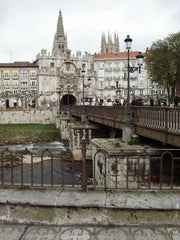 As soon as we reached the town of Burgos, we headed for a café to wait for the travel agency to re-open after siesta and to drink café con leche to get warm again. We bought talones and made some reservations for the next 5 nights. The talones are coupons which you buy from a travel agent for 50 Euros apiece and allows you to stay in 3 or 4 star hotels for one coupon a night. Normally we don’t make many reservations when we travel, preferring to go where the mood strikes us but the talone system is such a good deal that losing a little flexibility is a small price to pay. (See footnote below for more information on talons)
As soon as we reached the town of Burgos, we headed for a café to wait for the travel agency to re-open after siesta and to drink café con leche to get warm again. We bought talones and made some reservations for the next 5 nights. The talones are coupons which you buy from a travel agent for 50 Euros apiece and allows you to stay in 3 or 4 star hotels for one coupon a night. Normally we don’t make many reservations when we travel, preferring to go where the mood strikes us but the talone system is such a good deal that losing a little flexibility is a small price to pay. (See footnote below for more information on talons)
We saw a bit of Burgos while looking for the hotel, that is to say we saw a bit of the same streets as we drove in circles looking for our hotel from the directions the agent gave us. The temperature was dropping from a “balmy” 14C to a distinctly chilly 6C and now it was starting to rain. (it should be noted that 14C is equal to about 57F and 6C equals 43F if I am not mistaken. One thing I am sure of is that it was bloody cold!!) The travel agent had given us instructions on finding the hotel but we were having trouble understanding both her Spanish and the map she drew. Spain is famous for its lisping pronunciations; generally, all C’s and Z’s that should have an S sound to them are pronounced TH. Well, apparently in this area north of Madrid, not only do they speak as fast as a runaway train, they also pronounce the D as TH. The travel agent told us to look for “eltheeth” and everyone else we asked on our search for the hotel also pronounced it the same way. I had no clue what they were talking about, but once we got on the right road, it all came clear - they were referring to a huge statue of El Cid!
We didn’t see much more of Burgos; after reaching the hotel I retreated to the room and took a nice hot bath and didn’t want to go out into the cold wind again. In the morning we took a quick look at the cathedral and ornate portal to the old town. Apparently, Burgos was a major stopping point along the pilgrimage route, offering food and lodging to medieval pilgrims from about 30 different shelters. Our next night was spent in Segovia, and the drive the from Burgos was really pleasant, mostly spent on a 2 lane road through the sparsely populated countryside. The road took us through rolling hills with rocky fields, pine trees and scotch broom. Some of the fields are already green with crops and others are just starting to show the green iridescence of green sprouts against brick red soil. The road passed through a few ancient villages consisting of old stone houses, some leaning on each other, others having collapsed years ago; a few ruined castles or towers sit on nearby hills. We stopped to explore some ruins in a town called Turegano, which seemed to be some sort of fortified church along the road. We had spotted the ruins a ways up the road, noticing half a dozen large white and black storks lazily circling its towers. The ruins sat on a breezy hill next to a small town of more ancient stone houses and I could faintly hear flamenco music coming from one of them. I wish I knew more about the church, because it was very interesting. It had a high wall all around so we were not able to enter, with a rather plain church sitting inside its walls. The towers of the church had lots of large twiggy nests with storks standing here and there or sitting on a nest
Our next night was spent in Segovia, and the drive the from Burgos was really pleasant, mostly spent on a 2 lane road through the sparsely populated countryside. The road took us through rolling hills with rocky fields, pine trees and scotch broom. Some of the fields are already green with crops and others are just starting to show the green iridescence of green sprouts against brick red soil. The road passed through a few ancient villages consisting of old stone houses, some leaning on each other, others having collapsed years ago; a few ruined castles or towers sit on nearby hills. We stopped to explore some ruins in a town called Turegano, which seemed to be some sort of fortified church along the road. We had spotted the ruins a ways up the road, noticing half a dozen large white and black storks lazily circling its towers. The ruins sat on a breezy hill next to a small town of more ancient stone houses and I could faintly hear flamenco music coming from one of them. I wish I knew more about the church, because it was very interesting. It had a high wall all around so we were not able to enter, with a rather plain church sitting inside its walls. The towers of the church had lots of large twiggy nests with storks standing here and there or sitting on a nest
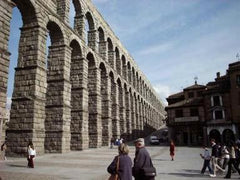 Segovia is an attractive city with a walled old town, some old palacios, monasteries and churches built in the 12th century, and an impressive roman aqueduct. Built around the 1st century, the aqueduct is in perfect condition; the series of free-standing arches are about 28 meters high and run across one of the main plazas in town.
Segovia is an attractive city with a walled old town, some old palacios, monasteries and churches built in the 12th century, and an impressive roman aqueduct. Built around the 1st century, the aqueduct is in perfect condition; the series of free-standing arches are about 28 meters high and run across one of the main plazas in town.
The next night was spent in the cramped old center of Avila only about 40 miles from Segovia. Our trip there was easy but just as we were nearing the city center, we got hit with a sudden shower of sleet, wouldn’t you know it! Fortunately we quickly found a place to pull under some shelter and wait for it to pass. Our hotel, (for which we paid one talone!) was nearby and easy to find; a renovated palacio conveniently located across from the cathedral. The hotel was very nice and had a large beautiful courtyard with stone arches and coats of arms on the columns, couches and chairs for sitting and drinking coffee or beer. We quickly explored all the sights including the requisite cathedral with stork nests, old buildings and plaza. The old town, set on a hilltop was completely walled as is the norm, but in Avila’s case the wall is still completely intact. Originally built to keep the Moors out, the wall had various portals allowing vehicles and people into the narrow streets. Interestingly, the stones of the high wall included many that were taken from an old Roman necropolis (cemetery) that had been found in the area. Some of the roman stones had inscriptions on them while others were carved as a pedestal for a statue or a niche.
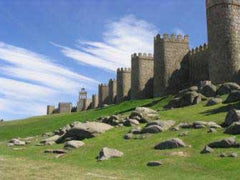 We discovered a great bar for wine called Bodeguita San Segundo, built into the defensive wall. Inside, the walls of the bar held shelves and racks filled with wine bottles from all over Spain. On the bar itself, groups of wines arranged by region and color were available for buying by the glass. Each glass of wine was accompanied by a small plate of tapas; a few pieces of cheese on bread, or perhaps some calamari or cured ham. When we got the bill, we thought there had been a mistake; 5 glasses of wine and a large plate of cheese came to around 25 Euros. The waiter said, well, you had 5 glasses of wine and.. "No, no", I said, "We thought the price was not high enough to be correct"
We discovered a great bar for wine called Bodeguita San Segundo, built into the defensive wall. Inside, the walls of the bar held shelves and racks filled with wine bottles from all over Spain. On the bar itself, groups of wines arranged by region and color were available for buying by the glass. Each glass of wine was accompanied by a small plate of tapas; a few pieces of cheese on bread, or perhaps some calamari or cured ham. When we got the bill, we thought there had been a mistake; 5 glasses of wine and a large plate of cheese came to around 25 Euros. The waiter said, well, you had 5 glasses of wine and.. "No, no", I said, "We thought the price was not high enough to be correct"
Wandering outside of the walls we encountered a group of minstrels, commonly called Tunas, singing and mugging for a small crowd of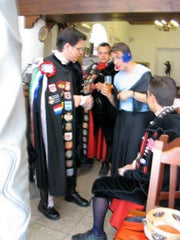 teenaged girls. The minstrels are part of a Spanish tradition of university students singing to raise money, dressed in a costume from long ago; velvet bloomers or knickers and long capes with ribbons and patches. I’m not sure however, if they are still students – some of the ones I have seen look a little old…In the photo we see a group of Tunas chatting with their "girlfriend", a fellow Tuna dressed as a woman. (Yeah, I know it's a blurry photo, but it's the best I could get.)
teenaged girls. The minstrels are part of a Spanish tradition of university students singing to raise money, dressed in a costume from long ago; velvet bloomers or knickers and long capes with ribbons and patches. I’m not sure however, if they are still students – some of the ones I have seen look a little old…In the photo we see a group of Tunas chatting with their "girlfriend", a fellow Tuna dressed as a woman. (Yeah, I know it's a blurry photo, but it's the best I could get.)
We decide to stay another night because the weather is still not great and I am keeping us both awake at night coughing. A modification in travel plans is in order, so we go to find a travel agency. The travel agent who helped us make our itinerary changes here worked in a office that was modern a few decades ago; no computers in sight and itineraries painstakingly typed on an ancient typewriter, arrangements made by phone.
Talones: There are several companies in Spain offering these hotel discount coupons. For the price of one talon (or coupon or check), you can get a double occupancy room in a 4 or 5 star hotel for only €50, or for 2 or 3 talones you can get a super luxurious room at the fanciest resorts. The company we used was called Bancotel. Bancotel has a long list of participating hotels throughout Spain, and a more limited selection in other countries such as France and Portugal. Normally, one buys the talones in travel agencies in Spain, but Bancotel is now offering them for sale on the internet - see their website for information and booking at www.bancotel.com. Talones are good until March of the following year. It is easy to get a reservation; through the website or through a travel agent (in Spain). Sometimes you can even walk in to a hotel and ask if they will take a talone for that night. Reservations are good until 5 or 6 PM the day of the reservation (call the hotel to keep the reservation if you are coming in later than that), and if you change your mind about a reservation you don't lose the talone - just don't show up. We love Spain, but we find the lodging can be over priced - a marginal room in a 2 star pension can cost you €50. With the talon system you get better accommodations for a reasonable price. Note: It is normal to have to buy a book which contains 5 talones at a time, but some of the travel agencies will sell you as many as you need if they have loose ones.
Bodeguita San Segundo can be found in Avila, Spain , at number 19, Calle San Segundo.
April 16th, 2003
When we left Avila, we finally descended the high plains we had been on since Burgos and once we had crossed a couple of 3-4000 ft passes on a 2 lane country road, we were soon winding our way down the mountains into a fertile garden-like area. It had rained maybe an hour before we passed and the road was just drying, but the air was fragrant with the earthy smell of wet green plants and damp earth as well as the smell of the abundant Spanish lavender growing alongside the road.
The wildness of the Spanish countryside slowly gave way to cultivated fields and groves of trees; olive groves interspersed with fields of grain. As we descended, the road crossed an old Roman road, zig-zagging down the hillside on a path of its own. Built of stone, the roman road was broad enough for two lanes of traffic and was in such good condition that it appeared as if it had only been abandoned from use a few years ago. Called the Ruta de la Plata, the route of silver, the road once ran from just north of Sevilla all the way to the Northern coast of Spain. Today, most of the road has been obscured by the modern road which follows the route of the old roman road. Too soon we hit the highway and picked up speed. The air was balmy but we were riding towards an ominous bank of clouds that just kept getting blacker; suddenly we were hit with some terrific side winds and the temperature dropped about ten degrees. When it finally started raining, it came down in sheets so we ducked under a nearby hotel’s covered parking and had a cup of coffee at the bar to wait out the rain. Luckily we weren’t too far from our next hotel for the night, in Merida.
We had been in Merida before and enjoyed it very much. It started out as a roman model city in 25 B.C. called Augustus Emeritus which was built to house roman military veterans and also to impress the local Spanish peasants. There are many ruins to see and a beautiful museum housing some very nice mosaic floors but unfortunately by the time we got to the museum it had just closed and wouldn’t open again for a couple of days. The weather was very different from our last visit, also; instead of hot sunny weather, we had cold wind and rain.
We still have three days to kill but little motivation to stay in Merida longer, the grey gloomy weather and cold wind was not encouraging and it was a bit of a hike from our hotel to get to the 1 kilometer long roman bridge that we had to cross to get into town. We decided to go to a town called Zafra the next day, partly because we liked the name of it and partly because it was on the road to Sevilla.
Zafra is a charming small town with few tourists; inhabited through history by a succession of peoples – Romans, Moors, Visigoths and Spanish, all leaving their unique stamp on the town. We checked around and found a two star hotel for €29 a night with a room that wasn’t fancy but was close to the main square, 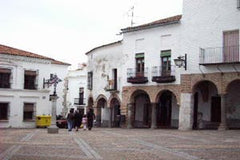 a pretty plaza ringed with arched arcades and palm trees around a round fountain. The hotel was grandly called Hotel Don Quijote and the proprietor a cheerful round man with a resemblance to Sancho Panza. Townspeople strolling across the plaza headed for the pedestrian shopping street leading off one side of the plaza for their evening walk. Among them were a trio of brown habited nuns with rope belts and white wimples looking as if they had just stepped out of a painting from the middle ages.
a pretty plaza ringed with arched arcades and palm trees around a round fountain. The hotel was grandly called Hotel Don Quijote and the proprietor a cheerful round man with a resemblance to Sancho Panza. Townspeople strolling across the plaza headed for the pedestrian shopping street leading off one side of the plaza for their evening walk. Among them were a trio of brown habited nuns with rope belts and white wimples looking as if they had just stepped out of a painting from the middle ages.
Sitting in the bar of our hotel having breakfast one morning, Mike struck up a conversation with an older couple. They turned out to be from Holland and were pilgrims, this year intending to walk from Sevilla to Salamanca, some 295 miles in the space of 2 or 3 weeks. They have been making a pilgrimage for years and apparently do it in stages, each year walking a different section of the trail. The modern pilgrimage trail is not much different from the “old” days, being a trail marked with yellow arrows that passes through towns along the way where a pilgrim can find food and lodging.
A small fortified castle called the Alcazar is one of the most interesting buildings in Zafra 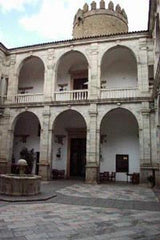 with 8 round turrets with crenellated tops and a large square open-air courtyard inside. The Alcazar has been restored and is now a special type of Spanish hotel called a Parador where you can spend a luxurious night in restored historical buildings such as medieval castles, forts, convents and monasteries or antique palaces starting at about $100 per night. They can be found all over Spain and many can be paid for on the talone system. We have tried a few times to reserve a night in one but rooms can be difficult to come by at this time of year.
with 8 round turrets with crenellated tops and a large square open-air courtyard inside. The Alcazar has been restored and is now a special type of Spanish hotel called a Parador where you can spend a luxurious night in restored historical buildings such as medieval castles, forts, convents and monasteries or antique palaces starting at about $100 per night. They can be found all over Spain and many can be paid for on the talone system. We have tried a few times to reserve a night in one but rooms can be difficult to come by at this time of year.
Our first night in Zafra coincided with the second night of Semana Santa (holy week). Sitting in a tapas bar having something to eat, I heard the strains of some very eerie music slowly getting louder so I went out to see what was going on. At the corner of the street were a collection of damp spectators with umbrellas unfurled against the sprinkles coming from the sky watching a candlelit procession. The penitents in their pointy Ku Klux Klan headgear had just passed carrying fat three foot long candles; long white robes, red capes and hoods covering the face make them look anonymous and sinister. One of the first pasos of the week was laboriously edging its way around the corner, followed by a band of cornets and drums playing a wavery mournful sound, beautiful and dire at the same time. The paso, a sort of parade float about the size (and weight) of a small car, is carried on the backs of about 30 or 40 men concealed underneath. The procession moves agonizingly slowly as the float has to be set down every 10 minutes or so to let the carriers rest, then on a signal the float is heaved into the air with a grunt and slowly sets off down the street again. The float was made of richly carved and gleaming wood and the top was covered with a carpet of red carnations and purple iris with large candelabras at each corner with fat white candles. The sole wooden figure of Jesus stood in the center, almost life sized, hands bound with a golden rope. His white velvet robe was simply embroidered in gold thread at the hem and three golden rays emanated from his head, signifying the trinity. Because of the rain, Jesus was unfortunately wearing a plastic bag from head to toe to keep him from getting wet, somewhat diminishing the impact! The floats usually weigh a ton or more, and the slow steps of the men underneath it cause the float to sway down the street from side to side in kind of a trudging manner giving the illusion that Jesus was slowly and painfully walking to his doom. Even I have to admit, that although I am not a religious person, I found it hard to not be moved by the spectacle.
After the Paso of Jesus and his attendants came the Paso of a mournful Mary, standing weeping behind a bank of long white candles and white roses, under a canopy richly embroidered with precious gems and metal threads, gold tassels and golden lace. Her progress was perfumed by clouds of burning incense and was accompanied by her own entourage of penitents and marching band. As the paso moved down the street the canopy covering it would sway from side to side almost touching the walls of the buildings on either side of the narrow streets.
Holy week is taken very seriously by the Spanish but nowhere as fervently as in Sevilla where the series of processions that loop through the town, leaving the home church, pass through the great doors of the cathedral and back out again to head back home again, sometimes 8 or 9 hours later. This year however, the rain prevented many of the pasos from leaving home; images on the TV showed shocked and sodden penitents sobbing with disappointment in the pouring rain.
After two nights in Zafra, we were ready to move on. We still had one night to kill so we headed towards the southern coast of Portugal through pine and eucalyptus forests and fields of grain, fields with sprouts of sunflowers already 2 or 3 inches high. The sun was shining which was a wonderful change, and as we moved a little further south and west, we started riding through vast orchards of olives and orange trees, the scent of orange blossoms filling the air; so strong and sweet smelling at times you could almost taste it. By afternoon, we were in a small town called Tavira where we got a room in a new hotel with a view of the town and a sliver of ocean. For the first time during our trip through Spain, we finally were able to enjoy a day with sun! Judging from the sunburned skin of the tourists in town, we weren’t the only ones happy to see it.
Tavira, like most typical Portuguese towns, from a distance appeared tidy and blindingly white but close up you notice that the front facades of the buildings have been covered with patterned tiles like fancy wallpaper. We took a walk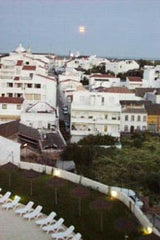 through town at twilight, and the air was still warm and softly scented with the orange blossoms of the orchards a few miles away. The river running through the town was lined with restaurants selling fresh fish and sea food, where we stopped to have a drink at one of the tables on the sidewalk.
through town at twilight, and the air was still warm and softly scented with the orange blossoms of the orchards a few miles away. The river running through the town was lined with restaurants selling fresh fish and sea food, where we stopped to have a drink at one of the tables on the sidewalk.
For the first time after leaving Paris, we were able to find a self-service laundry in Tavira where we could finally wash our clothes. Self service laundries are hard to find in Spain so travelers are forced to either have their hotel wash their clothing or else take dirty clothes to a local dry-cleaners to have them washed. But for people who are traveling on a long term basis this gets a little expensive and while washing clothing by hand in the bathroom sink may be ok for socks and undies, shirts and jeans just don’t get very clean. So you can imagine we were very happy to be able to change clothes into something freshly laundered. We chatted for a while with the proprietor of the laundry, a Frenchman from Paris who finds the life in Tavira to be much more to his liking; calm, cheap and with nice sunny weather. He told us where to find a good supermarket and recommended a decent local wine that costs only €1.99. (!) We had a simple dinner of local Portuguese cheese, bread and wine, an apple and some almonds while we watched the moon set, hanging over the sea huge and rosy orange like a peach.
Footnotes:
The Hotel Don Quijote can be found at 3, Calle Huelva in Zafra, Spain. Telephone- 924 55 47 71, fax 924 55 47 82. It is a 2 star hotel with its own bar and restaurant. The rooms have their own bath, TV, and telephone for around €30 a night double occupancy. Not fancy, not including breakfast, but clean and close to main square.
April 17, 2003
Sevilla at last!
Wreathed in sunshine, por fin, Semana Santa is finally in full swing. The first four days were almost a total write-off due to rain; most of the pasos are far too costly to chance being water-damaged but there are 4 more days and many processions left to go. It seems all of Sevilla - tourists and Sevillanos alike - are in the streets in anticipation of the afternoon’s procession due to leave the church shortly. It is Holy Thursday and mass has just let out; today is a special day because everyone who has attended church is dressed even nicer than usual. The men wear black suits but it is the women who look spectacular in their simple black dresses and lace mantillas. They wear a high tortoise-shell comb at the back of their head with the black lace scarf called a mantilla draped over it and fastened at the back with a coral and gold pin. This tradition is very old and symbolizes the mourning for the death of Christ. In pairs or groups the mantilla clad women make a very arresting sight and we foreigners find it hard not to stare – especially when she is young and pretty to start with!
It is on this day that we arrive in Sevilla, without a street map, and driving instructions that had us coming into town from the north instead of the west. The streets of Sevilla are typical of most old European cities; to call these streets a maze would imply that there is some organization or system. The streets change names so frequently that one often won’t name street names when giving directions, for the most part relying instead on landmarks such as churches or plazas which are plentiful here. There was no deficit of people willing to point us in the right direction, though, and thankfully we didn’t have to drive through the center of town; fully loaded with our gear, the motorcycle is heavy and easily dropped on the narrow one-way streets and slippery cobblestones. Negotiating the one way streets is best done on foot. Once at the apartment, we then had the challenge of actually getting in. Our landlord, Pepe seemed surprised to hear from us and told us he wasn’t expecting us for two more days. After a few phone calls he finally said he could let us rent one of the apartments for 100 Euros per night for two nights because our apartment is occupied. Being semana santa, Sevilla is crowded with foreigners and the thought of getting back on the bike to search for 2 nights lodging was not appealing. (note: we are paying about €930 for one month in the apartment so we were a little stunned to be charged €100 per night when we thought we had already paid for everything. Checking with the school on Monday, we found that the school agreed with us as to which day we were supposed to arrive so we were all confounded as to what went wrong.)
After getting settled in our new home for 2 nights, we changed and went to meet our friends, Bob and Hae Shin, who are staying for a week in the same building we are in. Friends from Portland and now ex-pats in Italy, Bob is a flamenco guitarist and his Korean wife is working for the U.N. in Rome. Hae Shin wanted to see Semana Santa in Sevilla at least once so they managed to get a week off to come and see the spectacle. After sitting in the plaza eating tapas and catching up, we went to watch a relatively short procession that would pass by a church not far away. Standing on the narrow street, we waited for the procession while the sidewalk gradually became packed with other spectators. Soon enough, the first sounds of a snare drum echoing through the streets, then we saw the first of the nazarenos holding long fat candles. As in all of these processions, there were frequent stops to wait for the paso to rest, then catch up with the rest of the parade. In the meantime, the candles continue to burn, dripping melted wax on the pavement. For weeks afterwards, the wax is there until the weather gets warm enough to melt and stick to the tires of passing cars. Not all the melted wax ever reaches the pavement, though, and many of the nazarenos we saw were speckled with melted gold wax having been dripped on by another’s candle – it’s not easy to see through the narrow eyeholes cut into the hoods they wear and are not always paying attention to where their candle is pointed! I saw a few close calls when someone halted suddenly and the one behind wasn’t paying attention but I have yet to see a flaming nazareno. Many of the children spectators dodge out into the street whenever the procession halts, begging for drippings from a candle in order to make a ball of wax larger or holding out a piece of foil crushed into a small ball to get started on one. Some of the bolder boys had large multi-colored wax balls the size of a large orange and the children with none 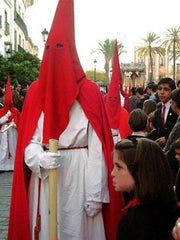 would look on enviously and beg to be able to hold it. Behind the nazarenos came a phalanx of barefoot penitents carrying crosses and the first paso which stopped right in front of me. Hemmed in on all sides and almost crushed up against the red velvet drapes of the paso, my breath clouding the ornate silver-work, I was almost claustrophobic. (I told you the street was narrow!) Soon enough the man guiding the paso gave the signal to proceed and on three and in unison the paso bearers heaved the float back on their backs and continued. They approached the church, laboriously turned the float perpendicular to the street then went up to the door, where the paso kneeled in respect then slowly backed up and turned to continue on its way up the street. Mary followed on her paso, en suite, with the usual attendants and incense bearers and paid her respects as well.
would look on enviously and beg to be able to hold it. Behind the nazarenos came a phalanx of barefoot penitents carrying crosses and the first paso which stopped right in front of me. Hemmed in on all sides and almost crushed up against the red velvet drapes of the paso, my breath clouding the ornate silver-work, I was almost claustrophobic. (I told you the street was narrow!) Soon enough the man guiding the paso gave the signal to proceed and on three and in unison the paso bearers heaved the float back on their backs and continued. They approached the church, laboriously turned the float perpendicular to the street then went up to the door, where the paso kneeled in respect then slowly backed up and turned to continue on its way up the street. Mary followed on her paso, en suite, with the usual attendants and incense bearers and paid her respects as well.
Hae Shin said there was a particular procession she wanted to see, so later that evening we were winding through the streets to reach the other side of town, Bob leading the way and stopping often to consult the map. We are heading for the Macarena district for a procession that is due to leave the basilica at 12:30 in the morning. There was a huge crowd when we got there, it seemed like the closest we could get was a half kilometer away, but no matter, I was glad we had gone. The first paso depicted Jesus as a condemned prisoner with several roman centurions with headdresses adorned with white ostrich feathers and Pilate relaxing on his throne. It was hard to see many details but suffice it to say that the luxurious decoration belied the solemnity of the scene. Following the paso were a large group of Nazarenes dressed in Roman garb matching the centurions on the float – all we could see was ostrich feathers bobbing above the heads of the crowd. There must have been 150 of them, but wait there’s more! After them came an endless stream of the guys with the pointy hats and tall silver candlesticks. They kept coming out of the church and after about 20 minutes of seeing them parade by, Bob joked that there was a machine inside the church stamping them out one by one. I could almost believe it! The slow progress of the paso meant the procession didn’t move very fast but there were a vast number of penitents with this paso. By my watch it took half an hour for just the last group to pass.
Finally they had all left the basilica and the crowd anxiously awaited the virgin’s paso. As she left the church a huge cheer went up and someone in the crowd cried out “Macarena!”, and the rest responded “Guapa! Guapa!” (Beautiful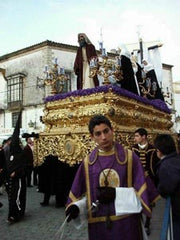 Lady), continuing to call until she had passed. I had to go to the Basilica a few days later to see how splendid the float was; elaborate silver all around the sides polished to a high gloss, silver posts holding up the canopy of purple velvet so encrusted with embroidery of gold thread it was hard to see the fabric. Her robe was equally as lavishly embroidered. The bank of white candles had burned down quite a bit and the white flowers had wilted a little but was still impressive to see and incredible to think that this enormous thing could be carried by humans.
Lady), continuing to call until she had passed. I had to go to the Basilica a few days later to see how splendid the float was; elaborate silver all around the sides polished to a high gloss, silver posts holding up the canopy of purple velvet so encrusted with embroidery of gold thread it was hard to see the fabric. Her robe was equally as lavishly embroidered. The bank of white candles had burned down quite a bit and the white flowers had wilted a little but was still impressive to see and incredible to think that this enormous thing could be carried by humans.
As I said, this particular procession left at half past midnight and would trudge through the streets until reaching the cathedral in the center of the city. There it would enter and be blessed. After leaving the cathedral it would wind its way back to the basilica where it started out, non-stop until 1:00 in the afternoon more than 12 hours after it started. Holy Thursday is the peak day of Holy Week, in which there are 7 different processions in different parts of the city at different times of the days, converging on the cathedral and back again. Wait, that’s just the afternoon processions. There are 6 more that go on throughout the night.
By Sunday there is only one procession left, this one showing the corpse of Jesus in a transparent glass coffin and a lavish spread of flowers. All through the city, the tires of cars passing by make a squealing sound because of the wax on the pavement and making them sound as if they are racing …
Footnotes:
Unfortunately I have no digital photos of Semana Santa in Sevilla because our digital camera isn't good in situations with low light or movement. It is also getting a bit flaky in its old age (aren't we all?). I do however have photos from Semana Santa in Jerez de la Frontera, taken several years ago. They are not the greatest photos but should give you a better idea of what I am talking about. One of them is a photo of a Nazarene with his candle and a typical paso of Mary in the back ground. Another is a photo of a different paso of Mary; although they are from different churches, they follow the same pattern. The last photo is a paso with Jesus being taken down from the cross and carried away on a stretcher. If you look carefully you can see the feet of two of the men carrying the paso from underneath.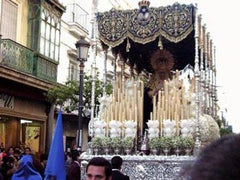
Hi, everyone. Time has passed so quickly and I can’t believe our time in Sevilla has passed so quickly. We had originally planned to stay for one month but we were having so much fun we decided to stay for one extra week. When we came, it was rainy and cold one day and warm and dry the next, but for the last 2 or 3 weeks the afternoons have been sunny and hot, reaching 95F during the day. There are lots of things to do, and of course we were taking Spanish classes 4 hours a day so before we knew it, it had gotten late in the evening and we had yet to eat dinner. We seemed to have fallen quite naturally into the Spanish rhythm of eating dinner late in the evening.
I think by now I have walked through all parts of the city in spite of feet that hurt from walking so much. There is always something interesting to see and ALWAYS new ways to get lost! I can’t tell you how many times I will take the wrong way even though I know Sevilla fairly well. I recognize the intersection and say to myself, “I have been lost here before!” The “old” part of Sevilla is fairly large and one of the most confusing cities that I have tried to navigate. The streets usually look nothing like the map, and the street signs, usually a tile pasted to the wall near the corner, are not always in evidence.
We have a theory that the streets were planned this way in order to confuse invaders and provide points of ambush, and I can believe it! A street can suddenly become so narrow a car must fold its side mirrors in or drive with two wheels on the sidewalk in order to fit through, or become an alley so narrow that you could put your hands on your hips and be able to touch both walls with your elbows. Streets encounter other streets at crazy angles and rarely run parallel to each other, nor do they ever run straight for very long. Sometimes a street will widen into a plaza with a church or tables for a nearby bar. One day we sat at a table in a plaza, watching one car after another try to negotiate a sharp left hand turn into a narrow street (one of those mirror folding ones), holding traffic up while they tried to figure out how to enter the mouth of the street – usually one of the passengers would get out to direct the driver.
Driving is hazardous in this city but to walk can also be crazy and you often end up walking in the street. It is difficult to imagine not having ample sidewalks and building facades that are not aligned with each other, but here it is normal for a sidewalk to suddenly become too narrow to walk on or disappear all together. On our walk to school, we take a street that has a lot of traffic on it and facades at crazy angles to each other; the sidewalk dwindles to the width of a curb and one must wait for a break in the traffic to pass another person coming towards you. One must also always be vigilant for pet doodoo on streets and sidewalks; while not quite as bad as in France, there is enough here to always need to watch ones step!
As is typical throughout most of Spain, most homes are built in a traditional style that came from the Romans and later, the Moors. From the outside, the building is fairly plain, typically painted white with a heavy wooden door and a few windows barred with wrought iron. In Sevilla, the trim is painted in a contrasting color of golden yellow or a shade closer to the color of mustard. The two or three upper stories usually have narrow balconies no wider than a foot and a flat roof which is used as another patio and a place to hang clothes out to dry in the sun. In the afternoon, the wooden outer doors of the houses are left open wide enough for a passer-by to glimpse the tiled vestibule and an ornate cast- iron gate. Through the gate, you will normally see a tiled courtyard, open to the sky, with arches and columns all around, many with a small fountain in the middle and leafy potted plants and palms. It is almost as if the house sits with its back to the outside world and only reveals it true beauty to those who are lucky enough to gain access inside. The various rooms of the house open into the courtyard to take advantage of light and cool air produced by the quantities of marble used in construction – not to mention 3 foot thick walls as are found in the older buildings. As I said earlier, it has gottenquite warm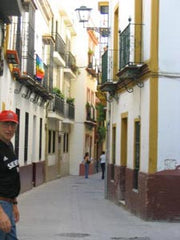 lately and passing by one of these open doors you will feel a blast of cold air as if you had just walked in front of an air conditioner.
lately and passing by one of these open doors you will feel a blast of cold air as if you had just walked in front of an air conditioner.
I think that most of these old buildings have now been converted into apartments for multiple families. Most of these places are very old but I am happy to say that I have seen many buildings being renovated and rehabilitated.
The building we live in is a little more modern; the apartments are situated around a cobblestone courtyard that serves as a driveway for the cars who park underneath the building. We have one bedroom, a bathroom, a small living room and a tiny kitchen with a refrigerator and two burners. We also have a washing machine for washing our clothes in cold water and a drying rack to set in the living room in front of the French doors that open onto the typical narrow balcony. A tree arches over the front gate which opens directly onto the street. The tree is blooming now, sporting purple trumpet shaped flowers which drop from the tree and are sticky underfoot. In the mornings the tree is filled with birds, flying from branch to branch and their song blends with that of the caged canaries set on balconies to get some fresh air. Our little apartment is in the north part of the city, in what was once the Jewish quarter. To the left, our street slowly dwindles down in size until it ends in a curb with tables for eating tapas from the bar at the corner. 8 or 9 little boys live nearby and often play in the alley, practicing their soccer moves or sit in a doorway with their coloring books.
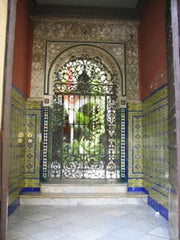 We have settled into life in Sevilla after the crazy week of semana santa. We get up in the morning (earlier than I would wish, some days), and on our way to school we stop at a bar for our breakfast; a creamy hot café con leche (espresso with hot milk) served in a glass the size of a juice glass, a bread roll cut in half and toasted, and a glass of freshly squeezed orange juice out of a rube goldbergian machine that most bars have. The oranges are placed, whole, into the hopper on top which feeds the oranges into the machine one by one, cuts them in half and squeezes them, the whole process visible through the plastic front.
We have settled into life in Sevilla after the crazy week of semana santa. We get up in the morning (earlier than I would wish, some days), and on our way to school we stop at a bar for our breakfast; a creamy hot café con leche (espresso with hot milk) served in a glass the size of a juice glass, a bread roll cut in half and toasted, and a glass of freshly squeezed orange juice out of a rube goldbergian machine that most bars have. The oranges are placed, whole, into the hopper on top which feeds the oranges into the machine one by one, cuts them in half and squeezes them, the whole process visible through the plastic front.
When our classes are done at 1pm, it is time to eat again. The stores close around 2pm and won’t re-open until about 5, so there’s plenty of time for a nice big lunch or perhaps some tapas if we are not so hungry. The streets are pretty deserted at this time of day, save only tourists trying to look through grated shop windows or standing on the sidewalk, map in hand trying to figure out where they are.
By 5, the city is stirring again, shops opening up and shoppers filling the streets. Often we will go out shopping this time of day or to take care of errands. Some days we go on a trip to a local monument with a guide from school (giving the tour in Spanish, of course!).
Around 7:30, Spanish people fill the streets, just strolling, stopping to chat with friends or to have a café con leche in a leafy cool plaza. The Spanish won’t be eating a real dinner for a few hours yet, so they are likely to stop in at one or more bars for a snack and a quick beer. If the weather is warm, this is a good time to take a walk because the sun is less intense but it is still light out.
By 11:00pm it is time to eat dinner and the Spanish are starting to filter into the restaurants (already filled with tourists who can’t wait that long to eat!).
May 20, 2003 Sevilla, part two
As I mentioned earlier, I love walking through this city. There are always interesting things to see; a glimpse into an astonishing courtyard, elaborate churches, buildings decorated in a turn of the century style with tile pictures and ornate details, or built and ornamented in a Mudejar style. The “Mudejar” style is a favorite one in Sevilla and is an imitation of the 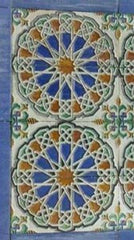 Moorish style of building and ornamentation. Tiles with geometric patterns, rounded arches shaped like a horseshoe, elaborately carved plasterwork and wooden ceilings with geometric patterns of stars are some of the common elements. A peek into the foyer of a building, called Zaguan, will usually reward you with a glimpse of old tiles on the wall, from the floor to about shoulder height. More often than not they will be mudejar style, imitating the elaborate cut mosaics of the moors. Other homes have tiles made in the gypsy barrio of Triana sporting baroque swirls of flowers in bright colors. Recently, tiles manufactured before the 60’s have been declared a civic treasure and were added to a list of protected elements that reflect the customs and traditions of the city.
Moorish style of building and ornamentation. Tiles with geometric patterns, rounded arches shaped like a horseshoe, elaborately carved plasterwork and wooden ceilings with geometric patterns of stars are some of the common elements. A peek into the foyer of a building, called Zaguan, will usually reward you with a glimpse of old tiles on the wall, from the floor to about shoulder height. More often than not they will be mudejar style, imitating the elaborate cut mosaics of the moors. Other homes have tiles made in the gypsy barrio of Triana sporting baroque swirls of flowers in bright colors. Recently, tiles manufactured before the 60’s have been declared a civic treasure and were added to a list of protected elements that reflect the customs and traditions of the city.
On my way to school in the morning, people are already starting their day. At one end of the alley, the cobbler is starting on today’s repairs, sitting in a dark hole-in-the-wall shop on a low stool sewing the shoes by hand. Housewives and shop keepers are washing windows, polishing marble steps and wiping down window sills, sloshing the dirty soapy water over the sidewalk in front of their space to clean it as well. The fish shop is open in the morning, a small room completely tiled in plain white tiles, fresh fishes and shellfish displayed in trays of crushed ice.
Taking the back way, the way with less traffic, I pass by three immensely tall marble pillars left from a temple built by the Romans. The other pillars have long been gone, some removed to decorate a park on the other side of town, others taken perhaps to use in building a palacio somewhere. The Plaza Alfalfa, once the site for a Roman Forum, then later a market-place for selling hay for feed, is now host to a pet market on Sundays. Vendors there sell any sort of bird imaginable as well as a few dogs, cats and rabbits. There is also a few pieces of an aqueduct, built by the Romans then restored by the moors, along a busy road on the way to the train station.
There are traces of the moors every where in Sevilla as well. One of the most famous symbols of the city was built by them, and that is the bell tower of the cathedral, called the Giralda. Throughout history it was typical that a conquering people would destroy the religious centers of the vanquished and build a larger one in its place. And so it was in Sevilla too, that after the Christians reconquered the city from the moors, they built a grand cathedral where the mosque once stood. The Giralda was once the minaret of the main mosque, with a weathervane that the Christians stuck on top. The huge revolving statue of a woman is supposed to represent Faith and is called the Giraldilla. (you might note that it is rather curious that a supposedly constant Faith would turn with the four winds…). The climb to the top of the Giralda is surprisingly easy, since there is a shallow ramp that winds all the way to the top. The story is that the king Fernando would ride his horse up the ramp for the view after the conquest in the 1200’s. The Giralda is still the tallest tower in town, and can be seen from a long way. One interesting fact is that the cathedral to this day is the third largest cathedral in the world, in a gothic style with a huge rose window and double flying buttresses, and is home to the tomb of Christopher Columbus.
from the moors, they built a grand cathedral where the mosque once stood. The Giralda was once the minaret of the main mosque, with a weathervane that the Christians stuck on top. The huge revolving statue of a woman is supposed to represent Faith and is called the Giraldilla. (you might note that it is rather curious that a supposedly constant Faith would turn with the four winds…). The climb to the top of the Giralda is surprisingly easy, since there is a shallow ramp that winds all the way to the top. The story is that the king Fernando would ride his horse up the ramp for the view after the conquest in the 1200’s. The Giralda is still the tallest tower in town, and can be seen from a long way. One interesting fact is that the cathedral to this day is the third largest cathedral in the world, in a gothic style with a huge rose window and double flying buttresses, and is home to the tomb of Christopher Columbus.
I have mentioned some of the food typical of Sevilla; I often speak of tapas. For us, four plates of tapas is a cheap and easy lunch for both of us and usually costs 2 euros or less per plate. Add a small glass of beer each and we’re happy. They are small snack-sized plates of food, such as some mushrooms baked with garlic, potato salad with aioli (garlic mayonnaise), a slice of Tortilla Espanola (sort of a thick omelet with onion and slices of potato) or 3 or 4 Croquetas (these are hard to describe; they’re sort of a thick gluey béchamel sauce, formed into a ball and deep-fried). A plate of Paella is popular; saffron rice with a variety of shellfish, chicken, meats, or sausages thrown in. The pork is very good here and we particularly like the filets of pork with Roquefort sauce. The mainstay of Andalucian cooking though, is the bewildering variety of fishes and shellfish that are deep-fried and served with a lemon wedge; Calamari or its bigger cousin the Choco, all sizes of shrimp from the tiny Camarones to the biggest ones, the Cigala (these look like crawfish – not sure if they are, though). Fried sardines are plentiful as are Pijotas, little fishes that suffer the indignity of being fried with their tail in their mouth. Then there are the larger fish but these are usually served as a dinner and not for tapas. There are so many varieties of fish I can’t even begin to remember them! Sometimes it seems as if all the food here is deep fried, and it can be difficult to get your RDA of vegetables. Gazpacho is a very nice change from fried food; a thick, cold tomato and cucumber soup with garlic and sometimes bread in it to thicken it up. Oh, and before I forget, it is now the season to eat caracoles; tiny snails in a garlic broth and sucked out of the shell or pried out with a toothpick, many of the bars have signs out announcing the availability of caracoles. Surprisingly, the Spanish in general do not eat spicy food.
One night, after a flamenco show, we went to a bar called “El Rinconcillo” (the little corner) with some friends. This is one of the oldest bars in Sevilla and they claim to have started the whole tradition of tapas. Tapas literally means “lids” and were supposed to have evolved from little saucers of goodies served on top of a glass of beer. It is a charming place, with mudejar tiles on the walls and on the bar; ornate woodwork shelves displaying the wines and liquors, and huge barrels in the corners for setting drinks on. A tile on the wall states the founding date of the bar (1670, about 20 years after 1/3 of the population was killed by the plague). The bartenders keep track of each party’s tab by writing the totals on the wooden surface of the bar with a white grease pencil; a tab paid up is then erased from the bar with a quick swipe of a wet rag.
Of course, we saw some really good flamenco shows, some of them were arranged through the school. We also hung out a lot at a bar very close to our apartment, practically around the corner where we could see flamenco after midnight for free at a place called “La Carboneria”. Once a coal-yard, it is now kind of notorious among the flamenco crowd and is often crowded with tourists and aficionados and the air thick with cigarette smoke.
Southern Spain loves to party and after the somber week of penitence of semana santa, 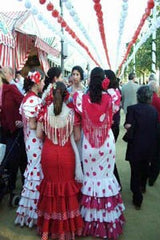 comes the most famous party of all, Sevilla’s Feria de Abril. A week long celebration dating back a couple hundred years, the women all dress up in “flamenco” dresses, put a huge flower in their hair and go to the feria to see and be seen in the latest fashions. This year’s dresses feature huge polka dots and are tightly fitted down to about mid-thigh where the skirt flares out into a profusion of ruffles, creating a graceful silhouette a bit like a champagne glass inverted. The teen-aged girls look especially beautiful, the dresses flattering their thin figures, with fancy combs and flowers in their hair. The fair grounds are fitted out with many “casetas”, this year numbering somewhere around 300. Each caseta, starting out as a tent, is elaborately decorated with fabric and lace, flowers and paintings, paper lanterns with tiny lights inside, tables and chairs plus a sound system and a dance floor to dance the traditional “Sevillanas”. The streets of the fairgrounds are packed with people as are the public casetas; in Sevilla, 95% of the casetas cannot be entered by the public as they are sponsored by wealthy people or businesses and admit people by invitation only. Those who have no invitations must squeeze into one of the municipal casetas where they can buy a glass of manzanilla (dry sherry), some fried fish or fried peppers, or a rebujito, a traditional drink for feria which is manzanilla cut
comes the most famous party of all, Sevilla’s Feria de Abril. A week long celebration dating back a couple hundred years, the women all dress up in “flamenco” dresses, put a huge flower in their hair and go to the feria to see and be seen in the latest fashions. This year’s dresses feature huge polka dots and are tightly fitted down to about mid-thigh where the skirt flares out into a profusion of ruffles, creating a graceful silhouette a bit like a champagne glass inverted. The teen-aged girls look especially beautiful, the dresses flattering their thin figures, with fancy combs and flowers in their hair. The fair grounds are fitted out with many “casetas”, this year numbering somewhere around 300. Each caseta, starting out as a tent, is elaborately decorated with fabric and lace, flowers and paintings, paper lanterns with tiny lights inside, tables and chairs plus a sound system and a dance floor to dance the traditional “Sevillanas”. The streets of the fairgrounds are packed with people as are the public casetas; in Sevilla, 95% of the casetas cannot be entered by the public as they are sponsored by wealthy people or businesses and admit people by invitation only. Those who have no invitations must squeeze into one of the municipal casetas where they can buy a glass of manzanilla (dry sherry), some fried fish or fried peppers, or a rebujito, a traditional drink for feria which is manzanilla cut with some 7-up.
with some 7-up.
It all started on a Monday night at midnight, when they officially opened the feria by turning on the thousands of light bulbs that decorated the gateway to the fairgrounds. Every afternoon you could see nicely dresses people strolling through town on their way to feria; gorgeously dressed women in ruffles, men in suits, baby girls pushed in strollers framed by the ruffles of their dresses. Those who could, would hire a horse and carriage and ride in style, glass of manzanilla already in hand. Sometimes in the mornings on the way to school I would see people just coming home from feria. Needless to say, not much work gets done during this week and the shops all close in the afternoon.
May 25, 2003
Sunday morning, leaving Sevilla. I am sad to leave our apartment but Mike is anxious to do some riding and we have new adventures ahead. We had arranged 5 nights in 5 different paradors and were looking forward to staying in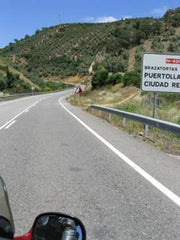 them. One last quick check of e-mails, café con leche and tostada for breakfast and we are on the road early, afraid that the sun will get too hot for comfort.
them. One last quick check of e-mails, café con leche and tostada for breakfast and we are on the road early, afraid that the sun will get too hot for comfort.
It is cooler than usual though, and soon we are riding through a landscape of rolling hills and fields of grain as far as the eye can see. There are fields of sunflowers, too, some starting to bloom already and groves of olive trees polka-dotting the landscape. After passing Cordoba, we started north to ride through a wilder area, with pine trees and rocky hills. Scents of pine and lavender and beeswax fill the air as it gets cooler, cool enough for us to stop and dig our heated liners out of our bags and put them on. The road has few cars on it but nonetheless, a police car appears from nowhere to ask if we need any help.
Our lodging for the evening was the parador in a town called Almagro, south of Madrid. Almagro turned out to be a sleepy small town of typically Spanish stone houses with graying whitewashed walls and an assortment of churches. We walked into town to look around and discovered a Plaza Mayor, the main square, left over the middle ages with its columned 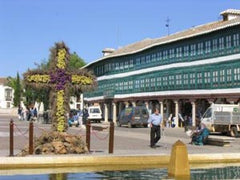 arcades and living quarters in the two upper stories, the windows surrounded by wooden lintels painted dark green. The ground floor was populated with bars, restaurants, and shops with hand-made bobbin lace as the town is an old lace center; women still bring their home-made lace in to the numerous lace shops to be sold. I admired the lace and the lacemaking tools for sale there and bought a couple of ornate hand-carved bobbins for my collection. A recently restored theater was open for a visit so we wandered in and found ourselves in a quaint little auditorium that could have been contemporary of Shakespeare. Some actors were practicing a scene from a play and we sat in one of the upper galleries enjoying the antique ambience, the low overheads, the oil lamps. We went into a shop selling local specialties and bought a bottle of the local wine to try, at 4 euros. Another local specialty seems to be small eggplants, colorless from being pickled in some sort of brine, and canned in either glass jars or in dented metal cans. We decided to pass on trying them.
arcades and living quarters in the two upper stories, the windows surrounded by wooden lintels painted dark green. The ground floor was populated with bars, restaurants, and shops with hand-made bobbin lace as the town is an old lace center; women still bring their home-made lace in to the numerous lace shops to be sold. I admired the lace and the lacemaking tools for sale there and bought a couple of ornate hand-carved bobbins for my collection. A recently restored theater was open for a visit so we wandered in and found ourselves in a quaint little auditorium that could have been contemporary of Shakespeare. Some actors were practicing a scene from a play and we sat in one of the upper galleries enjoying the antique ambience, the low overheads, the oil lamps. We went into a shop selling local specialties and bought a bottle of the local wine to try, at 4 euros. Another local specialty seems to be small eggplants, colorless from being pickled in some sort of brine, and canned in either glass jars or in dented metal cans. We decided to pass on trying them.
The parador was built in the 16th century as a Franciscan convent with the rooms arranged around 4 quiet courtyards. The room we had was nicely furnished, TV, mini-bar and marble bathroom. Surely nicer than anything the nuns had in the old days! We wandered around the grounds and found a bar and ordered some cafés con leche and a local specialty called Migas. Migas turned out to be and interesting peasant dish of fried breadcrumbs with garlic and small bits of bacon in it. The seating area inside the bar had three or four large terra-cotta objects in a row that looked like large wells with wooden covers four feet across. When we asked what they were, the bartender said they were called Tinajas and invited us to go down the stairs to see the rest of it. The tinajas turned out to be enormous amphorae, straight out of Greek or Roman times; oval shaped body with a point at the bottom, a wide body tapering to a small opening. These amphorae were tall enough to rest its pointed end on the floor of the lower story and the mouth to protrude about 3 feet above the level of the upper floor. They were once used for storing wine and now, the bartender joked, they put bad customers in them…(Oh Ha, Ha!)
We walked back into town with an American couple we met at the parador; from Chicago, they are also avid bikers and travelers and we found much in common. They had hoped to travel to China this year, but just after they had booked their trip the news of the SARS virus broke and they quickly changed their plans. We had shared conversation and our cheap bottle of wine with them; the wine turned out to be drinkable although not destined to be one of the great wines of the world. We decided to go to get some dinner together at 9pm before the restaurants closed for the evening, noting that the restaurant hours are much earlier here than in Sevilla. Upon reaching the plaza mayor we were surrounded by a group of pre-teen girls holding water balloons and seeming almost frantic for attention; Mike tried to communicate with them in Spanish while they all swarmed around him shouting at the same time trying to be heard above the shouts of their friends. Dinner turned out to be a bit disappointing and was more expensive than we expected, much more than it would have cost in Andalucia.The next morning on the advice of the people at the parador, we headed out across a vast flat plain with ripening grain with a steady wind to keep us alert. The road rose gradually until we found ourselves in a town called Campo Del Griptana set on a ridge crowned with about a dozen old windmills straight out of Don Quixote; white-washed round stone towers  topped with a conical roof and the framework of four wind blades missing their canvas covering. The steady wind on the hill certainly justified the existence of the mills. The ride was pleasant, if on the cool side, but the sun was shining and we always had our heated gear if need be.
topped with a conical roof and the framework of four wind blades missing their canvas covering. The steady wind on the hill certainly justified the existence of the mills. The ride was pleasant, if on the cool side, but the sun was shining and we always had our heated gear if need be.
The parador for the next night was in Cuenca east of Madrid, and was another 16th century convent set on a rocky peak above a gorge. Larger than the convent in Almagro, it has a large sunny courtyard surrounded by arched cloisters on all four sides and a maze of corridors leading to the rooms (Mike jokingly asked if there was a map to our room). Our room, nicely furnished as you would expect, had a lovely view of a farm way down in the bottom of the gorge and a wall of stone facing our window. On the other side of the gorge, and dwarfing the convent is the old town of Cuenca, built on a high cliff of buff-colored rock. Its houses and churches are built of the same color stone, right up to the edge of the cliff giving them the appearance of having grown there out of the rock itself. Some charming houses built in the middle ages have balconies that jut out over the gorge, justifying the name of “the hanging houses” and are a symbol of the town. We walked across a narrow metal pedestrian bridge that links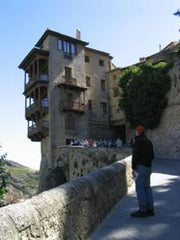 the parador to the town and discovered that the city is built on a narrow wedge of land with deep gorges on either side, the remains of a once Moorish castle at one end to defend the city
the parador to the town and discovered that the city is built on a narrow wedge of land with deep gorges on either side, the remains of a once Moorish castle at one end to defend the city
The staff at the parador gave me a very interesting little booklet with the history of the parador and the town. It is a jumble of wars and rebellions, successive waves of peoples who overcame by force and settled there only to be replaced. It had been populated in the Neolithic times, and the Romans recorded that there had been Celtic peoples there before them. The keep of the Arab castle was converted by the Christians into the first prison the serve the Holy Inquisition. Napoleon’s troops destroyed the town by fire during a French invasion because of the resistance of the rebellious population.
We went down to the bar for some coffee at the parador after our walk, so that Mike could work on e-mails, then we went back to the room to get our jackets to walk into town for dinner. As we passed the bar on the way out, the bartender called to us and motioned for us to come back. He asked if the bike outside belonged to us and when we said yes, he 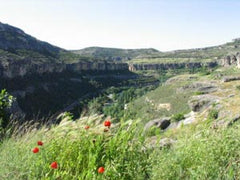 excitedly said (in Spanish), you won’t believe this, but I also own a GTS! Now, if you knew that there were only about 2000 GTS’s ever made, you would understand how incredible it is that we keep running into people who own them...He and Mike spent a happy hour talking about the bike and their experiences and exchanged e-mail addresses promising to keep in touch.
excitedly said (in Spanish), you won’t believe this, but I also own a GTS! Now, if you knew that there were only about 2000 GTS’s ever made, you would understand how incredible it is that we keep running into people who own them...He and Mike spent a happy hour talking about the bike and their experiences and exchanged e-mail addresses promising to keep in touch.
In the morning I went back to the bridge, to take some more pictures in the morning sun. Mike stayed behind on solid ground because the sheer height of the bridge and the seemingly flimsy wooden planks of the bridge made him too nervous to cross one more time!
May 27, 2003
Leaving the parador at Cuenca, we drove along the river at the bottom of the gorge, a beautiful leafy green drive. We took a winding road with little traffic up into the mountains with beautiful panoramas of green fields of grain and red brick soil. We were getting low on gasoline though, and there weren’t very many villages on this section of road. One village we went through had no gas at all so we followed signs to a place called Enchanted City. It turned out to not to be a city at all, but an interesting area with huge square blocks of stone laying here and there on the ground and with a good sense of imagination one could imagine a city turned to stone. Two men were standing by a small snack bar by an admission gate so we asked them where we could get gas. We had to go back to Cuenca, they said, and just before you get there, there is a village with a gas station. Showing us on the map where we were, we realized that we had taken the wrong road out of Cuenca anyway, so we turned back to find gas. No problem, it was a beautiful day, a beautiful road and the ride was worth it. That’s why we’re out here anyway, isn’t it?
The rest of the drive was pleasant too, through narrow piney gorges, astonishingly red soil and stone cliffs, and a succession of small villages. Most of the villages had benches in the shade facing the only road in town, where a few old men would be sitting, chatting, watching the cars go by or drowsing in the warm afternoon. We stopped in one such town, where an old woman in a bar made some enormous sandwiches for us; we took them across the street to a small park commemorating the Spanish armada to eat. Getting back on the bike after finishing our lunch, I saw the old woman slip out of the bar to resume her spot on the bench…
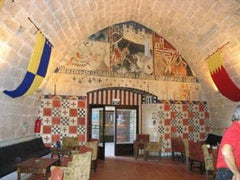 The parador in Alcañiz was formerly a small, somewhat plain castle on a hill dating from the 12th century with a façade built in the 18th century. In the last 8 centuries it had been used as a home, a convent, barracks, a prison and finally a ruin before being restored and made habitable again as a luxury hotel. We explored the grounds, what there was of it; stairs that went nowhere, a fresco’d façade of a church in the process of being restored, the outer defensive wall. The bar was in a charming vaulted room with a fresco on one wall depicting medieval life. We had a spectacular view of the countryside stretching out below us, fields grain and red-roofed villages. We ate at the restaurant in the parador that night and chose from a menu of regional dishes that were beautifully prepared.
The parador in Alcañiz was formerly a small, somewhat plain castle on a hill dating from the 12th century with a façade built in the 18th century. In the last 8 centuries it had been used as a home, a convent, barracks, a prison and finally a ruin before being restored and made habitable again as a luxury hotel. We explored the grounds, what there was of it; stairs that went nowhere, a fresco’d façade of a church in the process of being restored, the outer defensive wall. The bar was in a charming vaulted room with a fresco on one wall depicting medieval life. We had a spectacular view of the countryside stretching out below us, fields grain and red-roofed villages. We ate at the restaurant in the parador that night and chose from a menu of regional dishes that were beautifully prepared.
The road to the next parador, outside the town of Vic in the heart of Cataluña, took us through more of the pleasant countryside. Soon we met the river Ebro, dammed to create a long winding lake in the mountains, in an otherwise dry area with sparse pine trees and sage-like ground cover. In the slopes between hills, where there was enough soil to support a tree, we started to see small groves of fruit trees, mostly peaches and cherries. After Lleida we hit the highway, a straight road through a warm and humid industrial area – we’re about 100 kilometers west of Barcelona at this point. I kept my eyes peeled for the road we were to take so we could leave the highway – Mike was getting bored – but our map didn’t show the number of the road so we ended up overshooting the exit we wanted.
Luckily, there was another exit in a few more miles that would take us to the road we wanted and soon we were twisting up a hill between golden fields of grain thick with red poppies. Huge traditional stone farmhouses perched on hillsides overlooking the fields, some large enough to house a small village. We passed through the town of Vic and soon found ourselves in a forest, feeling more remote than I have ever felt in Spain.
The parador sits on a spit of land above a reservoir in the middle of nowhere, and the only sounds are the songs of thousands of birds and the occasional car on its way to the parador. The building itself is a modern one, built in the style of a traditional Catalan Masia or farmhouse. We had a lovely cup of coffee on the deck overlooking the lake, hearing nothing but birdsong, and in the evening had another wonderful meal at the parador since we were so remote from any town. Of the five paradors we stayed in this trip, this was by far our favorite one. The picture to the right is a view of the lake from the parador. We have been told that in the summer, when the water level is low, one can take a boat out into the lake and see a submerged village, flooded when the dam was built. If the water is low enough they say, you can see the steeple of the church sticking out of the water...
The next night was in the parador of Cardona, another castle in the foothills of the Pyrenees. It was a short ride, only 60 miles from the parador at Vic so we arrived early and took the bike down to explore the town. Buildings of dark grey stone line steep gloomy streets of dark grey paving stones, with shops on the street level. Some people are out, shopping or chatting in Catalan but otherwise the town is quiet. Aside from a few small grocery stores, a baker, a butcher, the newspaper/tobacconist and a store selling matronly women’s clothing, there is not much for a window shopper to look at. We returned to the castle after lunch and looked around the castle which was a bit more interesting.
The castle sits on top of a hill with the town spread down the side of the hill outside the walls. It is a proper fortified castle, bigger than the castle in Alcañiz, with towers and crenellations and lookout towers with narrow slits for shooting arrows through, perfect for sparking the imaginations of the three English children running back and forth imagining themselves to be knights of the round table. Our room was a dark, high-ceilinged cave of a room, the single window set about 12 feet off the floor. The earliest phase of construction at the castle was a small, half demolished watch-tower from the second century. The castle was fortified in the 9th century and from there, the castle’s evolution continued for the next 4 or 5 centuries. I climbed up to the top of the watchtower to get a great view of the valley, the town below and a mountain of salt which has been mined since the 2nd century A.D. yielding white and rose colored stones of salt crystal.
After leaving Cardona, we continued north to spend a couple of days in Andorra, a tiny principality in the Pyrenees wedged between Spain and France. It’s a rocky, mountainous country with two principal roads jammed with traffic through the towns. Where there is enough soil to support a crop, we saw freshly planted tobacco seedlings or green pastures with cows. While the principal language of Andorra is Catalan, Spanish and French are also spoken. Lots of foreigners go to Andorra for skiing in the winter, but the main reason to go there in the summer is for duty free stuff like cigarettes, alcohol, perfume, cameras, watches, etc…not to mention the motorcycle shops; you can get all kinds of bike stuff from helmets and gloves to an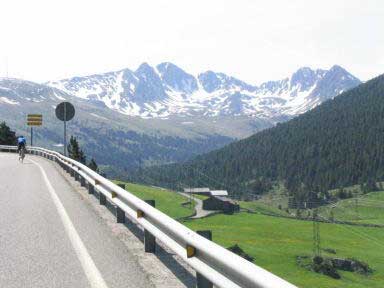 oil change and parts for very competitive prices.
oil change and parts for very competitive prices.
We spent most of a day going from one shop to another looking for some new leathers for Mike. We were marginally successful; we found the perfect leather jacket with lots of zippered vents but, typically, they didn’t have one in his size. We’ll look them up on the internet later and try to get it that way. We wanted to take a ride up high into the skiing area but as we headed out of town it started to rain, big warm drops of water so we ducked into a covered gas station to wait it out. The shower soon tapered off so we headed out and were soon riding through pastureland spotted with white narcissus and yellow daffodils (on the first of June, daffodils?!).
Our hotel was in Soldeu, a small ski town not too far from the French border. The hotel had a nice heated pool, but when we decided to swim in it, we were first required to rent towels and take a shower. Fine, no problem, but as soon as we stuck one foot in the water we were informed that if we wanted to swim we were required by Andorran law to buy a swim cap and cover our hair.
We stopped at an Indian restaurant one night for dinner, and were startled to be greeted by a young woman saying (in English), “Ready for a spot of curry then, are you?”. Chatting with her and other English people dining there, we learned that many English people go to Andorra for skiing and there is a small enclave of English people living in Soldeu.
We met some Dutch bikers in the garage of the hotel, who had trailered their bikes to Andorra on ingenious little motorcycle trailers invented, they said proudly, by a Dutchman. Little more than a frame with space for one motorcycle, it sits flat on the ground so that one person can easily roll a bike onto it. Once the bike is on and strapped down, a hydraulic pump gradually jacks the wheel axels up off the ground and you are then ready to go. (www.vanvossen.nl for the website…). Once at home, the trailer can be folded and stored.
The next evening, going to dinner, we were driving along with a car on our tail. Mike kept trying to lose him, but the driver was evidently determined. As we pulled into the parking lot of the restaurant, the car pulled in too, and the people inside rolled down their windows, saying “Mike, is that you??”. It turned out to be a guy Mike had met years ago that lives in Andorra and had once had a GTS too. It is incredible how small the world is sometimes!
June 11, 2003
We have been in southern France now for 10 days and we are having a bit of culture shock. Not to mention sticker shock! At the moment we are in the Massif Central, located somewhere south-central part of France, in a fascinating and beautiful region of volcanoes and green pastures… it is amazingly hot, 42 degrees Celsius in the shade and very humid. (38C is equal to 100F, so 42C is, um, well, Very hot!). My hair is damp from sweat inside my helmet, my arms slick inside my jacket sleeves and my leather pants feel like they are melting in the heat onto my legs. I find myself fantasizing about a Grande, no make that a Venti, iced mocha Frappuccino from Starbucks, beads of icy condensation dripping down the side of….Sorry! got a little sidetracked…
As I said we’re in a bit of a state of longing for Spain; while we enjoy France, we miss the cheap prices for everything and being able to eat as late as you wish. For example, a dinner for both of us in Spain including a bottle of wine would average 15 to 25 Euros, and a café con leche, €.90. You can eat later in the day in Spain, where you would have no trouble finding food as late as 11:30-12:00 at night. Here, in France, often you have to order your dinner between 7:30 and 8:30 or else you will get nothing because everything closes in the evening. This may not seem like a big deal but when you are traveling, your normal routine and mealtimes often get thrown off track and these small windows of time when you can eat makes it a little difficult sometimes. Dinner, chosen off a set menu costs around €15 per person with another €10 thrown in for wine. The fixed price set menu is typically French; you have 2 or 3 choices for a starter, usually 3 choices for a main course dish and a 2 or 3 choices for a dessert. Coffee, though is the real contrast. Since coming back to France, we have been paying an average of €2.20. The other day, we stopped in a town for a well deserved rest and a cup of coffee and was shocked to learn that they wanted €3.50 for it!
The traveling life has its drawbacks too; like the chambermaid knocking on your door at 9AM, waiting to make up the room in spite of the do not disturb sign on the door, the bath towels size of a small hand towel, the hard beds and strange pillows. In France, for some reason, they prefer what Mike and I call a sausage pillow. It is a small, round bolster that goes all the way across the bed. If I try to sleep on it, I spend the next day with my head bent at an unnatural angle. If you try to remove it from the bed you find that the pillow has been rolled up in the top of the sheet instead of using a pillowcase, so you end up un-making the bed! Luckily, you can usually get someone at the front desk to find you one or two “normal” pillows. In France, a large bed is usually what an American would consider a somewhat small “double-sized” bed, but Spain, a “matrimonial” bed is normally 2 narrow twin-sized beds made up separately and shoved together.
I don’t want to leave the impression that I am complaining about all of this. Of course, there are many things to make up for the discomforts of traveling; the people you meet, the beautiful countryside, the different foods and cultures, riding on twisty roads on a motorcycle.
Another fact of life in France is that at any given time there will probably be some group of workers on strike. The French word for strike is Greve and we're getting to know the word very well! At the moment there is a huge strike going on all over the country, and has been going on for at least a month. The country is in an uproar because the French government is planning on pension policy changes and the result is massive protests and work stoppages by civil servants. As we ride through towns we see bags of garbage in piles by the side of the road waiting for pickup. In Carcassonne, the post office doors were open and the workers present but with arms crossed, refusing any transactions. La petit tren, a tourist train that takes a scenic trip through lovely country in the South of France, was also on strike. A hospital with a banner declaring it to be on strike and ambulance drivers, libraries, teachers and museums are also affected in a rotating basis. The Fermeture Exceptionelle, an unexpected closure of a shop or restaurant, is getting to be familiar to us as well. Occasionally, a shop will close its door for a reason as simple as fatigue of the shopkeeper. The motorcycle shop's parts department was closed one day because the guy running the counter had tests that day...In the U.S., there would probably be another person there to cover but that is rare in France, with their labor laws, the 35 hour work week and the high cost of employees. 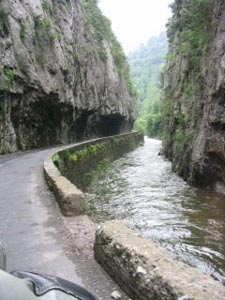
Once we had left Andorra, we descended into France on beautiful, winding roads through the forest and narrow gorges and came into a town called Quillan. We had met a couple from Britain several years ago when traveling through Chiapas. After their trip to Mexico, they bought a house here in Quillan and we were curious to see if they were still there. They were, having fixed up the house and turned it into a Bed and Breakfast. The house is right next to the river Aude, shaded by the cottonwood trees lining the river, and is filled with the soothing sound of rushing water.
While drinking a cup of tea with our friends, the sky started to darken and thunder rolled down out of the mountains. A breeze came up and the drifting bits of cotton from the cottonwood trees floated through the air and into the room as we talked about what we had been up to for the last few years since we saw them. We had seen the house when they first bought it, a dark wreck of a house empty for years; it is now a charming place, bright and comfortable. They had bought a couple other houses in town as well to fix up and seemed to be quite happy there. As we are learning, their story is not so unusual these days, as many foreigners, especially the British and the Dutch, are buying houses in these small villages and renovating them to live in part- or full time. Some of these small villages were slowly dying out as the young people move away to find jobs and the older people die off; it remains to be seen how the culture of these places, which drew the foreigners here in the first place, will change as they start to outnumber the French locals…
The above photo shows a gorge was so narrow that the road builders had to undercut the rock wall in order gain enough space to put two lanes of traffic. However, if the oncoming traffic happens to be a bus or a tourist driving an RV, you'd best believe they don't treat this road as two lanes, but are more likely to be in your lane!
After leaving Quillan, we found a hotel in Carcassonne to stay for a few days and do some day rides through the area. The fortified city with its numerous towers set on top of a high cliff looks like a fantasy city straight out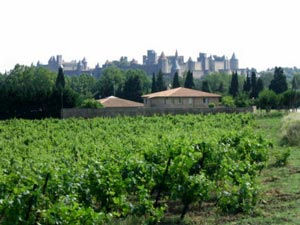 of a book of fairy tales. It is an incredibly picturesque and unique place that remains pretty much as it was in the 13th century and as such, is usually full of tourists. Its cone capped towers with pennants streaming in the breeze are visible for long distances; an intensive renovation project was supposedly funded by Napoleon to restore the city making it look fresh and newly built. In fact, some of the walls are about two thousand years old, built by the Romans and added on to throughout the centuries. The last set of construction was done in the 13th century, when the cannon was invented, making fortresses like this obsolete.
of a book of fairy tales. It is an incredibly picturesque and unique place that remains pretty much as it was in the 13th century and as such, is usually full of tourists. Its cone capped towers with pennants streaming in the breeze are visible for long distances; an intensive renovation project was supposedly funded by Napoleon to restore the city making it look fresh and newly built. In fact, some of the walls are about two thousand years old, built by the Romans and added on to throughout the centuries. The last set of construction was done in the 13th century, when the cannon was invented, making fortresses like this obsolete.
Another section of the city of Carcassonne is called La Bastide, where the locals hang out, sipping coffee in the square, going to the market or conducting business. It is a very quiet place, except for July and August when all the tourists are in town and it becomes quite lively for 2 months. We had heard of a hotel nearby which offers free indoor parking for motorcycles but when we got there it was closed. Fermeture Exceptionelle, a sign on the door said, closed until the 3rd of march. Huh?! A few days later we went back and the hotel had reopened; the woman explained that she was tired and decided to close the hotel for a few days. So tired in fact that she didn’t notice that she had put the wrong month on the sign…We were shocked one day when we asked for a salad for lunch and were told that lunch was over at 1:30 (it was 1:40 in the afternoon) and we’d have to go to the bakery for a sandwich if we wanted food.
In the mornings we would walk to the square to get some coffee and croissants for breakfast where we met a British man who bought a house just outside of town. He told us that Ryan Air recently started offering flights from Britain to Southern France for very low prices, making this area very attractive to vacationers and prospective home-buyers. Looking around, we could see that there were indeed a lot more tourists and non-French people around than is usual for this time of year.
Mike had some work he wanted to do and needed a high speed internet connection, so one evening, we decided to go into La Bastide to the internet site at 10pm. Even though it wasn’t that late, the front door of the hotel was locked! We had been given a code to open the door from the outside but in order to get out, we had to hunt down the manager to get him to turn the alarm system off and unlock the door. The manager seemed a bit grumpy at being rousted so late and incredulous that we would want to go out at such an hour! I tried not to think of what would happen in case of an emergency at night…It had been raining a bit during the day but now the air was fresh and the streets dry so we set off to the internet place.
After Mike finished his work, we walked around a little bit then decided to go back to the hotel since there was nothing open except bars serving only alcohol, when suddenly, it started raining and we had to run for the shelter of an awning. The rain kept coming down harder and harder so we ran across the street where a bank had a foyer with ATM machines and stood behind the glass watching the rain. After a few minutes, we watched the gutters become rivers, then disappear under the water, the roads becoming streams then a rushing river. The sidewalk where we had taken refuge under the awning was now also under water but the bank where we stood behind now steamed-up windows, was still safe high territory. Little by little, the rain storm gradually tapered off and after another 20 minutes or so, the water had receded and we were able to leave our sanctuary and head back to the hotel.
The countryside around Carcassonne is pleasant, with gently rolling hills covered by orderly rows of grapevines as far as the eye can see. Scrubby trees and low plants appear where the ground is too rocky to plant grapes. Pre-historic man lived in these valleys as well, and left cave paintings as evidence they had been there long ago. Looking out over the vines, I sometimes think that the grapes will never end and it boggles my mind to think of the vast amount of wine produced in this area. The grapes here turn out to be a lower quality and make a wine that is much less prestigious than other regions in France, such as Bordeaux for example. The south of France has a character that is unlike the north; part French, part Spanish, part something all its own. We find that many people speak Spanish here, so if we run into trouble communicating we can often get by using some Spanish. The local dialect is Catalan or Occitan which sounds to me like a mixture of French and Spanish. We stopped in a little town for a break and something to drink and Mike saw a wine shop, so he went to check out the local wines. Mike was totally charmed by the two old women in the shop, when asked if they spoke Spanish, the shopkeeper said, “no, Catalan.” Glancing at her companion for confirmation, the second woman also said, “no, Catalan.”, nodding to each other with a smug smile. We bought a few bottles of wine there, including a pretty good Cabernet/Merlot mix for only 3 Euros…
One of the day trips we took was a ride to Narbonne, an important town in the Roman times. It is a pleasant city with a canal running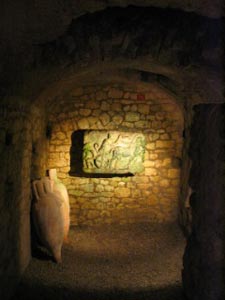 through it, lined with trees and flowers; a 13th century cathedral and archbishop’s palace stand near a square across from modern supermarkets. A small section of the Via Domitia, an important roman road which linked Rome and Spain runs through the middle of the square. We had come here to see what was left of Narbonne in the Roman times so we went to see the Horreum, an ancient underground warehouse. As we descended the stairs into the warehouse, we could feel the temperature drop drastically as if air conditioned. A series of corridors stretched out before us lined with small barrel-vaulted chambers on either side, barely tall enough to stand up in. Some were equipped with empty amphorae or a display of carved stones that had once graced a Roman building. The small cubicles had once held goods for sale in the market above the Horreum; pottery, cloth, olives, wine, casks of oil, etc. Not all of the Horreum has been excavated, but it amazed me that any of it existed still at all!
through it, lined with trees and flowers; a 13th century cathedral and archbishop’s palace stand near a square across from modern supermarkets. A small section of the Via Domitia, an important roman road which linked Rome and Spain runs through the middle of the square. We had come here to see what was left of Narbonne in the Roman times so we went to see the Horreum, an ancient underground warehouse. As we descended the stairs into the warehouse, we could feel the temperature drop drastically as if air conditioned. A series of corridors stretched out before us lined with small barrel-vaulted chambers on either side, barely tall enough to stand up in. Some were equipped with empty amphorae or a display of carved stones that had once graced a Roman building. The small cubicles had once held goods for sale in the market above the Horreum; pottery, cloth, olives, wine, casks of oil, etc. Not all of the Horreum has been excavated, but it amazed me that any of it existed still at all!
The canal I mentioned earlier was originally dug by the Romans; they made Narbonne into a major port city even though the city was about 3 kilometers from the sea. Many interesting artifacts were dredged from the canal and housed in the Musee Lapidaire, Our map showed that it was in a small church not far away. We found it easily and drove around it a couple of times to try to figure out how to get into it, when we finally noticed a small locked wooden door with a small sign with the hours, stating that it was open on Wednesdays only. We looked at each other to confirm that it was indeed Wednesday today and according to the sign, it should be open. We went into a nearby shop to see if they knew anything about it and they just shrugged their shoulders and said, I know nothing about it, perhaps they’re on strike…
Leaving Carcassonne, we rode east for a bit but it was getting so hot that the riding was not much fun in spite of the nice countryside. We ended up staying a night in Nimes, in a hotel room on the edge of town. The main attraction of this hotel room was the air conditioning which we promptly turned on full blast and didn’t leave the room until it was almost dark. As I mentioned at the beginning of this story, it was quite hot that day, and even at 10pm, was still sweaty-hot. One of Nime’s big festivals is the Feria, similar to the Ferias of south Spain complete with bull fights and Sevillanas! The difference in France is that the bull doesn’t get killed; instead, after teasing the bull a while, the bullfighter tries to snatch a ribbon cockade the bull wears between his horns – preferably without getting gored. I hate to say it, but we didn’t go into town to brave the crowds of people to check out the feria, it was still so hot and we wanted to get an early start to head for the mountains and cooler temperatures.
June 16, 2003
We spent some time in Auvergne, a lovely area that had once been the center of intense volcanic activity. A chain of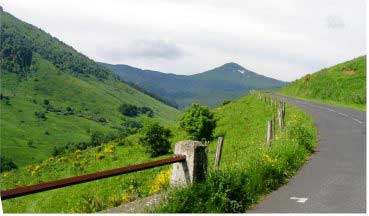 maybe 25 volcanoes stand in a row, cone shaped and covered with green grassy meadows. Subsequent glaciers eroded the lava flows and cones into more gentle shapes. Many of the peaks, called Puys by the locals, rise abruptly into the air as if someone had taken a pinch of green velvet and pulled it into a peak. Other puys have an indented crater at the top as if a giant had put his thumb print on the peak. The tallest of them is called Puy-de-Dome, and is crowned with a modern telecommunications and meteorological center and the remains of a 1st century Roman temple to Mercury. At the top, we had a breath-taking view of nearby hills covered in lush green pastures and wild-flowers in every color you could imagine. An information center has story boards showing the fascinating geological story of the area.
maybe 25 volcanoes stand in a row, cone shaped and covered with green grassy meadows. Subsequent glaciers eroded the lava flows and cones into more gentle shapes. Many of the peaks, called Puys by the locals, rise abruptly into the air as if someone had taken a pinch of green velvet and pulled it into a peak. Other puys have an indented crater at the top as if a giant had put his thumb print on the peak. The tallest of them is called Puy-de-Dome, and is crowned with a modern telecommunications and meteorological center and the remains of a 1st century Roman temple to Mercury. At the top, we had a breath-taking view of nearby hills covered in lush green pastures and wild-flowers in every color you could imagine. An information center has story boards showing the fascinating geological story of the area.
We stayed for a few days in a town called Murat. It is an old town of medieval grey stone houses roofed with flat stones shaped by hand into scalloped shingles. Here we were able to try some of the local foods and drinks. Salers, named after the town of the same name, is a golden-yellow aperitif which is sweet and bitter, made from a yellow gentian flower that grows here. Aligot is a local cheese and is prepared by mixing pieces of cheese into hot mashed potatoes, left to melt then seasoned with garlic and the juice from grilled sausages. The resulting dish is also called Aligot and is like flavorful but chewy mashed potatos – melted aligot cheese can stretch six to ten feet when pulled with a spatula! It’s just the sort of dish I imagine was a favorite of generations of Avergne children. Truffade is another cheese and potato dish, but instead of potato puree, it’s made with chopped potatos, then fried. Pork dishes are common, like the boiled pork with cabbage called Potee, or the Auvergne-style cured hams. Pounti is a sort of light, fluffy meatloaf with bits of cured ham, pork breast, prunes and beet leaves. This region is also famous for a green lentil that has been farmed here since Roman times. They say that the volcanic soil gives the lentils a very special flavor. And for dessert, once could choose a tart made from wild blueberries or a walnut cake…
On a day trip exploring the area we took a nice ride that took us through a gorge that opened up into a reservoir of water. The Viaduct du Garabit spanning the gorge was designed by Eiffel; the lofty metal arch of the viaduct with its lacy framework is typical of his work. Small roads meandered their way through leafy forests and past lakes and streams. We came to a small town where we saw a group of bikes parked and we suddenly realized that it was past lunch time and we hadn’t eaten yet. Not in the mood for a full-blown French lunch, we went to a bar where we asked if we could get a sandwich. Yes, the woman said and responded with a list of ingredients when we asked what kind of sandwiches she had. “A baguette with cheese”, she said, “York ham or country ham, pate or Tuna”. We asked her to make us a York ham and cheese sandwich to split, please, with two coca-colas. Wrinkling her brow she repeated dubiously, “york ham and cheese? On the same sandwich??” Yes, we said and settled back to await our lunch. When the sandwich arrived, I opened it up to see how she had made it and discovered that she had put the ham on one end of the baguette and thick slices of cheese on the other. Bursting into laughter, we rearranged the sandwich and she left shaking her head. The rearranged sandwich, by the way, tasted delicious with the flavorful white ham and creamy Cantal cheese. And I am still unsure why the concept of ham and cheese on the same sandwich was so strange to her, as it is quite common everywhere…
Saint-Flour is a nice little town with the upper village built on a basalt outcropping. A panoramic viewpoint affords a view of the lower village far below, picturesque with a pointed church steeple and arched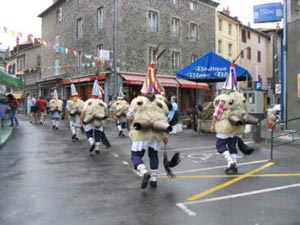 bridges over the river that curves through town. We happened to be passing through the upper village one day when we noticed a fete going on so we parked the bike to investigate. It was called the Fete of the High Lands and they had invited some special guests from the Basque lands. A huge tent had a photo exhibit featuring old photos of Auvergne life and music, focusing especially on players of the bag-pipe, which has been played here at least since days of the troubadours of the middle ages. Tables with CD’s of local music and handmade instruments were for sale as well; elaborately decorated hurdy-gurdies, lutes, guitars and many other strange and beautiful instruments I had never seen before. I was distracted from the instruments by a strange jangling sound. A group of oddly-dressed men were assembling, wearing funny cone-shaped hats with ribbons and a comical tuft of feathers attached at the top, and sheepskin vests with four large cow-bells attached at their back. As I watched, they formed into a line, two-by-two and took off down the street with an odd, bouncy but heavy walk which made their bells clank loudly. As they paraded through town, they swished the horse tail whisks in their hands and when they came to a plaza they would circle it in single file once or twice before resuming their route or reverse direction for a few yards before turning back to continue in the same direction. The leader would occasionally blow a long blast on the cows' horn he carried. I followed in fascination, feeling like I was watching an ancient ritual of purification, of scaring away the evil spirits. I later asked the woman at the information desk who they were and why they were doing what they were doing, and she told me that they were Basque but beyond that she had no clue why they were wearing bells. Oh well, I was safe in my fantasy…The route we took passed tables of locally produced items; honeys and jam, spice cake, handmade baskets, tables heaped with ruby red cherries, baked breads, pastries, cured sausages and cheese. A few vineyards had tables also with samples of their wines from the Saint Pourçain wine region. A group of violinists of various ages played simple folk tunes while some women set out cups with a small amount of Salers liquor to taste. As I mentioned earlier, it has quite a bitter, medicinal aftertaste so after the first minute sip, we discretely looked for a place to throw away the rest so as not to offend…
bridges over the river that curves through town. We happened to be passing through the upper village one day when we noticed a fete going on so we parked the bike to investigate. It was called the Fete of the High Lands and they had invited some special guests from the Basque lands. A huge tent had a photo exhibit featuring old photos of Auvergne life and music, focusing especially on players of the bag-pipe, which has been played here at least since days of the troubadours of the middle ages. Tables with CD’s of local music and handmade instruments were for sale as well; elaborately decorated hurdy-gurdies, lutes, guitars and many other strange and beautiful instruments I had never seen before. I was distracted from the instruments by a strange jangling sound. A group of oddly-dressed men were assembling, wearing funny cone-shaped hats with ribbons and a comical tuft of feathers attached at the top, and sheepskin vests with four large cow-bells attached at their back. As I watched, they formed into a line, two-by-two and took off down the street with an odd, bouncy but heavy walk which made their bells clank loudly. As they paraded through town, they swished the horse tail whisks in their hands and when they came to a plaza they would circle it in single file once or twice before resuming their route or reverse direction for a few yards before turning back to continue in the same direction. The leader would occasionally blow a long blast on the cows' horn he carried. I followed in fascination, feeling like I was watching an ancient ritual of purification, of scaring away the evil spirits. I later asked the woman at the information desk who they were and why they were doing what they were doing, and she told me that they were Basque but beyond that she had no clue why they were wearing bells. Oh well, I was safe in my fantasy…The route we took passed tables of locally produced items; honeys and jam, spice cake, handmade baskets, tables heaped with ruby red cherries, baked breads, pastries, cured sausages and cheese. A few vineyards had tables also with samples of their wines from the Saint Pourçain wine region. A group of violinists of various ages played simple folk tunes while some women set out cups with a small amount of Salers liquor to taste. As I mentioned earlier, it has quite a bitter, medicinal aftertaste so after the first minute sip, we discretely looked for a place to throw away the rest so as not to offend…
Our tires are starting to show signs of wear with all the riding we are doing so we stopped at a large bike shop in the town of Issoire. They had the tire and proceeded to do the work of taking the old tire off when the mechanic called Mike over to look at something. The nuts holding the front wheel on had been put on backwards by the last person who had mounted the tire! The last shop to have done work on the bike was the large Yamaha shop in Sevilla! It is mind-boggling to think that a professional shop would have put the tapered nuts on with the wide end facing out… in any case, the new tire was put on without a hitch 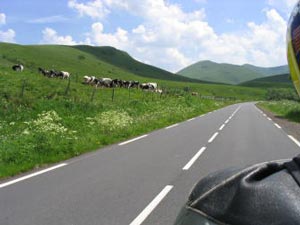 and we discussed whether or not the back tire should also be replaced. It was getting close but not bad, so we arranged to come back in one week, on a Monday. “You’ll have the tire we need on Monday, right?” yes. “You’ll be here on Monday, right?” yes. “The shop will be open on Monday, right?” yes, yes.
and we discussed whether or not the back tire should also be replaced. It was getting close but not bad, so we arranged to come back in one week, on a Monday. “You’ll have the tire we need on Monday, right?” yes. “You’ll be here on Monday, right?” yes. “The shop will be open on Monday, right?” yes, yes.
In a week’s time we’ve put on a lot more miles on the bike. Fully loaded with our bags and both of us, the tires wear out quickly because they are made of a softer material designed to grip the road. We still have some miles left on the tire but the shop seems very competent so on Monday around 11AM we’re back at the door of the shop. The lights are out and no one is parked in the parking lot. A sign on the door says, “Fermeture Exceptionelle today, until 6PM…Oh well, we are due back in Paris in a few days and can wait to change the tire there.
June 17th, 2003
One evening we were looking for a place to stay when we entered a small, plain 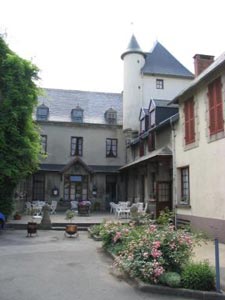 village called St. Gervais. Most of the few hotels in town looked run-down or closed and we were about to give up on the town when we spotted a sign for Castel Hotel 1904. Driving around the corner, we spotted a beautiful building with a small tower and vine covered walls which turned out to the hotel. Crossing a flowery patio, we entered a foyer where the reception desk sat, next to the fireplace displaying the date of 1616. We soon had a nice room - named Adelaide - for 60 Euros, overlooking a shady garden and furnished with furniture from the 20’s or so. Although it is not a big hotel, it has two restaurants. The “gastronomic” restaurant serves what we would consider “gourmet” food, but was closed the days that we were there. The regular restaurant had a fixed price menu and we had a really nice meal there for about 15 Euros. We were in love and decided to stay for a few days. It is not budget priced but we felt it is a very good value for the money. Not surprisingly, this hotel is listed in a book of French Hotels of Charm. We went into town and had coffee at a smart little café and from where we were sitting we could see lots of closed-up buildings abandoned for many years, and for sale signs. Occasional houses show signs of loving attention; fresh paint on the shutters, lace curtains and on the sidewalk, bright geraniums spilling over the sides of their pots. An odd little stone arch with a wooden gate opened onto a weedy garden. An interesting building with a rounded tower looked well-kept but the shutters were latched tightly closed and it was hard to tell if it was still being lived in. We stopped by a real estate office to take a look at
village called St. Gervais. Most of the few hotels in town looked run-down or closed and we were about to give up on the town when we spotted a sign for Castel Hotel 1904. Driving around the corner, we spotted a beautiful building with a small tower and vine covered walls which turned out to the hotel. Crossing a flowery patio, we entered a foyer where the reception desk sat, next to the fireplace displaying the date of 1616. We soon had a nice room - named Adelaide - for 60 Euros, overlooking a shady garden and furnished with furniture from the 20’s or so. Although it is not a big hotel, it has two restaurants. The “gastronomic” restaurant serves what we would consider “gourmet” food, but was closed the days that we were there. The regular restaurant had a fixed price menu and we had a really nice meal there for about 15 Euros. We were in love and decided to stay for a few days. It is not budget priced but we felt it is a very good value for the money. Not surprisingly, this hotel is listed in a book of French Hotels of Charm. We went into town and had coffee at a smart little café and from where we were sitting we could see lots of closed-up buildings abandoned for many years, and for sale signs. Occasional houses show signs of loving attention; fresh paint on the shutters, lace curtains and on the sidewalk, bright geraniums spilling over the sides of their pots. An odd little stone arch with a wooden gate opened onto a weedy garden. An interesting building with a rounded tower looked well-kept but the shutters were latched tightly closed and it was hard to tell if it was still being lived in. We stopped by a real estate office to take a look at 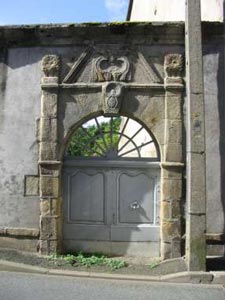 the offerings and were told by a Dutch realtor that this area was the next “Eldorado”(!).
the offerings and were told by a Dutch realtor that this area was the next “Eldorado”(!).
Back at the hotel, by chance, Mike ran into a pair of older French gentlemen, locals, who spoke excellent English. They explained that they had both worked in America before retiring – one for Massey-Ferguson and the other for Alcoa – and are now living here in St-Gervais. Guy was married to a woman from town – a cousin of the family running the hotel and was actually born here right in that room, he explained, pointing up at the hotel. After retiring, Paul decided to move back to St-Gervais with his wife and live in the house that his Grandfather built. “People say it’s like a museum”, he said. We sat and chatted for a long time until we noticed the time; if we didn’t go eat dinner now we wouldn’t get anything. We agreed that they would come pick us up after dinner and go to Paul’s house for a cup of tea. Over a bowl of tea (the traditional French way!) in the flag-stoned kitchen, we learned a lot about the town and the history of the area; how the tower house used to have rabbits living at the base of the tower, the chateau which used to be nearby and how all of the stones were taken away, many to build people’s homes, how the strange little stone arches probably came from the chateau. Mike told them he was interested in perhaps buying a house in France and they told us that the St-Gervais was not a good place for us – too cold in the winter and hot in the summer…better to try an area south east from here. We asked about the café we had gone to earlier – we had wanted to get a coffee one afternoon but it was unexpectedly closed. They told us it was run by a couple from Paris; they had no experience in running a café but decided to retire to the country and open a bar. If they don’t have customers or don’t feel like being open, they will often lock up and go home or go fishing.
Nearly every town or village we pass through has its own requisite monument to World War I with a plaque listing the names of the fallen villagers. Addendums were added after World War II and the war in Algeria. Mike has always wondered why the monuments never seemed to show any damage, so he asked Paul why the Germans never tried to destroy or deface the monuments during the war. "Good question", Paul answered. I guess it's a matter of speculation why but Paul thought it was because the Germans had respect for them. Paul told us that the worst damage they ever caused was to take the metal decoration or statues, if any, to melt down. The Germans actually only visited the area 2 or 3 times, Paul said, because there were so many places for French guerilla fighters to hide.
Before leaving, Paul showed us to his tiny living room, furnished by simple antique furniture and dominated by a large fireplace, and proudly showed us a new computer with which he promised he would keep in touch through e-mail.
With all the old volcanoes in the area it’s no surprise that there are so many towns with natural hot springs and thermal spas. We stopped one afternoon to have some coffee in a town called Chaudes-Aigues (pronounced something like shod-zeg, meaning hot water in medieval French) where a small fountain gushes water at 82C, the hottest springs in Europe. A cloud of steam attested to the heat of the water - on the Celsius scale, water boils at 100 degrees. We amused ourselves by watching the town square fill with British and French Morgans; it was a rally, and consisted of twenty nine old Morgan cars and one Lotus 7. We also stopped in Mont-Dore one day – briefly – where we had the afore-mentioned 3 Euro coffee. High prices and tour busses full of tourists soon had us moving on.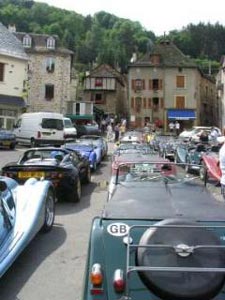 Chatel-Guyon is an elegant spa-town, built at the turn of the century when “taking the waters” was fashionable and was often visited by royalty and other famous figures. Unfortunately we were on our way through and didn’t have time to explore the town beyond gaping at some of the beautiful art-deco buildings as we cruised past them. We will definitely have to come back some time.
Chatel-Guyon is an elegant spa-town, built at the turn of the century when “taking the waters” was fashionable and was often visited by royalty and other famous figures. Unfortunately we were on our way through and didn’t have time to explore the town beyond gaping at some of the beautiful art-deco buildings as we cruised past them. We will definitely have to come back some time.
Vichy is without a doubt the most famous of all the spa towns. Napoleon III regularly came here for the spas and was responsible for transforming the town into a mini version of Paris, with a grand opera hall, lofty pavilions, casinos and Haussmann style architecture. A promenade runs along the river and Napoleon’s villa sits at one end of the park. A row of officer’s houses lines a nearby street and features some very eclectic architecture. The town has suffered a decline since Napoleon’s time, though. In the 1880’s there were some 280 hotels, but today there are only 60 and from what we could tell walking around town, maybe half of these were closed. Once grand hotels sit empty or are now residences for elderly people. Once chic stores now sell orthopedic shoes and walkers. It is hot here, too and after a night of tossing and turning in a smotheringly hot room, we decided to head back to Paris.
==============================================================
Castel Hotel 1904 can be found in the town of Saint-Gervais d'Auvergne. I don't have the address, but it's not a big town and there are signs pointing travelers to the few hotels in town. You can find their website at www.castel-hotel-1904.com .
July 2nd, 2003
Back in Paris, it’s still warm but tolerable. Our plans are to stay in Paris for a few days then head east towards Alsace-Lorraine and Germany. We have some friends to visit and some business to take care of. I am looking forward to reorganizing my motorcycle bag; it has gotten too heavy and I need to store some of the stuff I have collected along the way. We have to take the paperback books we have already read over to the used bookstore where we will trade them in for credit on some new books. And I am waaay behind on my writing and need a couple of days to catch up!
Mike has a customer who had a problem with a heat-troller and lives near Paris, so we took a swing by his place to take care of his problem and were invited to stay for a few days. Stefan and his wife Jennifer had planned a barbecue for us and another biker, Ted Simon who is on his way home after spending the last two and a half years traveling around the world. Thirty years ago, Ted decided to learn to ride a motorcycle so he could ride around the world from his native England, down through Africa, up through south America, north America, Australia and Asia before coming home again. He wrote two books about his journey and all the adventures he had. A few years ago, he embarked on another epic journey to re-trace his route which took him 2 ½ years this time. He shook his head sadly as he remarked on how difficult the book of his latest journey will be to write, as it will be difficult to put a positive spin on his view of the world as compared to his first trip. He has returned with a saddened and pessimistic view of the world, how things have changed and not changed; poor living conditions going from bad to worse, government corruption, hunger and disease, the widening gulf between rich and poor, the degrading environment, wars. The world was much more naïve thirty years ago and the third world hasn’t learned from the mistakes we have already made...
Stefan and Jennifer turn out to be my age and we have much in common. He is originally from Sweden and is working in an office near Paris. Jennifer is American and we hang out together at their rural home while he goes to work. In the evening, Stefan and Mike putter around working on the bikes and commiserate together on the frustrations of being a foreigner living in France. Stefan is planning a trip home to Sweden in a few weeks with Jennifer on their BMW motorcycle and have invited us to join them. We haven’t been to Sweden yet and this would be a good opportunity but we will keep an eye on the weather map as the time gets closer just to be sure. It tends to rain a lot!
One item of business is a trip to Citibank. My card had expired and I never received a new one, so we had talked to them before we left for Spain and asked for a new one. My new card was waiting for me at the bank but not the PIN code. That has to be ordered and will arrive in one week because apparently it is against French law to have the card and the PIN code at the same bank at the same time. Unfortunately, in France, you can’t pick out your own code and for security reasons it is impossible for the bank personnel to look it up for you. Our three day stay in Paris becomes a week and a half as we decide to wait for it to arrive.
We have discovered a great new hotel to stay in, called Suitehotel, but the catch is that we can only stay there on Friday, Saturday and Sunday. For these three nights, the total price is €139 – that's €46 per night – including a free breakfast of as many croissants and cups of coffee as you want. The room is large, 30 meters squared, and tastefully decorated with wood paneled walls. The bath room has a glass-doored shower and a separate bathtub. The toilet is in its own little room and there are two small closets and shelf space so we can unpack our stuff and spread out a little bit. A tiny microwave, fridge, electric water boiler, another tiny sink, and a table make eating hot food in the room easier. A couch in the corner will make up into an extra bed but during the day has three large soft pillows on it, just perfect for lounging and reading while sipping a cup of tea made from the selection of instant coffee and tea in your room. Woven room dividers pull out from the wall to separate the bed from the desk/table area a person can work while the other sleeps, and the phone is conveniently located by the desk. (there have been quite a few nights when Mike gets up at 2AM to write e-mails or do some research on the computer). And, although the Suitehotel is not in the center of Paris, it is close to the metro and very convenient. Ok, so the problem is that for the other four days of the week the room costs €89 per night, so on Monday we move back to the Etap Hotel where we always used to stay.
The Etap hotel, in contrast, is €46 a night in Paris and can be found in the outskirts of most of the larger towns in France. The room is smaller, with no free breakfast, no closets or shelves, no phone, no microwave, fridge, or water boiler or any of the other extras. It is plain-vanilla in its décor and its main attraction is that it is clean and cheap and has its own shower and toilet, and you always know what you are getting when you book a room in an Etap Hotel because all the rooms are pretty much the same
We found a nice new café in Paris called Sesame, alongside the canal St. Martin in a quiet neighborhood. Run by a trio of a French man and two American women, the café serves simple food like toasted bread topped with a variety of ingredients, sandwiches, beautiful salads and perhaps the only authentic American style fresh fruit smoothies in all of Paris. But their real passion is coffee. Their espresso is rich and perfumy, and the foam topped lattes are served in a generously large white mug. We asked for a cappuccino the first time we went there. Outside of Italy, we have found that there is a lot of confusion as to the proper way to make a cappuccino. The French usually give you a shot of espresso with milk, and topped with sweet whipped cream and chocolate powder. So, at Sesame, when we both ordered a cappuccino, she responded by asking whether we wanted it wet or dry. Most people, she explained, didn’t know that a “real” cappuccino is “dry” - just a shot of espresso topped with several inches of milk foam. The “wet” version has milk. She made us one to try, so we could be sure to get exactly what we wanted. Definitely not your typical French service. I have to explain here that typical French coffee tends to be quite bitter, at least to my taste, so when we find someplace like this that has really good coffee, it is really exciting. Finding a coffee to go is not easy; the French tend to be very traditional and always drink their coffee sitting at the restaurant. Coffee lattes are also not very common, although I am beginning to see them occasionally – although there is one French chain of American style espresso coffee shops called Columbus Café, that sells espresso drinks and fresh-baked muffins (to die for!).
After a few warm days, the weather changed and it started to rain. Leaving the bike at the hotel one day, we took the metro into town and went to eat lunch at Sesame. Looking out at the canal through the large plate glass windows, I watched the showers come and go, dimpling the water of the canal. A single person sat at the edge of the canal, an old woman fishing in the murky green water. When it would begin to rain, she’d pull the umbrella out from under her chair and huddle under it for a few minutes until it stopped, then fold up the umbrella and replace it under her chair. A perfect day for sitting around, so I pulled out the laptop and did some work while Mike read and sipped a perfect latte. Lunch had been a Tartin; a piece of peasant bread this time topped with mozzarella and cherry tomatoes, served with a small green salad and cold new potatoes on the side.
The heat wave has broken and we are back the typical showery weather pattern. From Paris, we headed east and spent a couple nights in Strasbourg, about 300 miles away and near the German border. It is a very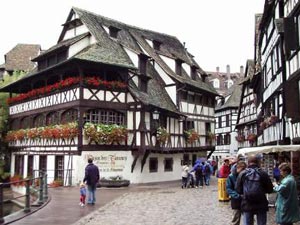 picturesque area and has a very German feel; the names of the towns and the streets are German, the food is German but you are still in France. The older locals speak a patois mix of German and French which can still be heard. We are not planning to spend much time this trip exploring the charms of the Alsatian villages, with their villages of half-timbered houses alternating with fields of corn and grain. We have an appointment at a manufacturers of leather motorcycle clothing called Spool, where Mike was able to get a set of leathers for an amazingly cheap price.
picturesque area and has a very German feel; the names of the towns and the streets are German, the food is German but you are still in France. The older locals speak a patois mix of German and French which can still be heard. We are not planning to spend much time this trip exploring the charms of the Alsatian villages, with their villages of half-timbered houses alternating with fields of corn and grain. We have an appointment at a manufacturers of leather motorcycle clothing called Spool, where Mike was able to get a set of leathers for an amazingly cheap price.
Heading out of Strasbourg, we went north, with the goal of reaching a town just over the German border called Pirmasens where we wanted to visit a manufacturer of bike intercoms (Baehr). The sky was grey with incipient rain but the ground was still dry so we headed off towards the small roads through thickly forested valleys, moisture hanging in the air as fog just above the ground. We stopped for lunch at a small restaurant in a small town, still on the French side of the border and had a quick meal. It was a bit disconcerting to speak to the waitress because she seemed to be speaking a strangely accented German and although I spoke German to her we had a hard time understanding each other. My lunch consisted of potatoes with onions, fried to a dark brown with a small pot of cream cheese with chives and garlic on the side. A small green salad and a couple of slices of ham and cured ham rounded out the plate. It was simple but absolutely delicious, a comfort-food meal for a grey day like today.
After getting a new intercom installed (oh yay! It’s so nice to have something that 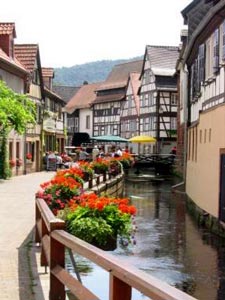 works right! It really is nice to be able to talk to each other as we ride), we rode through a sudden downpour to a town called Annweiler to find a hotel for the night. It turned out to be a cute little town of old Fachwerk houses with a canalized river running through town powering mill wheels that a few hundred years ago provided power to the bark mill and tanners. Now the wheels have been converted and now turn the water’s energy to electricity for the town. Other, more recent homes from the 1800’s were built from an unusually colored dark rose pink sandstone found in this area. A castle called Trifels sits on a high peak overlooking town; an unusually plain square building with a steeply pitched roof of terra cotta tiles.
works right! It really is nice to be able to talk to each other as we ride), we rode through a sudden downpour to a town called Annweiler to find a hotel for the night. It turned out to be a cute little town of old Fachwerk houses with a canalized river running through town powering mill wheels that a few hundred years ago provided power to the bark mill and tanners. Now the wheels have been converted and now turn the water’s energy to electricity for the town. Other, more recent homes from the 1800’s were built from an unusually colored dark rose pink sandstone found in this area. A castle called Trifels sits on a high peak overlooking town; an unusually plain square building with a steeply pitched roof of terra cotta tiles.
Fachwerk is the German term for the quaint old houses built in the style we would call half-timbered. It was a common (and probably the cheapest and easiest) construction method of the 16- and 1700’s. A wooden frame was put together, and stood up to form the outer walls, much like the 2X4 frames which form the inner walls of modern houses. The difference here is that the timbers remain exposed and the spaces between were filled with some material such as a mixture of mud and straw, or brick. The filler material was then plastered over and the wood timber painted with some preservative. I saw a few fachwerk houses in the process of being restored; stripped to a skeleton of wood, the mud and straw filling is often being replaced with something more supportive like bricks. Over time, the half-timbered houses tended to sag, houses leaning companionably on each other and the horizontal beams gently warped or slanted with age.
==============================================
Suitehotel and Etap can be found on the web - as well as all the other brother and sister hotels - by going to www.accor.com
July 6th through July 22, 2003
From Annweiler, we wound our way north through the Mosel wine-growing area and into Luxembourg. Once we had crossed into Luxembourg, we stopped at a gas station to get some gas and were amazed at the price of a liter of gas here – only € .75 as compared to €1.08 in France. We followed a scenic road that looped alongside the river Our which marks the border between Luxembourg and Germany and had a quick lunch at one of the many picnic tables set off one side of the road. The speed limit in Luxembourg is relatively slow and most of the locals drive slower than the limit, so our trip through the small country was relatively leisurely. Entering each of the small towns along the road, an electronic sign displays the speed of each vehicle passing through its radar to remind motorists to slow down. Despite all of this, we were soon in Holland (after squeezing a few more liters of gas into our tank!).
We weren’t in Holland long, however, because we were on our way to meet Stefan and Jennifer in Aachen, Germany. They were in town for a couple days to have some work done on their car and do some shopping for things they can’t get in France. Aachen is a pleasant town, with a core of pedestrian shopping streets with modern buildings and a few old buildings. We had dinner in a restaurant that had to be one of the oldest buildings in town, a small place built onto the side of the Rathaus (rathaus is German for city hall). Looking out at the square from the upstairs dining room through small panes of convex amber glass, I spotted a Starbucks – the first one I had seen outside of Vienna and London. As I was to find, Germany had embraced the espresso trend whole heartedly and every where you go you see signs saying “coffee to go”.
In the pedestrian shopping area, some of the most show-stopper displays are not designer 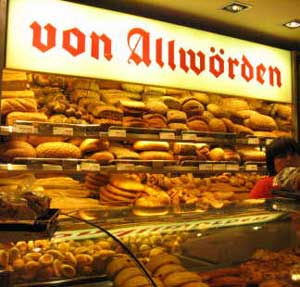 clothing or jewelry, but baked goods. The photo to the left barely does it justice. The bakeries here, and indeed all through Germany, feature beautiful displays of the most mouth watering breads. But to call it simply bread would be to put it in the same league as factory baked white bread (which is available here but is only eaten toasted!). Rye, wheat, wholegrain, pumpernickel, seven grain, sesame, poppy seed, caraway, anise, sourdough, white, gray or black. Rolls, braids, twists, long loafs, round loafs, rolls with seeds and nuts crusted on the top, both soft and hard, fitness, bio, the variety is endless - almost. I won't even go into the sweet varieties of breads! Mike is very partial to the pretzel bread; shiny, dark brown and crusty on the outside and sprinkled with coarse salt, soft and white on the inside with the same distinctive pretzel taste. It can be found twisted in the traditional pretzel shape, bigger than your palm, or in a fat breadstick shape, half a foot long and 1 1/2" wide - big enough to make a sandwich out of. Bakers here pride themselves on producing several hundred varieties of bread from the sweet raisin brioche to a strong flavored dense rye bread. Customers piling up in line behind you get increasingly fidgety as even the Germans need help because the names of the types of bread can vary from region to region. Bread in Germany is so important that they still call their evening meal “Abendbrot” (evening bread) which usually features a variety of breads with cheese and cold cuts. Aside from breads, rolls and sweets, at the bakery you can also purchase small sandwiches of a seedy roll with a few slices of cold cuts and/or cheese, lettuce, tomato and cucumber slices.
clothing or jewelry, but baked goods. The photo to the left barely does it justice. The bakeries here, and indeed all through Germany, feature beautiful displays of the most mouth watering breads. But to call it simply bread would be to put it in the same league as factory baked white bread (which is available here but is only eaten toasted!). Rye, wheat, wholegrain, pumpernickel, seven grain, sesame, poppy seed, caraway, anise, sourdough, white, gray or black. Rolls, braids, twists, long loafs, round loafs, rolls with seeds and nuts crusted on the top, both soft and hard, fitness, bio, the variety is endless - almost. I won't even go into the sweet varieties of breads! Mike is very partial to the pretzel bread; shiny, dark brown and crusty on the outside and sprinkled with coarse salt, soft and white on the inside with the same distinctive pretzel taste. It can be found twisted in the traditional pretzel shape, bigger than your palm, or in a fat breadstick shape, half a foot long and 1 1/2" wide - big enough to make a sandwich out of. Bakers here pride themselves on producing several hundred varieties of bread from the sweet raisin brioche to a strong flavored dense rye bread. Customers piling up in line behind you get increasingly fidgety as even the Germans need help because the names of the types of bread can vary from region to region. Bread in Germany is so important that they still call their evening meal “Abendbrot” (evening bread) which usually features a variety of breads with cheese and cold cuts. Aside from breads, rolls and sweets, at the bakery you can also purchase small sandwiches of a seedy roll with a few slices of cold cuts and/or cheese, lettuce, tomato and cucumber slices.
Our next stop was in Nordhorn, Germany, about 150 miles north of Aachen on the Dutch border. We had an appointment to get a new suspension for the motorcycle from a company called Wilbers, installed at the factory. We had taken the autobahn almost the whole way and because the road is lined with trees and bushes, it was rare to catch a glimpse of the countryside we were traveling through. Eventually, though, the Autobahn petered out just south of Nordhorn and we suddenly found ourselves in a landscape so flat it looked like the creator had dragged the edge of a ruler across the land to make the ground perfectly flat and level. We saw lots of windfarms; tall windmills dotting the landscape with immense propeller blades mounted on tall stalks, slowly turning to create electrical energy. We passed lots of farms, planted with corn and grains, fields bordered by trees, plain, unadorned brick farmhouses with steeply pitched roofs and pastures with black and white cows. Once we got to Nordhorn, we had the challenge of trying to find the place since we had no instructions on getting there and no address. It was very difficult to find but after asking several people how to get there, we finally found the place. Pulling up to the door, we were surprised to see another GTS!
We didn’t see much of Nordhorn aside from the road between our hotel and the industrial area that Wilbers was in, but it seemed to be a quiet community with lots of trees and plain small brick houses. The sound of bicycle bells was in the air from bicyclists on the wide bike paths that run alongside the sidewalks. We went down the road a few miles, into Holland for lunch to a popular restaurant famous for their pancakes. Dutch pancakes are not like the ones you would get at IHOP; they are large and a little thicker than a French crepe. They come with just about any topping combination you could think of, both sweet and salty. My pancake, when it came, was topped with ham and cheese, onions and tomatoes. The photo shows my pancake, nicely browned, big as a pizza and totally covering the plate underneath. Mike got one topped with meat and cheese with a mildly spicy Indonesian peanut sauce. After stuffing ourselves, we headed back to Wilbers so they could finish the installation and we could hit the road again, hoping to make it to Hanover before dark.
a pizza and totally covering the plate underneath. Mike got one topped with meat and cheese with a mildly spicy Indonesian peanut sauce. After stuffing ourselves, we headed back to Wilbers so they could finish the installation and we could hit the road again, hoping to make it to Hanover before dark.
I like traveling in Germany, and I feel comfortable here because I speak enough German to get by. The biggest problem with traveling in Germany as we do, is finding a way to connect our laptop in order to send and receive mail. Most of Germany uses digital ISDN phone lines, which require a special modem different from the one built into our computer. ISDN modems are surprisingly big and bulky, and one more thing to have to carry. It is possible to find analog phone lines but because there is so much noise on the line it is impossible to get a fast connection and sometimes prevents us from connecting at all...
We had made a weekend reservation at the Suitehotel in Hamburg which lies further North and East at the base of the peninsula which becomes Denmark. It has been an important trade and shipping center for hundreds of years and carries its heritage gracefully in its elegant brick merchant warehouse district, its busy harbor on the Elbe river – the largest seaport in Germany - and the distinctive skyline of its telecommunication tower and its churches.
The Rathaus is a magnificent sandstone “palace” built in a neo-renaissance style 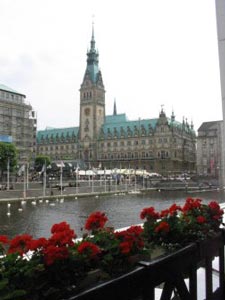 (photo at left), with a green copper roof. In addition to all the green parks in the city, a large lake sits right in the center of Hamburg and numerous canals criss-cross the city, left from the days when 19th century shipping merchants would use the canals to transport goods by boat to their warehouses.
(photo at left), with a green copper roof. In addition to all the green parks in the city, a large lake sits right in the center of Hamburg and numerous canals criss-cross the city, left from the days when 19th century shipping merchants would use the canals to transport goods by boat to their warehouses.
There are also several fashionable shopping streets where one can find designer goods and jewelry, big shops filled with electronics, sidewalk cafes and a Burger King in a mock-Greek temple. On the weekends, these streets are especially lively, with crowds of people strolling up and down and two or three brass ensembles playing classical or big-band music on the sidewalk. In one of the electronics shops, we saw a new laptop, tinier even than the one we carry and only 2 or 3 pounds. It doesn't seem to be available in the U.S. where electronics cost a lot less, though, and to buy it here would mean using a German keyboard which is different from the U.S. It is sometimes difficult to keep up with my writing and Mike at the same time keep up with his correspondence using the same computer. It would be nice to have a second computer if we could find the space!
Our hotel was not far from the lake so we walked to one of the marinas a took a ferry boat to the “downtown” area of Hamburg. We walked around a bit and found a wine festival going on in the square in front of the Rathaus, featuring the wines and foods of the area around Stuttgart. We tried the wine, a light fruity red wine served in a real glass with the logo of the wine festival. In the interest of being eco-friendly, the Germans have adopted system of using real glass glasses and washable plastic plates at public functions like this, so we had to pay €.50 for each glass, which we could take home or have refilled with another wine. In fact, we were told, you can even bring your own glass and avoid paying a deposit at all. We had gone back a second time the next day and had not brought our old glasses with us, and got stuck with another set of glasses because they do not have the facilities to wash them there. The plastic plates and silverware carried a deposit fee of 1 euro each, refundable when you return them to the counter. To go with the wine, we tried the Maultaschen, a sort of German ravioli. We discovered the secret to making maultaschen as we watched a young man roll out a large sheet of pasta dough on a table, spread it with a paste containing a mixture of pork, cheese, and I don’t know what all else, then roll it up like a strudel and cut it into pieces about 3-4 inches wide. After boiling then, the finished maultaschens can then be served with a cream sauce with mushrooms or, as we had it, cut into smaller pieces and scrambled with egg. Rather like using left-overs from dinner the night before, I image…
Germany has for many years been a country conscientious about recycling. In the grocery store, plastic bags are not handed out for free; you can either pay for one or bring bring your own bag or basket to carry your purchases home. Most beverage bottles, whether plastic or glass, carry a deposit of €.50 or €1. Bring the empty bottle and receipt back to the store where you bought and you receive the deposit back. And most public garbage receptacles have four bins; paper, glass, plastic and metal, and garbage.
The u-bahn stop is also conveniently located near the hotel; the u-bahn is a very nice, modern and very quiet subway system, with roomy seats and LCD display monitors which tell you which stop is coming up next, and which important tourist attractions can be reached from that stop. In between, you get cartoons and brief announcements of up-coming events. On Sunday, we took the u-bahn to a northern neighborhood to a park-like cemetery quite unlike any I have seen elsewhere. The grounds are filled with trees and shrubs, with grave markers tucked discretely here and there with occasional sculptures of grieving angels and other things typical of a cemetery. Walking down quiet paths one can occasionally see family members tending the graves, planting flowers or trimming the tiny hedges that surround some of the sites. Bins are placed around the park for compost materials and garbage like spent candles, and gardening tools such as watering cans are available for people to borrow.
After Hamburg, we headed towards the Eastern border of Germany to spend a few days in Berlin. Driving in towards our hotel we went through a weedy suburb with occasional abandoned factories bearing fresh spray paint in the form of graffiti. We passed the 1 kilometer 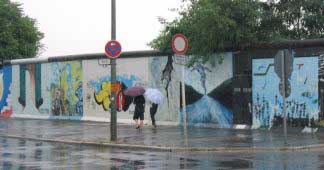 long section of the old Berlin wall that still exists, covered in painted murals, some peeling with age. We stayed in an Ibis hotel near the east train station, another French chain of hotels which was running a special summer price of 40 Euros a night. I asked the guy at the desk for a map of town and he pulled one out along with a fat blue marker. Here, he explained while making a fat blue line on the map, is where you can find the section of the old wall that is still standing. Continuing on, he made a dashed line which encompassed a large section of the eastern side of town representing where the wall had been. And when I asked where we could get good coffee, he made a fat blue dot where I could find a Starbucks. Then another and another – there are 8 Starbucks in all here in Berlin, operated by a large German department store chain called Karstad.
long section of the old Berlin wall that still exists, covered in painted murals, some peeling with age. We stayed in an Ibis hotel near the east train station, another French chain of hotels which was running a special summer price of 40 Euros a night. I asked the guy at the desk for a map of town and he pulled one out along with a fat blue marker. Here, he explained while making a fat blue line on the map, is where you can find the section of the old wall that is still standing. Continuing on, he made a dashed line which encompassed a large section of the eastern side of town representing where the wall had been. And when I asked where we could get good coffee, he made a fat blue dot where I could find a Starbucks. Then another and another – there are 8 Starbucks in all here in Berlin, operated by a large German department store chain called Karstad.
Carrying my spotted and dashed map, we headed to the train station to take the u-bahn into town. Three stops later we got off at Hakescher Markt, a funky area that has become a popular area for hanging out. The plaza below the attractive old brick train station has a series of bars where twenty-somethings gather to drink fancy cocktails and socialize. A troupe of French fire throwers entertained the crowd dancing and twirling flaming torches while another exhaled flames like fiery dragon’s breath. Restaurants in the area feature foods from many cultures, like sushi, Jewish food, or the Thai food we had for dinner one night.
Not far away, we walked past an old Jewish temple, called the new synagogue. It is a beautiful old building somewhat Moorish – Sephardic in design, with elaborate arches and windows. Its ornate gold and turquoise domes were barely visible through the leafy tree branches making a good photograph impossible. Wide concrete barriers blocked the lane of traffic closest to the temple and the sidewalk traffic was diverted to the street inside the barrier while armed security guards patrolled alertly in front of the building. It was the synagogue where the “kristall nacht” started, when the Nazis set the building on fire and ordered a huge anti-Jewish demonstration that turned into a riot. The building was an empty shell for many years but is now restored to its former beauty and a plaque on the wall reminds us to "never forget". Nearby a Jewish museum and other Jewish businesses were also fortified in the same manner. Unfortunately in these “modern” times, it seems to still be a target for terror.
Some of the buildings in the neighborhood have had meticulous restoration although some stand out like a black tooth. One such building, sandwiched between shining white-painted buildings, was missing much of its plaster showing the deteriorating brick underneath. A battered wooden door stood open showing signs of occupancy amid the rubble of the courtyard and vines climbed the outer façade like leafy green cobwebs. Other buildings, only a few decades old clash with their surroundings as if the architecture of the neighborhood was not taken into account. No doubt built quickly of cheap materials, the angular structures have not aged well and what may have once looked modern and progressive on paper now just looks plain ugly, streaked and shabby.
We walked down the road called “Unter Den Linden” (under the Linden trees), a broad elegant avenue with a park down the middle. At the end of the avenue, we passed through the Brandenburg Gate, which once marked the boundary from East to West, and were soon in a huge forested park that lies in the center of Berlin laced with paths for walking and bicycling. A huge zoo, one of the largest in Europe sits at one end of the park and was the first Zoo in Germany, dating from the mid 1800’s. At the far end of the park is the beginning of Kurfurstendamm, a busy street lined with fancy shops and restaurants and hordes of shoppers. After looking around and admiring the grand old architecture, we hopped back on the subway and headed back home. All in all, we found Berlin an interesting city, with lots to do but a relaxed atmosphere, funky and elegant in equal measure.
Soon enough, it was time to leave Berlin. Back through the suburb we had passed on the way into Berlin, the road was lined with elegant apartment buildings that looked like they had probably been built 100 years ago. Flowery balconies and wide front doors, many of the facades of the buildings were adorned with statues and the faces of women carved in stone. Driving by and looking up at them through the branches gave me the curious feeling of a host of people peering at us through the leaves.
Mike wanted to go back to Wilbers to have them change the spring on the suspension because he felt it wasn’t quite right, so in one epic day, we crossed back to the other side of Germany again, then after the work was done, we rode back up to Hamburg to meet Stefan and Jennifer to embark on our trip to Sweden.
July 18th, 2003
We have been in Sweden now for about two weeks, bouncing from one location to another in no logical order. We meet up with Stefan and Jennifer when they are available, in between their visits with friends and family and Stefan’s business meeting in Gothenburg. It is a country outside of the European 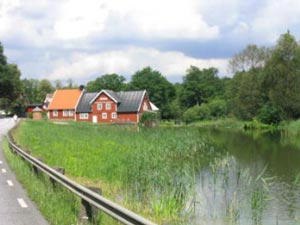 community, which means that for the first time this year, we have had to get used to a different currency and exchange rate of about 8 kronas to one dollar. (Although they are due to vote on switching to the Euro soon and some people speculate that although they don’t really want to, it will probably happen. Having watched prices go up in Europe as a result of the Euro coming in, they are afraid that prices will go up in Sweden too).
community, which means that for the first time this year, we have had to get used to a different currency and exchange rate of about 8 kronas to one dollar. (Although they are due to vote on switching to the Euro soon and some people speculate that although they don’t really want to, it will probably happen. Having watched prices go up in Europe as a result of the Euro coming in, they are afraid that prices will go up in Sweden too).
Sweden is a huge country by European standards, and Swedes like to tell us that if you took the country, from top to bottom and flipped it over, it would reach from the tip of Sweden all the way to Rome. All this space, and there are only 9 million Swedes to populate it. Many of them are the stereo-typical blonde and tanned, fluent in English. Many of the children have hair so light it appears white. There is a large population though, at least 1 million of them people who are not blonde, they are mostly immigrants from Arab or Asian lands. We like asking them where they are from. Although they have been born and raised in Sweden, they never reply that they are Swedish as if it is obvious that they couldn’t possibly be natives. One girl we talked to said she was from a small country, “I don’t know if you have heard of it. My country is Persia. But it’s not called that any more”. We looked at her incredulously. She hedged a bit and admitted having been born here but added, “I am from Mesopotamia. Have you heard of it?”.
The country is pretty in a rural kind of way and when it isn’t planted with a crop 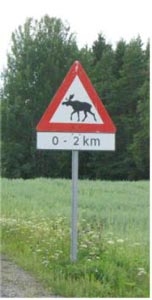 or used as pasture, is laced with small lakes and forests containing a variety of wild-life including moose. The south part of the country is the most populated and the land is mostly flat but not spectacular. The typical Swedish house is a two story wooden building, very plain, and painted a dark red with white and/or black trim. Some of the less conventional home owners have painted their houses in other colors – white, yellow, green or blue. Nearly every home has a Swedish flag in their immaculate yard; a golden yellow cross on a sky blue background. It reminds me a lot of the Pacific Northwest (except for the flags!) especially near the coast, where the stands of partially clear-cut pines reflect in small lakes.
or used as pasture, is laced with small lakes and forests containing a variety of wild-life including moose. The south part of the country is the most populated and the land is mostly flat but not spectacular. The typical Swedish house is a two story wooden building, very plain, and painted a dark red with white and/or black trim. Some of the less conventional home owners have painted their houses in other colors – white, yellow, green or blue. Nearly every home has a Swedish flag in their immaculate yard; a golden yellow cross on a sky blue background. It reminds me a lot of the Pacific Northwest (except for the flags!) especially near the coast, where the stands of partially clear-cut pines reflect in small lakes.
The main thing that we find restraining here is the speed limits on the network of 2 and 4 lane highways. The speed limit is 45 to 55 mph and we were sternly warned by Stefan to watch our speeds because if you get caught speeding, you can receive a stiff fine, and if you are going 20 – 25 mph over the limit, your vehicle could be confiscated. If you are a foreigner, they will escort you directly to the border…To make matters worse (for those who like to go fast at any rate!) is that most Swedish drivers normally drive about 15-20 mph slower than the speed limit! Luckily, most of the 2 lane roads have a broad shoulder where the slower drivers will drive so others can pass. Since we rarely saw any police, I guess they are looking out for a moose; we were also warned to keep our eyes open for these large creatures. If you see one, there is probably more around especially in the evening when they come down to the water to drink.
People are always telling us how safe Sweden is; they are very trusting and depend on the honesty of others. Unafraid of having anything stolen, bikers here will often leave helmets and leather gear draped over the bike while they shop or get some lunch. In the country, you will often see unattended vegetable or flower stands where you can take what you want and leave some Kronar in a glass jar for payment. On the other hand, to discourage hold-ups in some convenience and grocery stores, money paid for goods goes straight into a sort of vending machine contraption; you put your coins in a slot and the cashier slides the bills into another machine. Change is automatically dispensed by the machine.
So. When we left Germany to go to Sweden, we headed effortlessly out of Hamburg following Stefan and his GPS to the road to Denmark. (we tend to get lost a lot, especially in big cities, and it is becoming apparent that we need to get one too!). In about 70 miles we caught the ferry in Puttgarden, which took about 1 hour to cross to Denmark, just about enough time to catch some lunch before heading back to the bikes.
The drive through Denmark was pretty uneventful. With a speed limit of about 55 MPH, we had plenty of time to see a mostly flat landscape of grain fields dotted with farmhouses and windmill power generators. One thing that did worry us though, was a grey sky and damp pavement as if it had recently rained. After a few hours we had passed Copenhagen and were at the foot of a long toll bridge that would take us over the Ostsee to Sweden. Ominously, a huge cloud hung over the bridge starting at mid-span and obscuring our first view of a country we’d never been to before.
We were lucky though, and were only sprinkled on a little bit as we made our way under black skies to the small town called Höör in southern Sweden where Stefan’s brother lives. The damp air smelled honey-sweet from fields of blooming clover. We passed through a flat countryside with farms and village after village of small red houses, ponies and horses grazing in pastures. There were many groves of trees too, and occasionally we’d spot a yellow triangle caution signs with a black moose on it.
We stayed with Stefan’s brother, Conny, and his wife Monica for a couple of days. Sitting in the back yard chatting one night, the guys were drinking beer but I didn’t feel like having any beer, so Conny handed me a can of something and said, “Here, I think you’ll like this”. It turned out to be cider made from pears, light and sparkling, a little sweet and very refreshing with a distinctive pear flavor. I was hooked. It seems to be a national drink, available everywhere. You can find cider in many flavors, including blueberry, raspberry, apple, and even weird combinations like mandarin-chili and cactus-lime, but pear is by far the most popular.
One night, we walked to the “busy” center of Höör to eat pizza. Walking through the neighborhood of tidy houses with large but beautifully kept yards with lots of trees and flowers, it seemed like a ghost town because there were few cars on the road and few people to be seen. The pizza place had tables on the sidewalk in front and we were treated to a “parade” of cars cruising up and down the street. A pair of teenagers in a vintage Volvo pickup truck, another young pair in an old ford convertible from the 50’s. And a middle aged couple in a vintage Cadillac convertible complete with tail fins passed three or four times. It seems the Swedish are crazy about classic American cars and restore them with loving attention. Every seems to know each other and as the cars pass slowly by, people greet each other and wave.
The morning after we arrived, of course, the sun was out and the sky was a brilliant blue. We took a nice ride through the country, on a beautiful Saturday afternoon in the warm sun. Now that the weather had 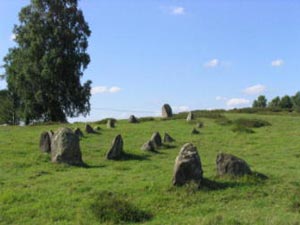 improved we could see that the fields of grain were edged in wild flowers, and more pastures with beautiful horses and small native ponies. We rode north a bit, up to a rocky shore, and had lunch in a restaurant with a view of the sea then walked down to the water where families had spread out their blankets on the rocks to sun themselves and have picnics. On the way back to the house, we stopped at an ancient grave-field of standing stones marking graves from 550-900 A.D. Some of the stones were standing alone in the midst of a heather filled sheep pasture, but a few of the graves were marked by an arrangement of stones in an oval shape to represent a boat. Archaeologists investigating the site determined that the graves contained the remains of funeral pyres.
improved we could see that the fields of grain were edged in wild flowers, and more pastures with beautiful horses and small native ponies. We rode north a bit, up to a rocky shore, and had lunch in a restaurant with a view of the sea then walked down to the water where families had spread out their blankets on the rocks to sun themselves and have picnics. On the way back to the house, we stopped at an ancient grave-field of standing stones marking graves from 550-900 A.D. Some of the stones were standing alone in the midst of a heather filled sheep pasture, but a few of the graves were marked by an arrangement of stones in an oval shape to represent a boat. Archaeologists investigating the site determined that the graves contained the remains of funeral pyres.
Conny and Monica’s daughter, Nana, is a cheerful 21 year-old. A classic Swedish blonde with a wide smile, she had spent a year as an exchange student in New Zealand and her fluent English has a distinct Kiwi accent. I was treated to 4 volumes of photos of her time there, with some very nice photos of the country and some silly photos of her friends. She was sad to see us leave and fervently told us to come back any time we wanted…
From Höör, we rode up the west coast to Gothenburg, while Stefan and Jennifer went to visit his dad. We stayed in an Ibis hotel, which turned out to be floating in the river, not far from the harbor. Built in Hamburg and towed to Gothenburg years ago, it looks like a boat and has a nice deck for sitting and watching the boats go by, and although the hotel floats, you don’t feel any movement. The rooms are also tiny, as befits living on a boat! We flipped on the TV and found that most of the programming was in English, sub-titled in Swedish. From old series – Miami Vice, Dallas, Charlie’s Angels – to the latest sit-coms and dramas. This helps to account for the ability of the Swedish to speak English – I would say that 90% of the people here speak English fluently. I was told that they have to be able to speak at least 2 foreign languages in order to graduate from school.
Here are some of the facts I learned about Gothenburg; it was founded in 1621 and built according to Dutch designs with canals and fortifications. Gothenburg became one of the most heavily fortified cities of the period with a with water moat, a city wall and three fortresses. On the north sea, it was a center of trading silk, tea, furniture, porcelain and precious stones with China and the Far East. A portion of the double moat remains, ringing what was then the inner city, lined on either side with a park shaded by trees. The main drag, called the Avenue, is lined with cafes and restaurants and is the hip place to go on a Saturday night. Most of Gothenburg’s tourists can be found here or in the huge mall nearby; Americans, Germans, Spanish and a few Dutch. Power lines criss-cross the streets for the old fashioned trolleys that run along them. We walked around a bit to see the sights but there isn’t much to see in Gothenburg, it’s mostly a quiet, pleasant city and a good place to go shopping. Off the main drag, the streets and sidewalks are usually empty.
Walking back to the boat one night, we walked through a residential area that seemed deserted. Although it was twilight, few lights were on, no cars were on the street and it seemed like no one was home. Turning a corner, we started hearing voices as if a raucous party were going on and it seemed strange that Swedes would be so loud. As we passed under the balcony, however, we realized that the boisterous voices were speaking Spanish, at normal Spanish volume!
July 23th, 2003
From Gothenburg, we had a few days to kill so we went to Stockholm for a few days, which means we had to go from the west coast to the east coast in one day. Luckily, Sweden is much narrower than it is long, but even so, it took us 6 hours. We were told that we had made good time, because the speed limits are so slow.
Once we got to Stockholm we went to see a friend of Stefan’s whose sister has a small business hotel where we would stay. Stefan’s friend, Olle has a motorcycle workshop where he repairs and sells Goldwing motorcycles and Mike was able to borrow some tools and equipment to test the battery on our bike. Our new intercom was giving us a little trouble; we were getting static for no good reason, but the battery seemed to be ok. Olle’s wife showed up in a bright red Mustang convertible to take us to the hotel and after dinner, they took us on a twilight tour of Stockholm.
The next morning we met the sister running the hotel. She wanted us to pay for the room this morning, since she was leaving on vacation in a few hours - heading for France to play golf - and there would be no one in the office for a couple of weeks while she was gone! A Chilean refugee family was living in the dormer room; we saw the man of the family working around the hotel grounds and we later encountered the boy in the parking lot, a curious kid of about 10 years old who spoke to us in a bizarre mixture of Spanish and Swedish, asking about us and the motorcycle. Olle’s sister explained to us a bit resentfully that they had been staying there for about 2 months, paid for by Swedish taxes – meaning that the Swedish government is quite generous to people who come to live in Sweden. Aside from the Chileans, only a few guests were staying there though we never saw them, and a maid cleaned rooms on the weekdays. A kitchen with refrigerator and microwave were available for use, as well as a coffee machine where we could get coffee for free. In the basement was a laundry room with some washing machines, an extractor to spin the excess water out of our clothing, and dryers which we could also use for free. Cool! It’s about time for doing a load of laundry.
There was a phone in the room and Mike was told that he could get a line out of the hotel but when he tried it, he couldn’t get it to work. After talking to Olle’s sister, and going back and forth between the room and the office, trying different things, it finally came out that they had had a new phone system installed in the hotel but after they had paid for it, they realized that the calls from the rooms could not be metered so they simply shut off the phones to outside calls. They wouldn’t know how much to charge us for our phone calls so they wanted us to pay a deposit of 1000 Krona - around €100! We finally got it worked out; after I showed them a bill from 3 days in the previous hotel which came to about €10, we agreed on a deposit of €20 which she promised to charge back to our visa once the phone bill came and she figured how much we owed… 
After taking care of business, we were ready to do some sight-seeing. Stockholm is a beautiful city built on a series of islands linked by bridges and ferries, located between the Baltic Sea and Lake Malaren. We were able to easily go into town from the hotel on the local train and started exploring after a quick stop at the downtown tourist information center to get maps and to ask some questions. Three days is hardly enough to spend here, but we managed to see quite a bit.
Gamla Stan is a small island of close alleys and old buildings painted a mustard gold color with lots of medieval charm. It’s where the city got its start and is now densely packed with souvenir and handcraft shops and tourists eating ice cream. As the city grew, it expanded to include other islands and by the late 1800’s, the city had many restaurants, theaters, variety-shows, and music-cafes. The city-planners were much taken with Haussmann’s Paris, with its grand scale, impressive architecture and broad avenues and its influence can be seen in Stockholm today.
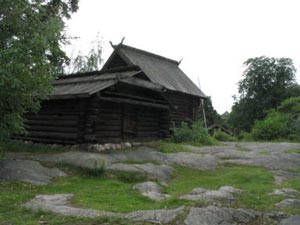 Djurgården is a tranquil island of parks and large old homes, but also has several important museums and an amusement park. The Vasamuseet with its ancient ship dredged up from the harbor floor. It was built in 1652, beautifully fitted and elaborately carved but top heavy, so on its maiden voyage, it sank. The Vasa now sits afloat in the water again, with the museum built around it. Another museum, the Nordiska Museet, is dedicated to life and work in Sweden from the 16th century to today. It is also supposed to have the best collection of Swedish folk costumes which I was really looking forward to. After making the trip over there, wouldn’t you know it?, that exhibit is temporarily closed. Oh well, the museum I found most interesting, was Skansen, a huge open air museum. Historic farmhouses, churches and manor houses from all over Sweden have been reassembled here to show how people lived, the houses furnished as they were in the 1800’s with costumed docents on hand to explain or demonstrate any questions. Most all facets of life in those days is covered, from indentured labor to townsfolk, including typical breeds of farm animals or traditional crafts like glass-blowing and book-binding demonstrations. Typical festivals are also celebrated here, at the appropriate time of year.
Djurgården is a tranquil island of parks and large old homes, but also has several important museums and an amusement park. The Vasamuseet with its ancient ship dredged up from the harbor floor. It was built in 1652, beautifully fitted and elaborately carved but top heavy, so on its maiden voyage, it sank. The Vasa now sits afloat in the water again, with the museum built around it. Another museum, the Nordiska Museet, is dedicated to life and work in Sweden from the 16th century to today. It is also supposed to have the best collection of Swedish folk costumes which I was really looking forward to. After making the trip over there, wouldn’t you know it?, that exhibit is temporarily closed. Oh well, the museum I found most interesting, was Skansen, a huge open air museum. Historic farmhouses, churches and manor houses from all over Sweden have been reassembled here to show how people lived, the houses furnished as they were in the 1800’s with costumed docents on hand to explain or demonstrate any questions. Most all facets of life in those days is covered, from indentured labor to townsfolk, including typical breeds of farm animals or traditional crafts like glass-blowing and book-binding demonstrations. Typical festivals are also celebrated here, at the appropriate time of year.
The archipelago that Stockholm is part of has about 24,000 islands. These islands were formed by the inland ice sheet that covered all of Scandinavian during the ice age. As a result, the rock has a smooth, polished look to it. I read that the islands of the archipelago are rising out of the sea at a rate of 40 centimeters every 100 years. There are lots of ferries that shuttle people from island to island out in the archipelago, so one day we took a boat out to the island of Grinda, about 1 ½ hours away. The ferry wound through many islands big and tiny, stopping at various ports to let off or take on passengers. Some islands were barely big enough for a seagull or two to find space while others were large and dotted with small summerhouses amidst pine forest and smoothed rocks.
When we arrived at Grinda, we hopped off along with a bunch of other people with backpacks, prepared for camping. We found ourselves on an island with no roads, just a path that should take ½ hour to walk, leading through the woods to the other side of the island where we would catch another ferry back. We got some pear cider and a snack (tortilla chips and salsa, can you believe it?) at a small snack bar at a harbor then got to the dock just as the ferry was arriving. We made a quick visit to Vaxholm, a small town recommended by the tourist information, but it was late afternoon and everything was closed so we waited for the next boat and headed home.
Time to leave Stockholm and go back to the East coast; Stefan is in a coastal town north of Gothenburg visiting his mom in Kungshamn where he grew up. He has invited us on a boat cruise through the islands with some friends of his. It’s a Sunday morning, the sun is shining, and we are all packed up and Mike starts the bike. Only nothing happens but a sickly little grunt from the bike. Great. The battery is dead but has enough charge that we may be able to push start the bike. We take off one of the bags and Mike sits on the bike paddling along while I push madly from behind, but we can’t get enough speed so I hike up 4 flights of stairs and try to find the Chilean guy. The door opens to a woman and I explain in my best Spanish that we need help pushing the bike because it’s dead. She seems to understand then says, “Do you speak English? You can talk to me in English…”, noting no doubt that I am not that fluent in Spanish! The three of us maneuver the bike, minus some of the bags, up a slight incline then, pushing it, we got it started. I put the keys in the room since we could now leave, got my jacket on, my helmet on and Mike puts the bike in gear forgetting that the kickstand is still down. Which kills the engine. (a built-in safety device that is not that welcome at the moment!) Unable to go back in the building and unable to raise the Chilean guy, the two of us try again to push start the bike, which succeeds this time. Jacket back on, helmet on and… the bike is dead again. Ok, one more time strip, push, put clothes on again over a now soaked tee-shirt and I manage to get on the bike and we carefully and cautiously left the parking lot of the hotel, 1 hour later than planned.
We are now so paranoid that we are anxious for the first few hundred miles. Is the charging system is working? Will the bike start again if we turn it off? We don’t know. Mike has to stop for gas and decided to keep the motor running while pumping gas. At the second gas stop, halfway to our destination after having driven for a couple hundred miles, we decide to be bold and shut the engine off. We’re at a gas station with lots of people and if the bike doesn’t start again we should be able to get help easily. With a twist of the key the bike starts right us and we give huge sigh of relief. we decided to take advantage by having a few bites of lunch and use the toilet before taking off again. As we eat we feel the first few drops of rain.
Riding along the western shore of an enormous lake, we saw several paper mills and mountains of bark mulch. I just can’t get over the resemblance to the Oregon coastal hills. The road is starting to get more curvy and interesting, with small towns on lakes and lots of trees. Unfortunately it is really starting to pour down rain and we can‘t see much through fogged visors streaming with rain. (now it really looks like Oregon!) We pulled under some shelter for a while but the rain showed no signs of waning so we reluctantly decided to continue. Not wanting to overtax the battery we didn’t plug in our heated clothing and we were soon pretty cold. It wasn’t too long before we decided to stop for coffee to warm us up. We found a small store in a town called Dingle and waited, stiff from cold, behind a crowd of Swedes buying ice cream cones. We were so wet we were dripping on the floor, puddles forming on the floor at our feet and Mike’s hands were black from the dye that came off his sodden leather gloves. We weren’t that far from where we were to meet Stefan and Jennifer so we gave up and left. Getting very close to the coastline, we started seeing ice-polished rock formations amongst the trees. The trees gradually thinned out until we suddenly realized that we were riding along a fjord and the smell of the sea was in the air. Then we turned into a small village with a quaint small harbor where we found Stefan and Jennifer and Mom, just finishing up their dinner.
Stefan pronounced his dinner at the restaurant not worth the money so he led us to his mom’s apartment where we stowed our wet leathers and boots in her “drying room” to dry. The room turned out to literally be as advertised, a room for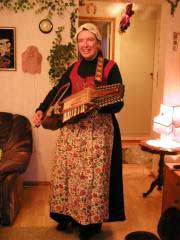 drying clothing on lines, with a huge fan blowing warm air. The warm air felt so good in there, I almost didn’t come out again! But Stefan’s mom had made us a simple dinner of fried eggs and potatoes fried with pieces of sausage. I can’t tell you how good that tasted!!
drying clothing on lines, with a huge fan blowing warm air. The warm air felt so good in there, I almost didn’t come out again! But Stefan’s mom had made us a simple dinner of fried eggs and potatoes fried with pieces of sausage. I can’t tell you how good that tasted!!
After dinner we visited a bit and although Stefan’s mom doesn’t speak anything but Swedish, we got along quite well. She showed us the folk costume from the area that she had hand made years ago and the instrument called a Nyckelharppa that she also built. About 3 feet long, the instrument looks like a cross between an autoharp and a violin. It is played with a short bow and pressing on one of the many buttons on the side of the neck changes the note by pressing on the string. She dressed me up in her costume and put the Nyckelharppa in my arms while Jennifer took pictures.
July 27th, 2003
Kungshamn (meaning King's Harbor in Swedish) turned out to be an interesting place with a distinct little-beach-town feel to it. It was a relaxing place to hang around, and I needed to do some writing so it worked out well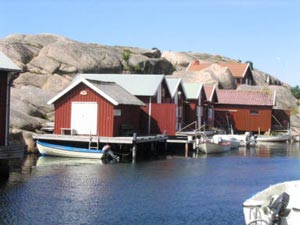 for me. We also strolled around enjoying the beautiful weather and the charming town. Clusters of typical little wooden houses are set amongst smooth granite rock formations, with almost no trees to be seen. During the winter it is a small fishing village of a few thousand people but in recent years it has become a popular tourist destination during the short summer months, when it swells to about eight times its normal size. There is one hotel, reserved months ahead of time, that charges €300 per night. Luckily there are other options. Many choose to camp nearby (again, for way too much money) while others if they are lucky find a room to rent in a private house. Stefan had found us a room with Lennart, an old friend, who had probably the last available room in town. It was a small single room with a sink and stove, a table and some chairs and a bunk bed. A toilet and a communal refrigerator in the hall, which we soon filled with pear cider. The shower was around the back of the house through the soggy yard. Wait a minute, bunk beds?!? Not likely. We pulled the foam mattresses off the beds and made our bed on the floor, which just barely fit in our tiny room. This palace cost us the paltry sum of 600 Kronas a night. That translates to about €70 per night! (I thought someone had told us Sweden was cheap but I must have been dreaming).
for me. We also strolled around enjoying the beautiful weather and the charming town. Clusters of typical little wooden houses are set amongst smooth granite rock formations, with almost no trees to be seen. During the winter it is a small fishing village of a few thousand people but in recent years it has become a popular tourist destination during the short summer months, when it swells to about eight times its normal size. There is one hotel, reserved months ahead of time, that charges €300 per night. Luckily there are other options. Many choose to camp nearby (again, for way too much money) while others if they are lucky find a room to rent in a private house. Stefan had found us a room with Lennart, an old friend, who had probably the last available room in town. It was a small single room with a sink and stove, a table and some chairs and a bunk bed. A toilet and a communal refrigerator in the hall, which we soon filled with pear cider. The shower was around the back of the house through the soggy yard. Wait a minute, bunk beds?!? Not likely. We pulled the foam mattresses off the beds and made our bed on the floor, which just barely fit in our tiny room. This palace cost us the paltry sum of 600 Kronas a night. That translates to about €70 per night! (I thought someone had told us Sweden was cheap but I must have been dreaming).
The next morning was a bright sunny day with brilliant blue sky. No sign of the previous days’ downpour except for the soggy lawn. Our leathers, boots and even the insides of the helmets up to the ears were still damp, even after a spell in the drying room so we spread everything out outside to dry. Water had even gotten into the side bag and some of my clothes were dampened by the three hour ride through the rain. I hung them up as well, then we walked down to the bakery to find something for breakfast. We found a nice assortment of stuff from seeded rolls and sandwiches (called Smorgasar - which the Swedish eat for breakfast) to sweets like Swedish-style cinnamon rolls – unfrosted but sprinkled with little bits of coarse sugar. Not nearly as sweet as the American variety. The pistachio rolls were tempting, like the cinnamon rolls but with a greenish pistachio paste inside and cardamom and they taste heavenly! We got some lattes and some goodies to eat and took them into the sun while we had breakfast.
After breakfast we ran into Stefan on an errand to pick up some stuff at the grocery. Since there are so many tourists in town the lines at the grocery stores get a little long, forcing locals to go very early or very late if they want to avoid long waits. Lines formed quickly at the ATM machines, too, but otherwise the downtown area was pretty quiet, with a car passing us every few minutes. Stefan laughed as he told us his mother had complained about all the traffic in the town – obviously she’s not spent much time in a city like Paris (for example)! He also said he had talked to his brother about our motorcycle battery; he was able to buy one for us in Gothenburg and would be here in Kungshamn the next day.
 After Stefan’s errands were done, he suggested we go explore Smögen, a picturesque island across the harbor. He took us over the bridge to Smögen and dropped us off, explaining that we could catch a taxi boat back to downtown Kungshamn.
After Stefan’s errands were done, he suggested we go explore Smögen, a picturesque island across the harbor. He took us over the bridge to Smögen and dropped us off, explaining that we could catch a taxi boat back to downtown Kungshamn.
Smögen boasts a long wooden boardwalk, suspended out over the water of the harbor. The island is one big, rounded lump of granite and today, in the sun, it is glowing a warm pink color, bits of mica in the rock sparkle as the sun hits it. Cottages turned into stores hug the rocks along the boardwalks, and tellingly, most of the stores sells scarves and foul weather gear as well as Swedish clogs and nicknacks. Tourists were plentiful, looking at clothing shops, eating at one of the many small food stands selling Swedish hot dogs and ice cream or watching the boats go by. Some local boat owners were taking advantage of the beautiful day to bail water out from yesterday’s rain and to hang wet clothing on lines and rigging and any available space where they could catch the sun. I leaned out over the rail to look into the water of the harbor and was amazed to see lots of floating things in the water; ghostly blue jellyfish, almost translucent and the size of your fist, propelling themselves slowly through the water. There were also larger yellow and red jellyfish, with long trailing tentacles several feet long. These jellyfish are larger than the blue and are capable of giving a swimmer a painful sting. The yellow and red jellyfish fish have a strange, barely cohesive look to them, like bread slowly disintegrating in water. We wandered all the way to the end of the boardwalk past the boathouses, then headed back to where the taxi boat was waiting to take its load of passengers to Kungshamn for about €2 each.
There is an archipelago of islands surrounding Kungshamn; although not as extensive as the one near Stockholm, it has proven more deadly to the fisherman navigating them in their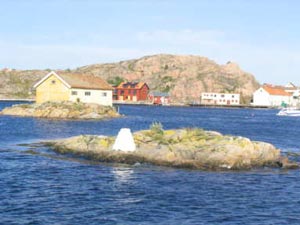 small boats. Some of the islands are covered by water during high tide and the only sign of them is to watch how the waves crash on the unseen object, sending spray high into the air. The islands have caught many sailors unaware and for this reason, Kungshamn was originally named Gravarne, which means “the graves”. The whole area is really quite beautiful; the landscape is very simplistic and restful; sky and water and rocks. Stefan came to pick us up at 4 p.m. for the boat ride he had been telling us about.
small boats. Some of the islands are covered by water during high tide and the only sign of them is to watch how the waves crash on the unseen object, sending spray high into the air. The islands have caught many sailors unaware and for this reason, Kungshamn was originally named Gravarne, which means “the graves”. The whole area is really quite beautiful; the landscape is very simplistic and restful; sky and water and rocks. Stefan came to pick us up at 4 p.m. for the boat ride he had been telling us about.
Assembling at Stefan’s friends’ house, about a dozen of us walked down to the harbor where we were greeted by the captain of a traditional fishing boat, built in 1916. The captain, a cheerful man with round glasses and a luxurious moustache that curled at the ends, gave us a running commentary (in English) as we steamed out of the harbor. We headed into a canal that was dug by hand many years ago to facilitate the fishing boats passage to the sea and ate a picnic of crayfish and bread. We passed farmland and more rocks – lots of rocks, carved into projecting rock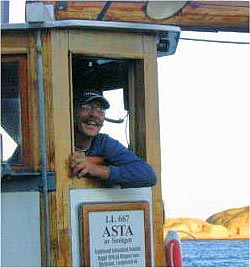 formations, deep clefts and fantastic pot-holes – and a curious little one-room cottage made out of stone with a grassy sod roof, built a century ago to house a poor family with 7 children. It is hard to imagine how poor the people living here were in those days. Mike and I sat near the center of the boat, wearing our rain jackets against the wind, and I was glad we had brought them, because once out of the canal, we headed out into the North Sea. The boat began to buck and pitch, the front of the boat rising high into the air before slamming down on the rough water sending cascades of water over the sides and down on our heads! Soon (thank god!) we turned back and headed back to the harbor. Slightly green in the face, I was the first one off the boat. An exciting finish to our boat ride, and we were soaked from head to toe again, for the second day in a row!
formations, deep clefts and fantastic pot-holes – and a curious little one-room cottage made out of stone with a grassy sod roof, built a century ago to house a poor family with 7 children. It is hard to imagine how poor the people living here were in those days. Mike and I sat near the center of the boat, wearing our rain jackets against the wind, and I was glad we had brought them, because once out of the canal, we headed out into the North Sea. The boat began to buck and pitch, the front of the boat rising high into the air before slamming down on the rough water sending cascades of water over the sides and down on our heads! Soon (thank god!) we turned back and headed back to the harbor. Slightly green in the face, I was the first one off the boat. An exciting finish to our boat ride, and we were soaked from head to toe again, for the second day in a row!
We had coffee with Lennart, our host, and chatted while Mike tried to fix his computer problems (to no avail). We were wondering why, with all the granite around, all the houses were built out of wood. Lennart told us that the stone houses are cold (I can believe that!) and hard to insulate, but even more importantly, there is radon in the rock. The people who have lived here all their lives have a high incidence of cancer. Winters here can be quite cold, but in summer it is mild and pleasant and the sea gets “nice and warm”, maybe 71 or 2 degrees Fahrenheit. Lennarts’ wife told us that she had gone to one of the islands to swim in the sea and there were so many of the little blue (non-stinging) jellyfish, that it was like ”swimming in noodle soup”.
Life here a hundred years ago was quite difficult and many people were starving. But they did have one important resource, which was all around them: the granite rocks. The 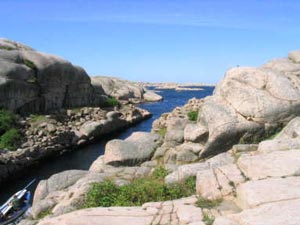 granite was such good quality that by the end of the 19th century, it was popular for both building and roads. Stone quarries became the dominant industry and the main source of income for the locals. The height of the stone quarries came just prior to the turn of the last century but declined after new building materials were taken into use and asphalted roads replaced cobblestones. These days they depend on 2 or 3 months’ worth of tourist money. This would explain why the town is deserted most of the year, only coming to life in the all-too-brief summer.
granite was such good quality that by the end of the 19th century, it was popular for both building and roads. Stone quarries became the dominant industry and the main source of income for the locals. The height of the stone quarries came just prior to the turn of the last century but declined after new building materials were taken into use and asphalted roads replaced cobblestones. These days they depend on 2 or 3 months’ worth of tourist money. This would explain why the town is deserted most of the year, only coming to life in the all-too-brief summer.
On our last day in Kungshamn, Stefan came by with a new battery for our bike and helped install it. Stefan and Jennifer had planned to continue their trip with a couple of friends by spending about 5 days riding in Norway and we agonized over whether or not to go along. The main problem was the weather; the forecast for Norway was one day of sun then five days of rain. The countryside is supposed to be spectacular and the roads twisty, thanks to the mountains, but it is the mountains that attract the rain clouds that typically keep the area damp. They would be staying in small cabins along the way, and sleeping in sleeping bags; they had scrounged up some bags but were still missing one if we decided to go. We had finally gotten everything dried out after a few days in the sun and we weren’t anxious to head into more rain so with deep regret we decided not to go. I know, we sound like wimps but if we could get that wet after three hours of downpour, I could just imagine what it would be like trying to dry clothes every night in an unheated cabin…
Stefan gave us some suggestions for a route we could take then we said our goodbyes before he left to prepare for their departure early the next morning. Meanwhile, it was now late afternoon and we started thinking of what to do for our last dinner in Kungshamn. Remembering the picnic on the boat the day before, Mike suggested we get some more crayfish. That sounded like a good idea so we strolled down to the harbor and took the taxi boat, which had just arrived, to the harbor in Smögen. Once there we walked past several stands selling lottery tickets for a bucket of shrimp, then we saw a good sized store with seafood in glass cases so we went in. The store was busy with shoppers buying various types of fish, fresh lobsters, shrimp and crayfish. Another glass case held trays of hot loaves of garlic bread and buckets on ice full of various types of salads: potato, cabbage, shrimp. We bought a big bag, about a kilo, full of large boiled crayfish, ready to eat . Some garlic mayonnaise, and some hot garlic bread which smelled so good half of it was gone by the time we arrived home. All this for about 30 euros.
July 29, 2003
After our usual breakfast at the bakery, we headed north up the coast as Stefan suggested. There were some interesting things to see within a days’ ride from Kungshamn, so I wish we had known about them earlier, but I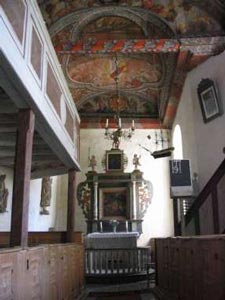 guess that’s what we get for not carrying guide books with us when we travel. We stumble on a lot of cool stuff quite by accident while passing up a lot of tourist stuff both knowingly and unknowingly. It was a beautiful day for riding and lots of bikes were out on the road, nearly each rider greeting us with a wave as they drove past.
guess that’s what we get for not carrying guide books with us when we travel. We stumble on a lot of cool stuff quite by accident while passing up a lot of tourist stuff both knowingly and unknowingly. It was a beautiful day for riding and lots of bikes were out on the road, nearly each rider greeting us with a wave as they drove past.
The first stop was the Svenneby church which several people said was a must-see. It was a small, plain stone building built in the early part of the 12th century, and its belfry sat by itself on the cliff above which seems to be typical of the older Swedish churches. Inside the church, we found it charming; a space with lots of light streaming in through large clear windows, with narrow wooden pews closed off by gates, several wooden statues of Jesus and some assorted saints from the middle ages, and a loft hanging low above our heads. In the old days, the women would sit on one side of aisle while the men sat on the other; I could imagine them sitting there in their lacy caps and aprons. The wooden boards of the ceiling and altar were painted with biblical scenes and date from the 18th century, and the red and blue swirls of paint gave it a folk art feeling.
Just up the road, we found a Viking village, which seemed to be in the process of being 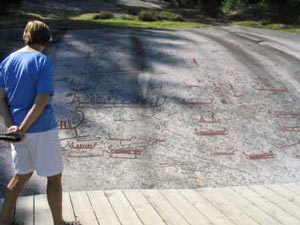 built. People dressed in homespun garments and using hand tools were busy reconstructing buildings and workshops after archeological research and demonstrating Viking crafts like felt-making and wood carving to the visiting children. One interesting building, a longhouse, had a roof shaped like an overturned boat, its bowed supporting beams braced against the ground to give it strength. Here the tribe would gather and spend a lot of their time using the longhouse as a communal living room. Another curious building looked like a haystack, with a small round opening and an earth floor.
built. People dressed in homespun garments and using hand tools were busy reconstructing buildings and workshops after archeological research and demonstrating Viking crafts like felt-making and wood carving to the visiting children. One interesting building, a longhouse, had a roof shaped like an overturned boat, its bowed supporting beams braced against the ground to give it strength. Here the tribe would gather and spend a lot of their time using the longhouse as a communal living room. Another curious building looked like a haystack, with a small round opening and an earth floor.
The area has had inhabitants even further back than the Vikings; 3 thousand years ago, people lived here and left their mark in the stones in the form of rock carvings and built dolmens - chambered graves of stone. We stopped briefly at a grave field that contains about 200 graves from a later period, approximately 200-400 A.D., with both standing stones and barrows. The area around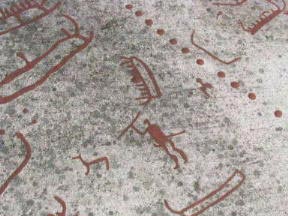 Tanum is particularly rich with rock carvings from between 1800 and 500 B.C. and at Vitlyke, there is an interpretive museum and walking paths that lead you through to some of the finest examples to be found. Scientists studying the carvings have painted the carved figures with red paint to make it easier to see. Many of the carvings are of long boats - at least 10,000 of them - with lines representing the crew, while others are comical stick people wielding long spears and shields. Some animals are depicted, including a whale, and symbols representing the sun, footprints and round “cup marks” which would hold offerings to the gods. I could have spend days there but it was afternoon already, and we hadn’t gone very far.
Tanum is particularly rich with rock carvings from between 1800 and 500 B.C. and at Vitlyke, there is an interpretive museum and walking paths that lead you through to some of the finest examples to be found. Scientists studying the carvings have painted the carved figures with red paint to make it easier to see. Many of the carvings are of long boats - at least 10,000 of them - with lines representing the crew, while others are comical stick people wielding long spears and shields. Some animals are depicted, including a whale, and symbols representing the sun, footprints and round “cup marks” which would hold offerings to the gods. I could have spend days there but it was afternoon already, and we hadn’t gone very far.
Up the coast a little further, and we started seeing a few large shopping centers and factory outlet stores in the middle of nowhere. We were getting close to the border with Norway, and as every one kept telling us, everything is a lot more expensive in Norway. We saw lots of cars with Norwegian plates and stores full of shoppers, so I guess it’s true. We crossed the border into a sparsely populated corner of Norway and over a bridge with a spectacular view, past cameras set every few kilometers scanning the traffic hoping to catch speeders and take their pictures. Not too much further and we had passed the small town of Halder and turned east where we crossed the border back into Sweden.
Time to find a room for the night. We found ourselves in a small town called Ǻrjäng, in front of the tourist information office. The young lady working there helped us find a Bed and Breakfast for around €50. We checked ourselves in, had a nice chat with the woman running the B&B then went out to walk around the town. She had told us she hoped it would be quiet tonight and paused a moment, calculating. Yes, it’s Wednesday, it should be alright. We were gradually realizing that this was not your typical Swedish town; noisy 2-stroke dirt bikes and cars with rap music booming out of huge American-style speakers trolled up and down the street. A raucous group of teenaged boys hung around at the main square. A young woman stood in front of a closed gas station on a deserted street looking like she was for hire; when I turned around to look again, she was gone. We went back to the tourist information to ask some questions and the girl also told us that since it was Wednesday, it wasn’t too bad – on Fridays, Saturdays and Sundays, the streets can be noisy all night long with the cars and bikes, and strolling teenagers out at night with nothing much to do…Every one we talked to seemed to agree on one thing: that it was a nuisance, but with a helpless shrug of their shoulders said there was nothing much that could be done. This town apparently doesn’t have a full time police force. A few days later, I was talking to a Swedish biker and told him of our experience and he laughed and said, “yes, Ǻrjäng has that reputation. The Swedes say it is a place outside the law.” He went on to explain that it was a portal for drugs coming from Norway into Sweden…
The next morning we headed to Lake Siljan on a 2 lane highway through the pine and birch forests. We got a very nice room in a hotel set in a tranquil park in a town called Mora. We were now in the Dalarna province which is famous for the carved wooden horses, painted red with a garland of folk flowers around their necks. Dalarna is also famous for all of its other folk crafts and as we traveled through the area we passed fields of flax for making linen, weaving studios, pottery studios, wooden horse workshops and handcraft guild stores where one can buy the local traditional costume of the area or the materials and patterns to make your own.
Following the east coast of Lake Siljan, we made a stop in Rättvik where a  classic car rally was in progress. Thousands of old American cars were in town; almost all lovingly detailed and in pristine condition. These classic beauties were on the road all through the area, classic American rock music wafting through the rolled-down windows. Activities like a drive-in movie and a sock hop were also planned for the evening program. Mike and I strolled through the parking lot, admiring cars he hadn’t seen in decades. Convertibles and Cadillacs and tail fins are favorites but we also saw Hudsons, Edsels and the like, not to mention some later classics like Mustangs and Corvettes. Some of them were pulling vintage-looking trailers, carefully detailed and painted in the same colors as the car.
classic car rally was in progress. Thousands of old American cars were in town; almost all lovingly detailed and in pristine condition. These classic beauties were on the road all through the area, classic American rock music wafting through the rolled-down windows. Activities like a drive-in movie and a sock hop were also planned for the evening program. Mike and I strolled through the parking lot, admiring cars he hadn’t seen in decades. Convertibles and Cadillacs and tail fins are favorites but we also saw Hudsons, Edsels and the like, not to mention some later classics like Mustangs and Corvettes. Some of them were pulling vintage-looking trailers, carefully detailed and painted in the same colors as the car.
We also passed a motorcycle boutique sitting by itself along the highway, so we turned around to check it out. About a dozen bikes sat outside, helmets and leather jackets left sitting on the bikes as the owners shopped inside. We have observed this all over Sweden, people are always telling us how safe it is in this country. I chatted with a talkative guy who works in the shop about our travels and the tours he leads in Norway.
The next morning we woke up to clouds and pouring rain but we packed anyway, and hung out at the hotel waiting for the rain to pass (watching the animated movie “Ice Age” in Swedish) and by 1:30, the rain had tapered off and we were able to leave. We found a roadside pension where we got some coffee and freshly made heart-shaped waffles topped with strawberries and a huge dollop of unsweetened whipped cream.
Traveling south, and backtracking towards the west coast, we wound up back in Gothenborg at the floating Ibis Hotel. We headed to the avenue to get something for dinner where we ran into a group of Spanish minstrels from Granada (Tunas), holding their mandolins and dressed in capes and black velvet, looking a bit lost. We stopped and talked to them and they explained that they were looking for a place to play. They had asked at some of the restaurants lining the sidewalks if they could play there but were told no, so they were at a loss as to what to do. We chatted a bit about Spain and Sweden then left to eat, telling them that they should just set up and play on the corner. Walking back towards the hotel after dinner, we didn’t see them again, but we did see a few other sidewalk “musicians” such as the pair with keyboards and guitar and portable amplifier, or the pudgy guy with the thick glasses and a microphone into which he “sang” off-key along with the music coming from the boom box slung around his neck.
From Gothenborg, we headed back into Europe; over the bridge to Copenhagen. It was  still early and Mike thought it would be fun to go see the little mermaid so we made a whirlwind tour through Copenhagen, following the signs to the city center. At a large intersection, we stopped for a red light in front of a tourist information center so I ran inside and grabbed a map, then enlisted a taxi driver to show me on the map where we were and where we needed to go. We followed the map and the driver's directions past Tivoli gardens (the oldest amusement park in Europe?), past lots of cool old buildings with copper roofs (ooh, cool, did you see that one?!), and past an old castle hidden behind a large dike, finally ending up at the harbor. We could see the water of the harbor but no mermaid, so we asked someone who told us, “she’s that way, just a few hundred meters. She’s small but you can tell where she is by looking for the group of Japanese taking pictures”.
still early and Mike thought it would be fun to go see the little mermaid so we made a whirlwind tour through Copenhagen, following the signs to the city center. At a large intersection, we stopped for a red light in front of a tourist information center so I ran inside and grabbed a map, then enlisted a taxi driver to show me on the map where we were and where we needed to go. We followed the map and the driver's directions past Tivoli gardens (the oldest amusement park in Europe?), past lots of cool old buildings with copper roofs (ooh, cool, did you see that one?!), and past an old castle hidden behind a large dike, finally ending up at the harbor. We could see the water of the harbor but no mermaid, so we asked someone who told us, “she’s that way, just a few hundred meters. She’s small but you can tell where she is by looking for the group of Japanese taking pictures”.
She was indeed small, about 4 feet tall, sitting by herself on a outcropping of rock just off the embankment in the water. A couple of Spanish tourists clowned around for the camera, and as soon as they were done, I took my requisite shots and then we left to make our way out of Copenhagen and on the road to Germany.
August 4th, 2003
Leaving Copenhagen behind, we rode through the flat farmland of Denmark into the flat farmland of Germany. In the time that we had been in Sweden, the colors of the landscape had changed from green and gold to silvery stubble and brown earth. In the distance we could see huge clouds of smoke billowing up into the air and as we drew closer we realized that the farmers were burning the fields after harvest. It seemed strange to see field burning still being done here…
As we were leaving Sweden, we heard on the news that Europe was a few days into a heat wave, with temperatures in Paris into the 90’s and no end to the heat in sight. It is hard to imagine the heat coming from a cool climate, but we soon found out as we made our way south through Germany! We had no real travel plans but Mike was tired of driving through flat countryside and was longing for some proper mountains with cool twisty roads so we headed south into Germany.
Our first destination was Cologne, chosen mostly because there was an Ibis hotel there with air conditioning! We called ahead to reserve a room and “no problem, there is a room for you. But you will have to put your bike in the garage because it is a bit dangerous, and there is a policeman in front of the hotel and in back.” ?!? Undeterred by the strange conversation, we showed up at the hotel later that afternoon and checked in. The hotel seemed busy but the street was quiet, with not a single policeman in sight. We asked the desk clerk why the area was dangerous and explained to him what we had been told on the phone. He made a face then told us there had been an anti-French demonstration in front of the hotel earlier that day. (The Ibis hotel is part of a large chain of French hotels. Unfortunately, I can’t report on the reason they were demonstrating as I am not sure what grievance they had against the French this time.)
We went into town to look around but it was truly hot and the sun was going down. We looked at the cathedral, a looming dark shape in the twilight, and some Roman portals that had been unearthed there. Lots of shops selling perfumes and eau-de-colognes, not surprisingly as this has long been a famous perfume making town. We walked towards the river, past the terraces with restaurants one after another. We could hear the music from dinner cruise boats in the river with the musicians exhorting the patrons to sing along to kitschy songs like “Roll out the Barrel” and the chicken dance. We walked toward an inviting large brick plaza but when we got closer we noticed it was blocked to pedestrians. Lots of people were out, trying to find a breath of air on this warm night, and we were all being diverted around the barricades manned by half a dozen guards. Curious, we stopped and talked to one of the guards and found out that there was a violin concert going on; the plaza was part of an art museum, with a concert hall built directly under the plaza. I guess they never figured out before building it that the noise from high heels walking across the bricks could be heard during a concert!
We decided that we needed to come back sometime when it is cooler in order to explore Cologne better. The cathedral looked interesting, with a host of gargoyles looking down at us in the dark, but we’ll save that for another time when it’s cooler.
From Cologne, we headed towards the Mosel river. The road along the river winds through  a beautiful area, with pretty little towns full of elaborate gabled half-timbered houses and wine-tasting rooms. Castles crown many of the hilltops, so numerous that I am craning my head to look at another one every few kilometers, it seems. The sides of the valley are steep with vineyards growing up the sides of the hills, so steep that it is hard to imagine how anyone can get up there to harvest the grapes! There was little shade in the valley, though, and by 3:30 we were so hot that we couldn’t go any further. I had seen a sign displaying a temperature of 43 degrees (110F) and although I know these signs are usually not very accurate, it sure felt that hot!
a beautiful area, with pretty little towns full of elaborate gabled half-timbered houses and wine-tasting rooms. Castles crown many of the hilltops, so numerous that I am craning my head to look at another one every few kilometers, it seems. The sides of the valley are steep with vineyards growing up the sides of the hills, so steep that it is hard to imagine how anyone can get up there to harvest the grapes! There was little shade in the valley, though, and by 3:30 we were so hot that we couldn’t go any further. I had seen a sign displaying a temperature of 43 degrees (110F) and although I know these signs are usually not very accurate, it sure felt that hot!
We had seen lots of “zimmer frei” signs through the valley, so we decided to stop at one, a private house with a room to rent. And old woman came out the front door as I stood there trying to peel my helmet off a head that felt swollen with heat. “Are you looking for a room?”, she asked and invited me in saying, “come in, it’s cooler inside. You must be very hot in all that motorcycle clothing.” We were soon installed in a room with a nice balcony overlooking the road with a view of the river, drinking some chilled Riesling wine from the area. We don’t normally drink much white wine, but this was just perfect for the day; icy cold, a little dry, a little sweet and almost sparkling.
After cold showers and a heat induced nap, we wandered groggily into town to find some dinner. It felt like it had only cooled off a few degrees and a heavy meal was not appealing to us, but by 9:00, most of the restaurant kitchens were already closed. We found a wine cellar that served a couple different kinds of snacks along with a selection of wines. We ordered a plate of cheese and cured ham on delicious German light-rye bread and another bottle of cold Riesling. Ahh, perfect.
The next few days we stuck to riding the small roads, avoiding the highway and heading for towns with an air-conditioned Ibis Hotel. The smaller back roads were shadier and we felt a breath of cooler air from time to time as we rode through patches of forests or alongside a stream or river. At one point on a Sunday afternoon, we started seeing lots of motorcycles on the road at the same time we noticed the air cooling gradually as we rode through a forest of cultivated pine trees. We soon came to a high point with a panoramic view; without knowing it, we had been riding through the Hartz Mountains.
As is typical in Germany, high spots like this are popular meeting points for bikers and there are usually a few restaurants to have lunch or a cup of coffee with friends. The parking lot was packed with motorcycles out for a Sunday run, their riders milling around looking at other bikes. We decided to stop and eat lunch and watch the parade of bikes zooming around…
From there, we went north again, back to Berlin to spend a few more days hanging out there, and hopefully catch some cooler weather. We took the highway, planning to get off in a few miles, when we ran into a huge traffic jam. Not wanting to spend a lot of time inching along in the heat, we got off the highway at the next exit and followed a detour that would get us to the road we had planned to take. We were soon traveling down a nice shady road alongside a small river when we passed a small town. As we went by it, I looked down one of its side streets and made Mike turn around to go back to check it out.
The town is called Hann Muenden and it is one of those charming, out-of-a-fairy-tale-book towns straight out of the middle ages. There were some tourists wandering the streets, but not the huge crowds we find in better-known places. Most of the buildings were lovingly 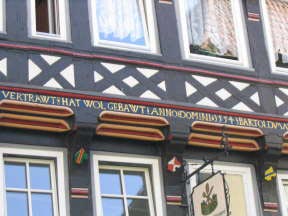 tended fachwerk houses (the half timbered ones I told you about before), with lush geraniums spilling out of window boxes. Some of the timbers of the houses were carved to resemble a braid or twist, or painted with flowery tendrils in primary colors, and almost all of them sported some sort of blessing or perhaps a verse from psalms carved into the wood in ornate old German script. In front of the Rathaus, actors clothed in Elizabethan era costumes were performing a play for an audience scrunched up in whatever shade they could find. In the photo on the right, note the date of 1554 in the inscription.
tended fachwerk houses (the half timbered ones I told you about before), with lush geraniums spilling out of window boxes. Some of the timbers of the houses were carved to resemble a braid or twist, or painted with flowery tendrils in primary colors, and almost all of them sported some sort of blessing or perhaps a verse from psalms carved into the wood in ornate old German script. In front of the Rathaus, actors clothed in Elizabethan era costumes were performing a play for an audience scrunched up in whatever shade they could find. In the photo on the right, note the date of 1554 in the inscription.
Another town we found ourselves in, called Halberstadt, was also interesting, but in a different way. A small core of old fachwerk houses sat near the cathedral, looking even more ancient for their dilapidated condition. Rusted water tanks and abandoned factories languished alongside roofless houses in a weedy lot. Few people were around and gave the town an eerie half deserted feeling. In the old Jewish section, a stone portal marked all that was left of a Jewish mansion. The roads were also in poor shape and as we stopped for a traffic light, Mike leaned over to the car next to us and asked the driver if we were in the east. She answered that, “yes, we are in what was once Eastern Germany”.
Once in Berlin, we stayed for five nights to get ourselves reorganized and rested. We had a pile of paperback books which we wanted to trade in for new ones, and amazingly, we found two used English book shops that took our old books. The bike needed a new front tire and an oil change again, so we found a shop that could take care of us. They had to order the tire from a tire shop in town, telling us that none of the bike shops here stock tires, so it would take a couple of days. We made a mental note to ourselves after seeing the bill for the work to always change tires in France when possible; the 100 euros for a tire in France would cost us €164 here. In addition, the labor is higher here, and they added an extra €15 to have the mechanic ride the bike around the parking lot a few time. We also noticed that they were charging us for less oil than is usually put in when changing the oil. “The book says it takes 2.7 liters” the shop told us. “Yes, the book says 2.7 liters”, Mike agreed, “but it always takes more oil than that”. “But the book says 2.7”, the guy pedantically replied. We’ll see.
Apparently the German’s methodical approach to motorcycle maintenance was a good thing – albeit more expensive for us – because in the process they discovered that the head bearings for the front steering were badly worn and would need to be replaced, something the French probably wouldn’t have caught. We got the news when we returned a few days later to pick up the bike. They would have to order the parts from Holland and could get them by Thursday morning – that is if they were still available for this bike – but the garage would not guarantee that they would have time to work on it. With the heat wave had come a lot of business for the garage and the garage manager did not want the workers working overtime in the heat. No amount of pleading would change their mind. We were due in Hamburg Friday night so we figured if nothing else we would take the parts with us and have someone install them along the way.
(Oh, yea, about the oil. Mike figured out that both he and the French, when changing the oil on our bike, drain more out of the crankcase tipping the bike by putting it on the side stand, thus having to add more than the book says when refilling it. In this case, stereotypically, the German shop did put precisely the amount called for by the manual…)
We met a Belgian biker one afternoon in the metro; spotting Mike’s FFMC tee-shirt (French Federation of Angry Motorcyclists, a pseudo-political motorcyclist group), he excitedly began speaking French to Mike. Switching to English, we found out that he was staying in a hotel near us, and at a suggestion that we meet in the evening for a drink, we found ourselves sitting at an outdoor café, eating pizza and drinking beer and talking about riding in the Ardenne in Belgium and his work with a Belgian gun manufacturer. (I suppose there is a need for guns in this world, but I don’t have to like it. He talked also about how his wife had committed suicide with a gun and I wonder how he can reconcile continuing in such a sordid business but felt too shy to ask…) The heat of the previous few weeks had finally broken, and a lovely cool breeze was blowing. After dinner we returned along a street that during the day had been full of young people and sightseeing tourists, but was now dimly lit and lined with prostitutes, drug-induced or anorexically thin and wearing more makeup than clothing.
Thursday afternoon we called the shop to see what was happening with the bearings and they said it was all done. The parts had come and somehow, magically, they had time to install it all. The catch is, that the shop would not take foreign credit cards and we would have to pay the bill (almost €700 in total) in cash! Withdrawing money from various accounts we were able to come up with enough money to get our bike back…
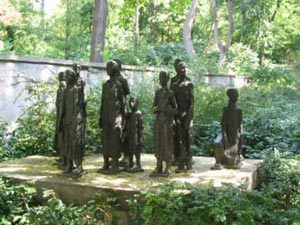 Every time I am in Berlin, I marvel at how many reminders there are of the war and Hitler’s plan for the Jews. Indeed, many of the young Germans we talk to still have the shame of it all very much on their minds even though they were not around at the time. Those who would think Germany or the world forgetful, have only to visit here to realize the fate of many Jews have not been forgotten. We stumbled upon what had once been a Jewish cemetery and found a poignant group of silent statues, one with a wilted rose placed in its arms, and a nearby plaque was piled with tiny stones left by reverent Jews paying homage to the dead. This graveyard, as well as all the other Jewish monuments like
Every time I am in Berlin, I marvel at how many reminders there are of the war and Hitler’s plan for the Jews. Indeed, many of the young Germans we talk to still have the shame of it all very much on their minds even though they were not around at the time. Those who would think Germany or the world forgetful, have only to visit here to realize the fate of many Jews have not been forgotten. We stumbled upon what had once been a Jewish cemetery and found a poignant group of silent statues, one with a wilted rose placed in its arms, and a nearby plaque was piled with tiny stones left by reverent Jews paying homage to the dead. This graveyard, as well as all the other Jewish monuments like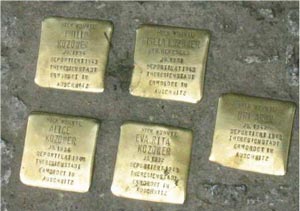 synagogues and community centers are all guarded by watchful cameras and in some cases, behind barriers set up relatively recently. We also saw many clusters of brass plaques in front of buildings where Jews had lived, maybe 5 inches square, set into the pavement each inscribed with a name, some dates and their fate – “deported to Teresienstadt”, some say, “and murdered in Auschwitz”. Continuing with the Jewish theme, we ate dinner at a restaurant next to the New Synagogue which served Israeli-vegetarian cuisine for a delicious change from German food.
synagogues and community centers are all guarded by watchful cameras and in some cases, behind barriers set up relatively recently. We also saw many clusters of brass plaques in front of buildings where Jews had lived, maybe 5 inches square, set into the pavement each inscribed with a name, some dates and their fate – “deported to Teresienstadt”, some say, “and murdered in Auschwitz”. Continuing with the Jewish theme, we ate dinner at a restaurant next to the New Synagogue which served Israeli-vegetarian cuisine for a delicious change from German food.
August 15th, 2003
Now that the heat wave has broken and Europe gets back to its normal weather pattern of showery days interspersed with warm humid days, the continent takes a look back to the effects the unusually hot few weeks have had. Fires have devastated large areas, burning in Portugal, Spain, and the Southern coast of France. Authorities are now saying that the French fires on the Cote d’Azure are arson fires, set by developers hoping to pick up some cheap land to develop when the government sells land once covered with trees. An unreal figure of 10,000 people are purported to have lost their lives to heat related causes, mostly elderly people, and the French government is also under fire for not doing enough during the crisis.
On a positive note, the German winemakers are ecstatic. Testing the amount of sugar accumulating in the grape tells the vintner when the grapes are ready to harvest, and this year’s heat enabled the German harvest to begin almost a month early. Never before have they had such an early harvest and are saying that this years wine will especially good. Something to remember next year when the wines are ready to drink.
Now that it’s cooler, we were back into dodging showers of rain as we headed south. We had spent a few days visiting with my parents in Hamburg where they had come for a visit. Compared to Berlin, with its anarchic feel, grafitti’d walls, its bands of young street people, pierced and dressed in rags and the generally run-down state of the city, Hamburg feels more like a sedate but elegant matron. We had a nice visit and did some sightseeing, including a trip to Wilkomm Höft, set on the banks of the Elbe river. We had lunch at the restaurant there, sitting outside on the large open terrace overlooking the river where we could watch the ships passing up and down. A lookout tower also watches the river, and as a ship passes, a loudspeaker plays the national anthem of the ship, a brief message of welcome to the ship and then gives statistics of each ship such as size, year it was built and where, and cargo capacity. Since it was Sunday, there wasn’t much traffic, but we did see a few container ships pass…
From Hamburg, we headed south into Austria. We were thinking about the beautiful lake of 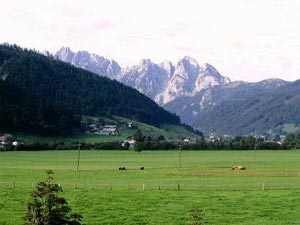 Wolfgang See in Austria that we had stumbled on last year, and we thought we would go there and stay a few days in the hotel we had stayed in last year. Evidently, we forgot to look at the calendar! On a weekend, in mid-August, the grassy edges of the lake were crowded with people sunning or going for a swim. Even more people were walking in the town. Needless to say, we decided to push on, since there were few rooms available.
Wolfgang See in Austria that we had stumbled on last year, and we thought we would go there and stay a few days in the hotel we had stayed in last year. Evidently, we forgot to look at the calendar! On a weekend, in mid-August, the grassy edges of the lake were crowded with people sunning or going for a swim. Even more people were walking in the town. Needless to say, we decided to push on, since there were few rooms available.
Following some twisty roads through wide valleys and over mountain passes, we enjoyed some of the most stunning views (I think!) in Europe. The valleys were covered with grass, intensely green and bordered with jagged grey mountains, some tall enough to be topped with glaciers. We found a nice pension in one of these archetypical valleys, with a kitchen and a balcony that looked out on pastureland dotted with cows and the grey teeth of a mountain called Dachstein. A very rural small town, called Gosau, spread up the road, a cluster of traditional Austrian style buildings with flower-filled balconies. The town was just big enough to support a post office, a grocery, a bakery and a general store where one could buy odds and ends. There are a few restaurants where Mike could get Jägerschnitzel, which he had been dreaming about. A thin piece of pork meat, breaded and fried like Wiener Schnitzel, but with a cream sauce with mushrooms poured over the top. I had Käse Spätzle, a local specialty, which was small twists of pasta dough, sautéed with onions and melted cheese over the top. Not exactly a light meal, but it was delicious all the same…
I spent the morning writing and by lunchtime, Mike was getting cabin fever, so I took a break and hopped on the bike with Mike. We went up the road a bit towards Dachstein through a couple of small villages, not much more than a couple dozen buildings strung along the road. As we climbed up in altitude, we saw a few lakes, part of a chain of lakes dammed to make hydroelectric power. At the end of the road, a beautiful lake sat at the foot of the craggy mountain peak which was reflected in the water. A restaurant served food, so we got some lunch then walked partway around the lake where hikers were descending paths that led up into the hills.
Later that evening, we ventured out of our apartment again, to go to the grocery store to get some picnic food for our departure in the morning, but by the time we got there, the store had closed, just a few minutes earlier. We hung around for a few minutes watching a string of tourists and locals scream into the parking lot, then watched their shoulders slump when confronted with the locked door. One of the passersby was a young Indian from Calcutta, oddly out of place here. He told us he was studying to be a chef and had gotten a summer job here to cook for one of the hotels. Without a vehicle, he felt trapped because the bus service, run by the Austrian postal system, also shut down at 7 p.m. His mother, out of a misguided sense of trying to protect him, had taken his drivers license before he left India. After several months, unable to get to the “big city” to dance at a disco or find other entertainment for his free time, his term of employment was feeling like imprisonment.
Leaving Gosau, we headed west across much of Austria, towards Switzerland. We had stopped for gas and found a brochure for some motorcycle hotels in the area. The hotels all featured cool stuff like bikes to rent, motorcycle garages with a workshop for working on your bike with tools, chain lube and a lift, dry-rooms, boot dryers (!), road books with cool rides to take in the area, etc. We had to check it out so we headed to a small ski-town called Serfaus, in a western corner of Austria near the border of Switzerland and Italy. The hotel, as you might guess, was full but there was an information center with a list of hotels so we went back to choose another place to stay.
Mike stayed by the bike while I went in to the information center to check it out, not bothering to take my helmet off. I pulled the door open to see a small boy standing on the doorstep inside. He looked up at me with wide eyes, gave a violent shudder then ran screaming to his parents in fright at the moon man who had unexpectedly appeared in front of him. He slowly calmed down after I took my helmet off and his parents explained to him while trying to keep from laughing, that I was a nice lady, not a space man. I guess he’d never seen a biker before…
The next morning nice and early, we crossed over the Reschen pass into a strange corner of Italy with bilingual signs, 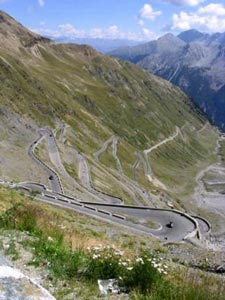 looking a bit Austria but with a difference that was hard to define. This alpine area has a language and culture all its own. from there, we tackled Stelvio pass (photo at left), a hair-raising series of tight switchbacks on a narrow road shared with other vehicles including many bicyclists straining up the hills. Some of the switchbacks were so narrow that our motorcycle had trouble getting around them and it seemed as if they went on forever. At last we were at the top, where crowds of bikers were parked, relieved to be at the top. We went over a few more passes before settling for the night in a small town in Switzerland.
looking a bit Austria but with a difference that was hard to define. This alpine area has a language and culture all its own. from there, we tackled Stelvio pass (photo at left), a hair-raising series of tight switchbacks on a narrow road shared with other vehicles including many bicyclists straining up the hills. Some of the switchbacks were so narrow that our motorcycle had trouble getting around them and it seemed as if they went on forever. At last we were at the top, where crowds of bikers were parked, relieved to be at the top. We went over a few more passes before settling for the night in a small town in Switzerland.
The next day, we crossed the rest of Switzerland, riding one pass after another; Oberalppass, Sustenpass, Grimselpass. It’s the weekend again and there are lots of bikes out, riding the endless switchbacks and congregating at the top of the passes. Although the sun is shining, the air is cool at this altitude. At the top of Grimselpass beside a small alpine lake, we met a young couple living in Switzerland; she is American, from N. Carolina, and he is French, each on their own bikes. We got an e-mail from them a few weeks later, with a photo attached. Taken just 2 months earlier in June, the photo showed the same lake we were standing next to, but full of large chunks of ice, snow covering the 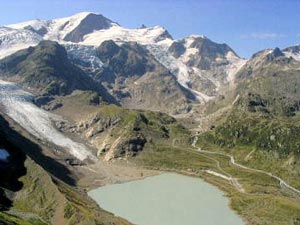 ground. There isn't much growing at this altitude, aside from sparse grass and moss, and a neon green lichen covering the rocks. I wandered off to get a better view of the valley and encountered a small flock of mountain sheep; long curly fleece like a mop, flat brown faces and ears framed by small horns curving up out of the long hair...
ground. There isn't much growing at this altitude, aside from sparse grass and moss, and a neon green lichen covering the rocks. I wandered off to get a better view of the valley and encountered a small flock of mountain sheep; long curly fleece like a mop, flat brown faces and ears framed by small horns curving up out of the long hair...
This time of year, the mountain passes are barren, and the sparse vegetation growing in the gritty grey soil are mostly a rusty green color. The alpine meadows are full of sharp rocks, and the mountain tops are jagged. Some of the mountains have glaciers, melting into a lake colored a milky grey-green color from all the glacial rock dust suspended in its water. I had not spent much time riding in Switzerland before this, and I have to confess that I was surprised that the country does not look more like Austria. The road wound through village after village of small wooden cabins, stained a dark color and boards warped with age or larger stone houses and hotels clustered around a church with a tall pointed steeple.
One last pass for the day, the pass of the Grand Saint Bernard and we were once again in the northern Italian alps. Passing an attractive house built of stone on the road just before Aosta, we stopped and turned around 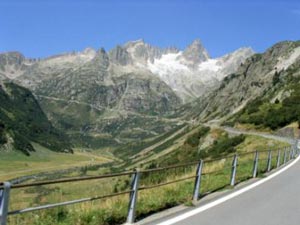 when we noticed the sign “Bed and Breakfast Les Fleurs”. A tall iron fence enclosed a yard with flowery terraces leading up the side of the hill, even more flowers spilling from pots and windowsills. The proprietress showed us a lovely room for €50 including breakfast, and had us park the motorcycle inside a tall iron fence for safe-keeping. Although we didn’t have a language in common, we managed to understand each other; she would speak to me in French and to Mike in Italian!
when we noticed the sign “Bed and Breakfast Les Fleurs”. A tall iron fence enclosed a yard with flowery terraces leading up the side of the hill, even more flowers spilling from pots and windowsills. The proprietress showed us a lovely room for €50 including breakfast, and had us park the motorcycle inside a tall iron fence for safe-keeping. Although we didn’t have a language in common, we managed to understand each other; she would speak to me in French and to Mike in Italian!
Since we were still about 10 kilometers away from Aosta, the restaurant choices for dinner within walking distance were limited. There was only one restaurant/bar nearby, in fact! It was a little early for dinner, but we were starving so we headed down the hill at about 7pm after a quick shower and change of clothes. “Yes, you can get food but not until 8:30”, the woman at the restaurant said. Not even a snack, a piece of bread? “You cannot get food until 8:30”, she repeated, a little more firmly this time. We settled down, with a bottle of sparkling water, to wait until we would be allowed to order food.
Mike ordered the local specialty, just simply “soup” on the menu. It turned out to be a large bowl of bread, soaked in a small amount of broth, with melted aromatic cheese, cooked cabbage and small bits of ham. Not too interesting to look at, but the soup turned out to be surprisingly tasty, a good hearty meal for a winter in the alps.
August 25th, 2003
Back on the road, the sun was shining and the morning air cool but pleasant. Perfect weather for another day of riding mountain passes; we would be zig-zagging over the 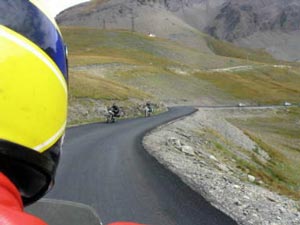 border between France and Italy a few times before stopping again for the night. As the crow flies, the B&B we stayed in near Aosta, Italy, was only about 20 miles from France, but to get there we would have to take the pass of Petite Saint Bernard into France, switchbacks making the actual mileage about 2 ½ times longer. Once over the Petite St. Bernard, we continued along the French side of the border, riding the passes of Col D’Isere and Col de L’Iseran.
border between France and Italy a few times before stopping again for the night. As the crow flies, the B&B we stayed in near Aosta, Italy, was only about 20 miles from France, but to get there we would have to take the pass of Petite Saint Bernard into France, switchbacks making the actual mileage about 2 ½ times longer. Once over the Petite St. Bernard, we continued along the French side of the border, riding the passes of Col D’Isere and Col de L’Iseran.
At the bottom of L’Iseran, we stopped for coffee on a sunny terrace and had a nice chat with some French bikers and with an English couple. The bike that the Brits were riding was a new model that Mike had had his eye on and he was curious how they liked it. We chatted a bit about traveling and favorite rides in France and then it was time to move on.
Heading south, we hit Col du Mt. Cenis, which dropped us back into Italy again, just over the border. Descending into the Italian town of Susa, we could feel the heat and humidity building as we wound down through the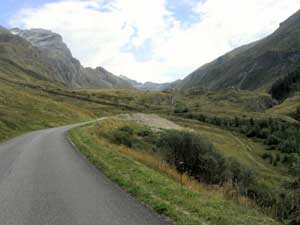 narrow one-way streets. Passing a small café along the road, we again ran across the Brits sitting on the sidewalk enjoying a good cappuchino, so we stopped for a few minutes to say Hi before hitting the road again.
narrow one-way streets. Passing a small café along the road, we again ran across the Brits sitting on the sidewalk enjoying a good cappuchino, so we stopped for a few minutes to say Hi before hitting the road again.
We were not far from the border with France, heading towards a big black cloud looming in the distance over the pass. After a few moments of indecision (should we continue on or head back to the sun?), we decided to push on and were soon holed up under a bridge watching the rain pouring down, filling the fields with water and cooling the air. After a ½ hour wait, the rain was done so we continued on, carefully. Riding up the road we started climbing when started sprinkling again, lightly, but we felt committed at this point, because we were in the mountains again and between two towns. By the time we got to the small town of Cesana-Torinese, the rain had stopped.
Just outside the town, the road started to ascend again. We slowed to take the first curve, which was relatively gentle with a slight incline, when a small disaster struck. One moment we were upright, and the next thing we remember we were sliding across the road with the bike spinning away from us into the next lane. In the days afterwards, reliving the accident over and over again, all we could think of was that there must have been diesel on the roadway, and combined with the water from the rain had made the road slippery as ice. We were leaning into the curve to the right, and like a circus clown stepping on a banana peel, the tire lost its grip on the road and instantaneously slid out from under us. It all happened so fast that, like I said, it was hard to remember just what happened!
Traffic was coming around the curve from both directions, and drivers leapt out of their cars to help right the bike. We wheeled it to the side of the road and assessed the damage; the right side mirror had snapped off as had Mike’s foot peg on the right side. The handlebar was bent slightly and the right side turn indicator was broken, a hole in one of our side bags which holds Mike’s clothing, and there were a variety of other scrapes on the body one would expect from sliding across the road. Amazingly, Mike had no visible damage and I seemed to be ok except for my right hand; it felt like I had bruised the heel of my hand and it was starting to stiffen. We numbly watched the traffic pass; a truck’s wheels spin a bit trying to get purchase on the road but a group of bikers navigate past with no problem, including the Brits we were playing tag with, who wave at us as they pass, not noticing that we had trouble.
The bike seems to be drivable but the major problem is that Mike’s foot peg is gone, so as we drive back into town to get some help, Mike has to rest his foot on mine while I hold the broken parts. There are very few services available in this town, nor in the slightly larger town we had stopped in earlier when we waited under the bridge for the rain to stop. We wanted to find someone to weld on the foot peg (how do you say that in Italian?) but the only guy in town who may have had the equipment to weld aluminum had closed for the day.
We were about 15 miles from the French town of Briançon so we decided to suck up our courage to drive on, back up the curve we had fallen on. The sun has come out and the road is starting to dry (if only we’d waited a bit longer!). Aside from being in a slight state of shock, we had no problems going over the pass, thankfully a mild series of switchbacks, and were soon battling the traffic in Briançon. A small fortress sat on a hill overrun with tourists and was flanked by a parking lot full of cars. We stopped at a couple of car repair shops and no one was willing to consider welding aluminum nor did they have any ideas on how to jerry-rig something for us. We were sent from one place to another until we happened on a Yamaha shop/gas station where the proprietor had the brilliant idea of putting on a foot peg from another (more common) bike – not identical, but it worked.
We were back in business. Except for the right hand mirror, which was broken and could not be put back on the bike. Mike relies on it heavily, especially when passing, looking in it to see if the lane was clear to merge back into. This is only a handicap, though, and we decide to find a room in a town called Gap, about 55 miles further. Briançon is just too crazy with all the people and cars and we needed a place to relax and calm shattered nerves. Plus the fact that Gap is a bigger town and we may have more resources for completing the repairs on the bike.
We rode through some beautiful country, the land gradually flattening out, the mountains behind us lit with the sun just starting to go down. I had a hard time concentrating on the scenery though, with our minds buzzing and replaying the accident over and over.
We got a nice room in Gap, where we stayed for 3 nights. The woman running the hotel 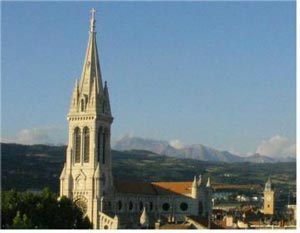 sympathetically gave us an enormous room on an upper floor and a bag of ice for my swollen wrist. We had a close-up view of the pointed cathedral steeple, striped with alternating rows of grey stone and a lighter pearly grey stone. Beyond the cathedral and the old town below, we could see the points of the mountains showing in the background.
sympathetically gave us an enormous room on an upper floor and a bag of ice for my swollen wrist. We had a close-up view of the pointed cathedral steeple, striped with alternating rows of grey stone and a lighter pearly grey stone. Beyond the cathedral and the old town below, we could see the points of the mountains showing in the background.
All in all, we were very lucky. The damage to the bike was mostly cosmetic, except for the right rear-view mirror which had broken off, and the right handle-bar, which was a little bent and was now scraping paint off the fairing. Our leathers were a little scraped in the right knee as you would expect from sliding across the road – which is why we wear leather! - and my right glove was also scraped up a bit. My wrist is a little swollen but doesn’t hurt much and doesn’t seem to be broken, and both of my knees were now black and blue; other than that we are both fine. I really don’t understand how both knees got bruised as I don’t remember hitting them, nor do I remember hitting my hand…
Mike spent the days in Gap making calls and visiting all the bike shops in the area, scouring France for parts he needed to put the bike together, while I relaxed. No luck in finding a new mirror, but we managed to get it glued onto the bike with some sort of self-hardening putty. The guy at our favorite junk yard in Paris has the body piece we need and promises to set it aside for us when we return in another month.
Our days took on a simple rhythm. In the morning we’d walk down to the sunny main square in the middle of town for coffee and wander narrow streets while it is still cool. In the afternoon we would return to the square and chose one of the many restaurant/bars around the plaza for lunch under a large umbrella and enjoy the warmth of the sun. We would make another foray into town in the evening when it cooled to a balmy temperature to find something for a light dinner and a stroll through quiet streets in the dark.
Time to leave Gap. Most of the shock has worn off though we are very cautious as we set off, gaining confidence as we go. Just before noon, we decide we’d better get some food for lunch as the stores will be closing soon, as they all do in France. So the next town we came to, we stopped at a grocery and got some cheese and roasted chicken, and went to the bakery for a baguette. A notice in the window caught my eye; with today’s date, it warned of a storm that would be passing through the area with “violent winds and rain, and possible flash floods”. Yikes. The man at the bakery confirmed this, shrugging his shoulders as to when it might hit, some time this afternoon, I suppose…
Conscious of an impending storm, we stopped at the first picnic area past the town that we came to. The wind was building so we didn’t linger over our meal; 15 minutes later we were back on the road south, heading into the wind. The country was very interesting, with gorges of bare stone laid in layers along winding streams, hilly country and flat pastures. As we came into Provence, the country became gradually stonier with low shrubs then flattening out into a vast flat area full of vineyards.
We hit the highway near Nimes and continued south into a strong headwind. The sky ahead was a murky dark grey and the air was hot and thick with humidity but we managed to make it to the coast near Perpignan for the evening without getting rained on.
The next day we continued south towards Andorra in the Pyrenees. It was still windy although the sky was clear. As we wound our way up through the mountains, the wind would gust, pushing and shoving the bike around as if we were caught in a crowd of rowdy teenagers. I closed my eyes and held on tight, trying not to panic as I pictured us going down again. Soon enough we were in the town of Andorra La Veilla waiting for the parts store to open after siesta at 3:00pm.
As I mentioned in a travelogue earlier this spring, Andorra is a good place to go shopping and have bike work done. Mike wanted to get a new rear tire and new brake pads put on, so we picked up the parts then went down the hill to a shop we had used before. The mechanics at the shop were very competent and by late afternoon, after waiting a couple hours for them to complete the work, we were finally free to try to find a hotel for the evening. One of the guys at the shop suggested one in a town up the road so we went back up the hill to find it. We weren’t too impressed with the looks of it and knew of another hotel where we had stayed before so we turned around and headed back down.
The traffic was building from bad to truly horrible and was moving slowly through the narrow streets when Mike suddenly noticed that the engine light has come on, indicating that the engine is overheating. We pulled over the first chance we get and started stripping the bike to see what is going on. The fan that is supposed to turn on to cool the engine is not coming on until Mike jumpered it using a bent paperclip. We put the bike back together and stopped by the shop we had spent so much time at earlier that day. The mechanics were just leaving for the day but after listening to our problem they suggested that the thermostat needed to be replaced and for us to come by the next morning.
The next morning, Mike took the bike back to the shop and to make a long story short, the mechanics had only come in on a Saturday morning to help us out on their day off. (I am so glad we stopped!). One guy ran around town looking for a thermostat that would work, calling back to the shop occasionally to get other guy’s opinion on something. In the end, we ended up with a Bosch part meant for a car and they only charged us about €50 for the part and the labor. Such a deal… It would make the fan come on at a lower temperature (sooner) than the original one, but it works fine.
August 30th, 2003
Winding down out of the Pyrenees, we headed back into Spain where we stopped for a quick lunch in the Catalan town of Seu d’Urgell. The town was preparing for a fiesta and the streets were hung with pennants and amusement rides were being set up in a small section closed off to traffic. There was a feeling of festivity in the air and we ate our lunch amidst the shrieking laughter of boisterous children playing and the adults talking loudly to be heard over the children. Ah, we’re back in Spain again. (the Spanish have GOT to be the noisiest people in Europe with the possible exception of the Italians).
Once out of the mountains, we crossed a vast plain with mesa-like hills baked brown from the sun and the road seems straight as an arrow. Occasional churches or half ruined castles survey the landscape from their setting on top of a cliff. The wind is strong but steady and the area is very dry looking; the pattern of erosion of the hillside tells me that the rainfall is scarce here but when it does rain, it carries a lot of the loose soil with it. (I was later to read that the area is called the Central Depression and the high winds contribute considerably to the aridity of the region by evaporating any moisture).
Soon we neared the city of Zaragoza, ringed with dense, seemingly concentric circles of growth as is typical in Spain. First we saw industrial zones, new apartment buildings being built and acres of tiny identical houses planted one next to another, then older apartment buildings already looking decrepit, but we could also see the four towers and numerous domes of a large church so we continued to follow the signs to the historical center. In the center, a stone bridge crosses the Ebro river, leading to the magnificent Basilica Nuestra Senora del Pilar whose four towers we saw from outside the city. Mudejar towers and a jumble of stones also intrigued us as we wandered around looking for a hotel room.
Earlier this spring, I had told you about the Talone system of staying in hotels in Spain for €50; we still had one left over from our tour through here in May, so we asked at one of the 4 star hotels if they would accept it. They told me they would take the talone for one night so we moved in to the room and went out to explore after a quick change of clothes.
It was Sunday, so I quickly grabbed a handful of brochures and a city map at tourist  information, then we headed to one of the sights in town that would be open today, the Palacio de la Aljaferia. This palace was built in the 11th century by the Moorish king, Abu Jafar Ahmed Almoctadir Bila, or just plain al-Jafar, who ruled the area at this time. He romantically named it Dar Asurar , or House of Joy. Predating the Alhambra, Spain’s most famous Moorish palace, it was home to a succession of both Moorish and Christian kings and today the Aragonese Parliament meets in a one section which is closed to the public. What is visible to the visitor is an austere façade outside; an almost square fortress with high walls and crenellated towers. Inside it is a beautiful airy space with delicate lacy plasterwork arches and a large open courtyard with orange trees. Rich coffered ceilings with gilded pineapples and gothic calligraphic inscriptions ring the rooms of the later catholic kings upstairs. For many years it was left to slowly fall apart, and at some point the delicate arches were disguised with plaster and the building used as barracks. It has been recently undergone extensive restoration; little by little the plaster was stripped away to reveal a surprisingly beautiful monument.
information, then we headed to one of the sights in town that would be open today, the Palacio de la Aljaferia. This palace was built in the 11th century by the Moorish king, Abu Jafar Ahmed Almoctadir Bila, or just plain al-Jafar, who ruled the area at this time. He romantically named it Dar Asurar , or House of Joy. Predating the Alhambra, Spain’s most famous Moorish palace, it was home to a succession of both Moorish and Christian kings and today the Aragonese Parliament meets in a one section which is closed to the public. What is visible to the visitor is an austere façade outside; an almost square fortress with high walls and crenellated towers. Inside it is a beautiful airy space with delicate lacy plasterwork arches and a large open courtyard with orange trees. Rich coffered ceilings with gilded pineapples and gothic calligraphic inscriptions ring the rooms of the later catholic kings upstairs. For many years it was left to slowly fall apart, and at some point the delicate arches were disguised with plaster and the building used as barracks. It has been recently undergone extensive restoration; little by little the plaster was stripped away to reveal a surprisingly beautiful monument.
On the way back to the hotel we found the municipal market, closed on Sunday, which on weekdays is busy with shoppers buying groceries at stall after stall of fresh produce and meats. We found a nice, new-looking 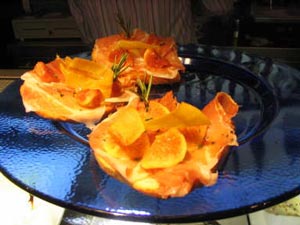 hotel called Hotel Hispania nearby and went in to check it out. For €55 a night, the room was surprisingly nice, bright, and clean with phone and air conditioning. We were realizing that there are a lot of interesting things to see in Zaragoza and it would be worth staying a few extra days, so we decided to move here for a few nights. The Hispania was only a 2 star hotel and the room was not as deluxe (no mini-bar or bathroom toiletries!) but it was a comfortable place and the ladies at the desk were really nice. And we parked for free in a locked garage.
hotel called Hotel Hispania nearby and went in to check it out. For €55 a night, the room was surprisingly nice, bright, and clean with phone and air conditioning. We were realizing that there are a lot of interesting things to see in Zaragoza and it would be worth staying a few extra days, so we decided to move here for a few nights. The Hispania was only a 2 star hotel and the room was not as deluxe (no mini-bar or bathroom toiletries!) but it was a comfortable place and the ladies at the desk were really nice. And we parked for free in a locked garage.
We wandered around town and found a slightly newer section of town with a broad avenue lined with arched arcades. Restaurants and a large department store called "el Corte Ingles" (my favorite place!) were busy with people out for their evening paseo. We found an interesting restaurant called Las Vegas, where we stopped for some tapas. I had seen a report on TV a few weeks earlier about how Spanish chefs are using tapas, the small plates of appetizer sized food, as a canvas for some truly creative cooking. Las Vegas was certainly one of those places. For example, I tried a tapa that consisted of a piece of peasant bread topped with a sliced of cured ham, some fresh cut figs and a paper thin curl of fried banana. We decided to have a dinner of some appetizers with an excellent bottle of Spanish wine and were not disappointed. Before they brought out the food we had ordered, the waitress brought both of us a bowl with about a delicious half inch of a creamy cold soup made with real Foie Gras, a few curls of the French liver pate garnishing the center of the plate. After the soup, we were given a glass the size of a shot glass. A poached egg yolk sat at the bottom, topped with foamy whipped potatoes and sprinkled with crispy crunchy fried bits of ham. We were instructed to eat it with the tiny spoon provided, ‘from the bottom up’. To say the potatoes were whipped is an understatement, they had the consistency of a delicate mousse, melting in your mouth. The ingredients of egg, potato and ham is certainly basic, but I have never had it prepared in such a way – it was heavenly! Then came the food we actually ordered, but to tell you the truth, I can’t remember what it was (but it was good).
Long before the moors came here, the Romans had settled here and named the town Caesar Augusta, which if you leave off the “Cae” part of the name and sort of slur it as you say it, you will see how Zaragoza got its modern name. The Romans left more than the name. As we wandered through town, we stumbled across a section of the old city wall, and an archeological dig where they were busy uncovering the remains of a Roman Theater built in the 1st century. In fact, there is a string of four Roman museums, covering variously, the theater, the river port, the forum and a small fragment of the public baths. The museum at the theater I found the most interesting, as it took you through time from the building of the theater to present day. We learned that by the middle of the 3rd century, the theatrical activity had declined and that they were going through a period of political instability and barbarian invasions, so they dismantled their own theater and took the stones to build a wall of protection around the city. The old quarter of the city still clearly preserves the rectangular shape imposed by the strong walls. Over the next few centuries, the theater site was used for different purposes, and by the 1400’s, the area was part of the Jewish barrio and was inhabited by people who probably had no idea that they were living in something that was partly built by Romans, since there wasn’t much left but the 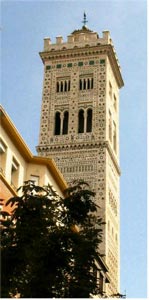 foundations and a few walls.
foundations and a few walls.
Zaragoza is a good sized city, over 600,000 people, but has a comfortable small town feel to it and friendly people. Zaragoza also seems to have a lot of Ecuadorian immigrants, more than we have seen anywhere else. In a town where 99% of the people are white, the community of immigrants seemed startling; their bronze Indian faces and black hair distinctly different from the Spanish.
We were not able to find a movie theater with original version movies here, only movies dubbed into Spanish, but we did find a good and inexpensive internet place, part of a computer school, where we were able to plug our laptop into their network and have a faster connection than the phone at the hotel.
Being a typical Spanish city, Zaragoza has a lot of churches. What I found interesting was that there are more Mudejar style church towers here than in Sevilla! (In April I explained that Mudejar style was like an imitation Moorish style, that seemed to have found favor here in Zaragoza in the 15th century). I counted at least 7 Mudejar towers, one of the prettiest is La Magdalena with its golden brick inset with white, green and blue ceramic tiles and roundels.
Another interesting church is the ancient church of San Juan de los Panetes with its distinctly leaning tower. Then you have the magnificent Basilica of the Pilar with its towers and domes with colored ceramic tile roofs (see picture at right). Inside the basilica is also breathtaking, and the ceilings of a few of the domes have the added distinction of having been painted by Goya, one of Spain’s most famous painters. Certainly he is important here, as he was born in a nearby village and spent much of his life in Zaragoza. The domes of the basilica are said to be his first commissioned 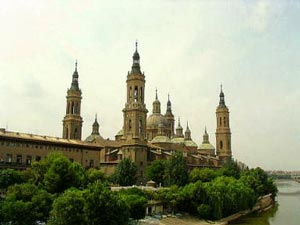 works.
works.
To me, the basilica is more spectacular than the cathedral, although the latter has its own charm. The building of the cathedral began in 1189 on the site of the old mosque, and at first followed a purely Romanesque plan. Over the centuries, the building was added to and today’s cathedral is a startling mix of very different styles from the12th thru the 18th centuries; Mudejar, Romanesque, gothic, renaissance, baroque and neoclassic.
One section of the cathedral houses a tapestry museum, which I visited one afternoon while Mike went to the internet place to do some work. On display were some 60 panels each covering a good size section of wall, floor to ceiling. They were woven in Belgium between the 15th and 17th century of silk and wool and to give the scene they depicted more detail, the panels were woven with an amazing 50 threads to the square centimeter. I stood there gawking at one of them, by myself in the large room when the curator came, very apologetically, to tell me that he was very sorry but he was closing. “But if you come back in the morning”, he told me, “I will let you look at the tapestries some more”. For free, he kept assuring me. On the way down he stopped and led me to a case displaying some magnificent vestments and pointed out the ornate embroidery on the brocaded fabric, telling me there were 1000 real pearls sewn on to this single garment. I don’t suppose may people spend as much time looking at them as I did and he was happy that someone appreciated them as much as he did.
It was time finally to leave Zaragoza. We packed up and in the morning, first thing after a cup of café con leche, we set off. About 5 miles out of town it started to rain. Finding a bridge to hide under, we watched the rain coming down for the better part of an hour. We could see some lights up the road maybe ½ mile away, but couldn’t tell what they were; as the rain came down harder, the lights were gradually obscured in rain as were the hills in the distance and thunder boomed overhead.
Eventually, the rain tapered off a little and we were able to see more and more of the countryside emerging from the fog of water, spray and clouds, so we headed down the road as we debated what to do. The lights turned out to be a rest area, with gas station and a café/restaurant and we pulled in to get out of the rain and have some lunch. It was pouring down rain again, and a cleaning woman was busy trying to sop up water leaking through the large picture window, pooling on the windowsill and spilling onto the tables and floor in front of the window.
We spent a few more hours here, enjoying our lunch and a leisurely cup of coffee while we read books to pass the time. The rain is still coming down and it is now afternoon, no time to get anywhere; we were only 10 miles out of town. In the end we called our hotel and went back, somewhat sheepishly. Of course, it has finally stopped raining, but somehow, it felt like something was telling us not to go. After our spill in Italy, I had resolved to pay more attention to those little hunches.
We spent two more days; getting a little more organized, making plans and hotel reservations, spending time at the internet place getting some more work done. And, of course, the next day was sunny and nice again. The news on TV showed that the rains had been unusually severe, and in Calatayud, a town we would have gone through, they showed a flooded river and residents trying to clear water-logged homes.
============================================================
Here are some places we recommend in Zaragoza;
Hotel Hispania: 2 star with bath, TV, AC, telephone and free parking, €60. Breakfast available but not included. Avenida Cesar Augusto, 95-103 across from public market. Tel. 976 284 928, fax 976 283 916. www.hotelhispania.com e-mail: reservas@hotelhispania.com
Bar Las Vegas, Paseo Independencia, 19. Good wines, interesting tapas and meals. Pricey but worth splurging on a few tapas. Telephone: 976 238 034
Toscana
Although I didn't mention this Italian restaurant in the story, it is worthy of a footnote. The first time we ate there, we both ordered a plate of pasta each plus some garlic bread, and were horrified to see what they considered a single serving of pasta...It was HUGE! The next time we came, one order of pasta was more than enough for both of us, although our waiter claimed that he has had customers order a pizza to start, then polish off a whole order of pasta by themselves. Calle Cadiz, 6. Telephone:976 237 767
Another place I didn't mention: if you like wine, check out this tiny bar called Bodegas Almau on Estebanes, 10. It's a neighborhood type bar with good Spanish wines by the glass and a small selection of standard tapas.
September 6th, 2003
When we finally set out from Zaragoza, for good this time, we heading to Madrid 300km to the southwest, the sky was clear 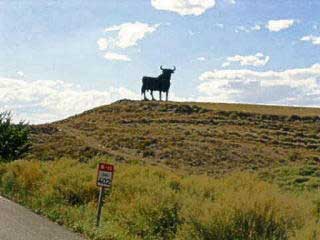 and blue. From Zaragoza, we passed through a lot of typical Spanish landscape; rolling golden dry hills with shrubby green plants, and the ribbon of road ahead of us undulated with the hills while heading straight west. The rivers we crossed were thick brown with mud from the recent rain storm. Every so often we would see the iconic Osborne bull in the distance, as if surveying his territory from a hilltop. Originally an advertisement for Osborne Sherry Brandy, the bull is an enormous black silhouette usually set in a field on top of a hill so you can see it for miles. It seems natural that this bull would become sort of a national symbol of Spain.
and blue. From Zaragoza, we passed through a lot of typical Spanish landscape; rolling golden dry hills with shrubby green plants, and the ribbon of road ahead of us undulated with the hills while heading straight west. The rivers we crossed were thick brown with mud from the recent rain storm. Every so often we would see the iconic Osborne bull in the distance, as if surveying his territory from a hilltop. Originally an advertisement for Osborne Sherry Brandy, the bull is an enormous black silhouette usually set in a field on top of a hill so you can see it for miles. It seems natural that this bull would become sort of a national symbol of Spain.
When we got to Madrid, we now had the challenge of finding the hotel where we had reserved a room; all we had was a vague idea of where it was. Getting off the highway, we started looking. We could have circled for hours, so we stopped at a hotel called Sofitel to ask them if they knew where it was. They did, and got a map out to show us. We weren’t far, just on the other side of the highway. Just out of curiosity, we asked if they would take talones for two nights and were surprised when they said they would take one talone per night.
With the help of the map they gave me, we had little trouble finding the other hotel, but it turned out to be in a neighborhood that looked a bit run down. The only place to park the motorcycle was in a garage and they wanted to charge €11 a night. The first hotel had looked so nice, although a little remote, but it seemed nicer, so we decided to go back and check in to the Sofitel. We didn’t care much that it was so far from town because Mike was planning on hanging out at the hotel watching the Motorcycle Grand Prix which was being run that weekend in Portugal. I still find it a bit amazing that they accepted one talone per night; a €50 talone for a room that is regularly €280?! What a deal!
The room was nice, a huge cushy bed with down pillows and a palatial bathroom, a nice plush place to hang out for a few days. They let us park the bike out front (no charge), in this quiet area, no one would disturb it even if there were no guard outside all night. Not far from the hotel was a stop for the Metro which we took into town for dinner that night. We ate at our favorite restaurant, Casa Mingo, that is famous for their Asturian style cider and roasted chicken. After dinner, we went to see a movie, starved for something in English. We found a theater which shows movies in the original language with Spanish sub-titles. It is difficult to find movies in English except in a few of the larger towns in Spain - of course the selection is a bit limited, but Pirates of the Caribbean turned out to be amusing so I can’t complain too much… We discovered that Starbucks is now in Madrid so we went to get a nice cold frappuccino to sip on this balmy evening
On our way out of Madrid, we stopped in town; it was time again to find a used book store and trade in some books, and we had found the address for a self-service laundry on the internet. It is hard to find a laundry in 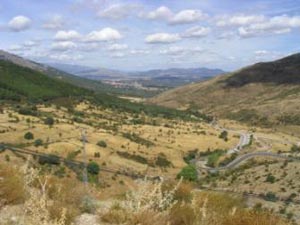 Spain so we were quite happy to find this one, a clean well-run laundry with an attendant who helped us through the process of putting our money in the machine, getting soap, etc. This laundry was one of a Italian chain called Ondablu, and one bonus was that they have a few computers, where for €1 per ½ hour, you can surf the internet while washing your clothes. We had gotten the address for a bookstore that sold English books, but it turned out to be a new book store. They directed us to another place back in the center near the laundry, which sells used books in English as well as French, German, Italian and Catalan, where we were able to get rid of some books and get some new ones.
Spain so we were quite happy to find this one, a clean well-run laundry with an attendant who helped us through the process of putting our money in the machine, getting soap, etc. This laundry was one of a Italian chain called Ondablu, and one bonus was that they have a few computers, where for €1 per ½ hour, you can surf the internet while washing your clothes. We had gotten the address for a bookstore that sold English books, but it turned out to be a new book store. They directed us to another place back in the center near the laundry, which sells used books in English as well as French, German, Italian and Catalan, where we were able to get rid of some books and get some new ones.
From Madrid, our plan was to revisit a few places we had gone to earlier this year; the first stop was Avila, a little more than 60 miles away. We still remember the bodega that we had discovered the last time and wanted to go back. We had tried several times to get a reservation in the hotel we had stayed in last time, trying both the internet and at a travel agent but couldn’t get a reservation through the talone system, so we decided to walk in when we got there and see what they say. No problem, was the answer. When we first started using Bancotel Talones, we thought reservations needed to be made through travel agencies but we were having a lot of luck just showing up. This is such a great system.
Oh yea, the bodega was just as we remembered it. Built into the outside of the wall just outside the Puerta del Peso de la Harina (the gate of the weighing of flour), it is called Bodega San Segundo. Walls covered with shelves packed with bottles of wine, barrels set along the walls as tables. The bar was set up with several groupings of opened bottles of wine; red wine from the area, white wine in a huge silver bowl of ice, more reds from other parts of Spain. We tried the wine we had enjoyed last time, Convento San Francisco, and it was just as good as we remembered. With each glass of wine, we got a complimentary plate of tapas; a few boiled new potatoes covered with a garlicky mayonnaise, a couple slices of baguette with a piece of cured ham, a plate of olives…
 Drinking wine at the bodega and trying different ones was like a journey of discovery of Spanish wines for us. Ribera del Duero. We bought a bottle of the Convento San Francisco to take with us, a whole €12 – expensive for Spanish wine but worth it. I hope it survives the trip back to Paris…(we asked if it were possible to mail back to Paris. Yes, it’s possible but the cost to send it would be more than the cost of the wine itself, since to mail it to France would be international. So much for an economic union.)
Drinking wine at the bodega and trying different ones was like a journey of discovery of Spanish wines for us. Ribera del Duero. We bought a bottle of the Convento San Francisco to take with us, a whole €12 – expensive for Spanish wine but worth it. I hope it survives the trip back to Paris…(we asked if it were possible to mail back to Paris. Yes, it’s possible but the cost to send it would be more than the cost of the wine itself, since to mail it to France would be international. So much for an economic union.)
The walls of Avila were a wonder of military architecture for their time, and today the well-restored walls still completely encircle the rectangular old town. The walls were started in 1090 to stave off the Moors, taking advantage of stones left from ruined Roman walls and buildings in the area. In fact, you can clearly see the ‘recycled” stones in the wall; various stones bearing an inscription (and set into the wall up-side down) taken from the roman cemetery, while other stones are carved with a hole or basin, possibly altar stones. I took a walk around the walls one afternoon, about 1 ½ miles around. The old town is set on a bluff, as is typical for a fortress town, at an altitude of about 3600 feet. The view frozm one end, the paseo del rastro, affords a great view of the wide Ambles Valley, a viewpoint where hundreds of years ago, Avilans would watch for the arrival of invading armies. The town was very prosperous during the 16th century, and all over the old town you can see splendid old palacios and the home of noblemen, coats of arms carved in stone and set over the doorway.
The next night we spent in Salamanca, at a newly built “boutique hotel” called Melia Las Claras. A travel agent had gotten us a good deal, normally requiring 2 talones per night, we got a special price of only one talone. The room was nice, but the bed was so hard that it was like sleeping on a board. Needless to say, neither of us slept well that night.
 Salamanca’s old town is mostly old buildings faced in a yellow sandstone, that at sunset turns golden in the sunlight. The tourist map we were given explained some of the monuments to look for, such as the Plaza Mayor, which it described as “doubtless the most beautiful arcaded square in Spain”. It goes on to explain that it is Baroque in design and the Town Hall is built into the north side. As far as I could tell, it looked pretty much like the Plaza Mayor in Madrid, only a little smaller and missing the statue in the center. But like the one in Madrid, it had plenty of cafes along its inner arcades with tables spilling out of the shade into the sun.
Salamanca’s old town is mostly old buildings faced in a yellow sandstone, that at sunset turns golden in the sunlight. The tourist map we were given explained some of the monuments to look for, such as the Plaza Mayor, which it described as “doubtless the most beautiful arcaded square in Spain”. It goes on to explain that it is Baroque in design and the Town Hall is built into the north side. As far as I could tell, it looked pretty much like the Plaza Mayor in Madrid, only a little smaller and missing the statue in the center. But like the one in Madrid, it had plenty of cafes along its inner arcades with tables spilling out of the shade into the sun.
Salamanca also boasts Europe’s oldest university and there are many intricately decorated buildings influenced by the Italian Renaissance style. Salamanca also has not one but TWO cathedrals to its name, one built in the medieval period. The other, finished in the early 1700’s, was lit by the waning sunlight as we walked past, glowing bright gold. The plaza in front of it was crowded with people, as a free concert was going on. The city was celebrating a weeklong annual festival with music and performances going on. Passing the cathedral, we walked down to the river to look at the stone bridge and passed a magnificent art-deco house with amazing stained glass windows. It was an art deco museum, but was just closing. We’ll need to come back another time to see the house and museum, as it looked really interesting.
We asked at the hotel if we could stay a second night so that we could go to a concert the next night. Yes, they said, but it would cost us two talones. Oh, well, never mind. We’ll have to plan better next time. We walked back into town 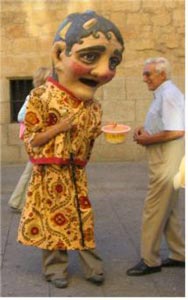 and to get a cup of coffee on the pedestrian street and all of a sudden I started hearing some commotion down the street with music and shouting. From a side street, we saw a crowd emerging with a band of musicians playing some traditional music. The thing that all the kids went running to see were the Cabezudos, people dressed in costume with a huge fiberglass head. There was a bullfighter, a senorita, a policeman, a bull; about a dozen figures in all, teasing the children and collecting money in a small plastic basket as the parade moved slowly down the road.
and to get a cup of coffee on the pedestrian street and all of a sudden I started hearing some commotion down the street with music and shouting. From a side street, we saw a crowd emerging with a band of musicians playing some traditional music. The thing that all the kids went running to see were the Cabezudos, people dressed in costume with a huge fiberglass head. There was a bullfighter, a senorita, a policeman, a bull; about a dozen figures in all, teasing the children and collecting money in a small plastic basket as the parade moved slowly down the road.
Another interesting building is called the Casa de las Conchas. Its outer walls are adorned with a multitude of scallop shells carved in stone built by Don Rodrigo Arias de Maldonado as a wedding present to his wife. The shells represent the shells worn by pilgrims on the road to Santiago and are also the emblem of the Order of Santiago to which the Don belonged. The outer wall is broken by three gothic window, all different, with intricate wrought iron grills. Entering the building through heavy wooden doors and passing through a short hall, we found ourselves in a beautiful interior courtyard, square pillars supporting upper floors with a series of arches and columns of Italian marble and a railing of flashy carved stone that looks like wickerwork. Along the eaves a row of gargoyles spout water into the courtyard after a rain, and heraldic shields and carved lions complete the decoration.
Under the “traditions” section of the tourist map text, I read an amusing story about how “in the old days”, the university students would gather on the roman stone bridge on Lunes de Aguas (the Monday following Easter). It goes on to explain that during holy week, the prostitutes were sent out of the city to a brothel set up in 1498 on the other side of the river and not allowed to come back until after Easter. Not knowing what time the prostititutes would return in their boats, the people would gather on the bridge to await their return and have a picnic featuring the local specialty, a sausage-filled pie. The tradition of having a picnic on the bridge is still celebrated, but the brochure says nothing about whether the prostitutes still arrive by boat…
September 11th, 2003
From Salamanca, we continued our journey heading eastward again, following the Duero River through groves of oaks and poplar trees. The wine, Ribera del Duero comes from this region and as you might expect, the fertile broad valley was filled with rows of grape vines and wine bodegas. Wine has been grown here for a long time, and I read that in the town of Aranda de Duero, the ground under the town is honeycombed with underground wine storage made in the middle ages. The area is rich in history too; prehistoric man left his traces here as did dinosaurs who left footprints and bones. Celt-Iberians who were succeeded by Romans, Visigoths, Moors, and finally reconquered by the Spanish. The river valley is studded with Moorish castles such as the one at Penafiel or Gormaz, and Spanish cathedrals (such as El Burgo de Osma), monasteries (everywhere) and walled cities (ditto).
The landscape changes gradually, as the road starts to climb out of the valley, grape vines are replaced by oak trees then pine trees with bare straight trunks and flat crowns. These pines have a distinctive shape and whole groves of them look like stands of green umbrellas blown inside-out by the wind. The hills are rocky and Scotch pines become prevalent, with their twisted trunks gleaming red through the branches. The importance of the pines is marked by the names of some of the villages, like Los Pinares, or San Miguel del Pino.
We came to a small town called Soria and our first stop was tourist information. There 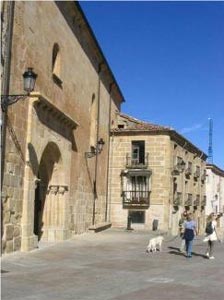 aren’t many hotels in town and the only 4 star in town is full, so we ended up in a small pension in a crummy room for 45 euros. (Sorry, I get a little grumpy paying that much in Spain for a 1 or 2 star place when I think what we could get with a €50 Talon). It was siesta time and the streets were deserted but we went out anyway, in search of a cup of coffee. Like I said, the streets were dead quiet and many buildings in the old city were abandoned, broken windows hanging on broken hinges, boarded doors covered with graffiti and ad posters. All of the shops were closed, with metal curtains pulled down obscuring the windows and giving the passerby no clue as to what the shop might be nor if it is even still in business. A few brazen tourists were out wandering around, tour books in hand looking at the12th century churches and palacios of “austere grandeur”. Austere, because most of the monuments seem to be almost completely unadorned, built in a Romanesque style which is very plain. Perusing the booklets I got at the tourist office, I saw that the town also boasts two hermitages and a monastery of the order of the Knights Templar, of which only some beautiful arches of Arabic design remain. It always amazes me how many churches there are in Spanish towns. The tourist brochures also keep emphasizing the “singular setting of Soria in the unforgettable and unspoilt nature of the region and the Rio Duero which looks like a long pond”, and the “relaxation and peace in the least populated province of Spain”.
aren’t many hotels in town and the only 4 star in town is full, so we ended up in a small pension in a crummy room for 45 euros. (Sorry, I get a little grumpy paying that much in Spain for a 1 or 2 star place when I think what we could get with a €50 Talon). It was siesta time and the streets were deserted but we went out anyway, in search of a cup of coffee. Like I said, the streets were dead quiet and many buildings in the old city were abandoned, broken windows hanging on broken hinges, boarded doors covered with graffiti and ad posters. All of the shops were closed, with metal curtains pulled down obscuring the windows and giving the passerby no clue as to what the shop might be nor if it is even still in business. A few brazen tourists were out wandering around, tour books in hand looking at the12th century churches and palacios of “austere grandeur”. Austere, because most of the monuments seem to be almost completely unadorned, built in a Romanesque style which is very plain. Perusing the booklets I got at the tourist office, I saw that the town also boasts two hermitages and a monastery of the order of the Knights Templar, of which only some beautiful arches of Arabic design remain. It always amazes me how many churches there are in Spanish towns. The tourist brochures also keep emphasizing the “singular setting of Soria in the unforgettable and unspoilt nature of the region and the Rio Duero which looks like a long pond”, and the “relaxation and peace in the least populated province of Spain”.
Not much in the mood to look at gloomy churches, we headed over to the Numancia Museum after siesta. Numancia is the name of an archeological site a few miles out of town which was once a Celt-Iberian town. When the Romans came along, they tried to take over the town but were so fiercely resisted by the Celts that the Romans ended up destroying the town after a long siege lasting over 20 years and built a new town on the rubble, 133 years before Christ. The museum was interesting but confusing; prehistoric, celtic and roman artifacts from different sites were sort of jumbled together and it was difficult to get a sense of time from looking at the display.
Coming out of the museum and into the square at the mouth of the pedestrian area, we were hit by a wall of noise. Where there had earlier been an empty plaza, there was now a vast crowd of teens, perched on walls and benches, gathered in doorways and congregating in the middle of the plaza all chattering loudly like a flock of crows. Shops reopen after siesta are full of mothers and teenaged girls buying back-to-school clothing. We battled our way through the plaza to visit a wine bar recommended by someone we had talked to, in hopes of finding a place like the bodega in Avila. We found instead, a bar which served only a few kinds of wine, out of a bottle with no label and tasting like it was home-made. The bartender was charming though and was happy to recommend a few restaurants where we might enjoy eating dinner.
According to one booklet I read, the town had great affluence in the 16th and 17th centuries, due to the large number of cattle and sheep owned by the nobles here. By the end of the 17th and 18th century however, many people emigrated including the nobles, substantially reducing the population both in Soria and throughout the province. What I found interesting is that it later goes on to mention the houses of the Indios in a town called Vinuesa in the Duero River valley. The Indios were the Spanish emigrants who, in the last century, returned to Spain after making their fortunes in Latin America. We might have to check it out on the next trip through the area.
From Soria we made a stop in Burgos for the night and stayed in another hotel for a Talone. It called itself a “style” hotel, although the room was charmingly furnished, it was tiny and to reach my side of the bed I either had to climb over the desk or over the bed. No 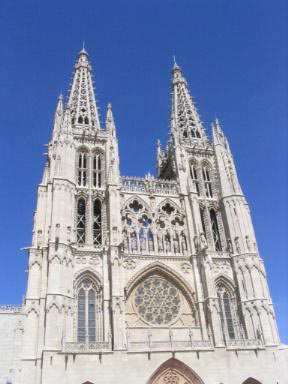 matter. We found that the hotel offers free coffee or tea, delivered to one’s room, and lost no time having a nice hot cup of café con leche.
matter. We found that the hotel offers free coffee or tea, delivered to one’s room, and lost no time having a nice hot cup of café con leche.
The last time we were in Burgos, last April, it was rainy and bitterly cold. I was sick and had no interest in emerging from our hotel room into the cold wind so we didn’t see much. Looking at my photos from April, the cathedral loomed dark grey over the roofs of the town. This time, the sun is shining and the filigreed stones of the cathedral glow a light grey, almost white in the bright sunlight. The church is built in a frothy gothic style with lots of pointy spires and steeples. A stop-over on the French pilgrim route to Santiago de Compostela, this church was one of the checkpoints along the way and is said to be the third largest cathedral in Spain.
In the morning, we picked up a fresh baked bread from the bakery, and had a nice breakfast in our room with our (free) café con leche, then began the process of packing up to leave. A few miles out of Burgos, we passed the actual pilgrim trail, which passed over the highway on a bridge. A few clumps of modern-day pilgrims were walking the trail, with their hiking boots and backpacks. Although their gear is much more modern than the medieval pilgrims, many were still wearing the scallop shell insignia.
Our last stop in Spain was in Bilbao. We had reserved a room in a hotel on a bluff overlooking the city, but when we got there, it looked like the facade of the hotel either was in the process of being remodeled or else it just needed it badly. It was still early so we decided to check out one of the other hotels on the bancotel list. Driving back into the center, we stopped at a light when we suddenly felt a thump from behind. A car had run into the back of us. Welcome to Bilbao.
To make a long story short, there was little or no damage, just a hassle, and although we waited for about an hour in the hot sun, no police car ever stopped. A passing Spanish motorcyclist stopped to mediate and call the police for us. The Spanish driver of the car was very annoyed at being detained and periodically would start waving his arms and start ranting again in Spanish about having to stay when nothing was hurt he only bumped us a little, but in the end we all tired of waiting and we all went our separate ways. For all that, when we finally reached the hotel we wanted to check on, it was full.
Navigating in Bilbao can be an exasperating experience, because many of the street signs are bilingual; that is to say that they are written in Basque and Spanish. The problem is that some of the signs have been attacked by pranksters or Basque separatists and all traces of the Spanish directions have been painted out with white spray paint, leaving the tourist faced with a totally unfamiliar and bizarre language. You can’t be sure if the sign indicates the name of a street or a building or ? Who knows?
Having lost our patience in spending time looking around for a hotel, we went back to the original one where we had a reservation, the Barcelo Avenida. The room turned out to be very nice, with a unique bathroom layout. The bathtub was set in a glass surround, and from the bed you could see through a window that separated the tub from the bedroom into the blue tiled bathroom. A pull down window shade gives the bather privacy and a frosted glass door hides the toilet room. (oh, yes, by the way, they WERE in the process of remodeling the façade of the building. That made me feel a little better).
Although a little ways from town, we weren’t far from a metro stop that would take us into town. We went into town to see the famous Guggenheim museum of modern art. Call me a philistine, but the most interesting thing about the museum is the avant-garde building, with its curving, contorted limestone walls plated with sheets of titanium. An enormous chia pet sits in the plaza at the entrance. Ok, ok, it is a piece of art by Jeff Koons, a huge sculpture shaped like a dog and covered over every inch with a patchwork of blooming flowers of all colors. Inside, contrasting against the remarkably high curving white walls of the atrium hung a black Calder mobile, spotlit from sun coming in through a skylight. One hall held a few large-scale sculptures and another had a whole lot of mobiles and sculptures by Calder, balanced on air and trembling with every current of air.
We were underwhelmed by the Guggenheim and went out to explore the rest of the town. On Saturday afternoon, not much was open and few people out on the streets except in the shopping area. Now it’s Sunday and the town is even deader including the shopping area, if that’s possible. Where is everyone? Looking for food for dinner we saw a few bars but no sign of tapas or menus on the counters. The hotel had given us addresses for a couple of tapas bars, but so far they were all closed. We finally found one bar that had tapas and struck up a conversation (half English, half Spanish) with two local women who recommended we try the local Basque white wine, called txakoli (pronounced something like chok-o-LEE). Waiting expectantly for us to taste it and pronounce it good, they then paid for it before saying goodnight and leaving.
We tried some of the tapas, which are a little different here from other parts of Spain. Platters of tapas are set out on the bar and one either takes what one wants or the bartender with give you what you point at. They are almost always some sort of topping on a small slice of baguette and skewered with a toothpick. Toppings range from ham or cheese, fish – anchovies, tuna, smoked salmon, to small Basque sausages or breaded and deep fried prawns. When it is time to pay, one simply presents their plate of toothpicks to be counted. Apparently this particular bar was in the tourist guides because it was gradually filling up with foreigners. Time to leave.
After sharing some tapas, we were still hungry. Walking back to the metro, there were no other places open at 10pm and I wonder if the bar we were in earlier was filled with people simply because it was the only one open? I know we are in the far north of Spain, in Basque country but it still seems shockingly early for things to close. Near the hotel, a Chinese restaurant is open and we gratefully order some food to take back to our room.
A friend later e-mailed us that he found Bilbao one of the most boring towns he had ever been in. And to let him know if we found any decent restaurants. Now he tells us!
September 15th, 2003
Leaving Bilbao behind, we took the toll road, a beautiful highway that winds through steep forested hills and gorges. After a bit, we caught occasional glimpses of the ocean as we came down out of the mountains and crossed out of Spain and into France.
We stopped in St. Jean-de-Luz, not far over the border, to get some lunch and perhaps find a hotel. St-Jean is a nice town just south of the more famous town of Biarritz. In the summer, St Jean is a busy town, with tourists crowding the restaurants and hotels or wandering the pedestrianized center, shopping for souvenirs and trinkets in the many tourist shops. It would be nice to stop there for the night to hang out and enjoy the sun. We thought it would be a lot calmer this time of year but there still plenty of tourists about.
We found a hole-in-the-wall shop selling sandwiches on round home-made Basque bread, with creamy goat cheese, tomatoes and ham, heated on the grill. We chatted with the woman in Spanish while we waited for the sandwich. I am glad we only ordered one for both of us, because when we got it, it was huge! The bread bun was nearly 8 inches across and absolutely delicious…
We decided not to stay in St. Jean; it was a gorgeous day for riding and still quite early. We headed east through the French countryside, through the Dordogne, an area we had never ridden before. With all the riding we do in France, you would think we know the whole country like the backs of our hands but we are always finding another beautiful corner we’ve never explored before. We rode through leafy tunnels of trees arching over the road, occasional brown leaves falling slowly to the ground to swirl in the wake of our passing and the sunlight strobing between the trees planted along the road. We saw acres upon acres of grapevines and fields of dry brown corn. Occasionally we would spot hilltops crowned by castles and forts, remnants of the medieval feudal system, warring nobles seeking to expand their holdings, and the age of English control of this territory.
Gradually we left the wine country and as the number of grape vines decreased, they were replaced with fields of tall tobacco plants. Many fields were already bare, the tobacco having been harvested and hung in sheds and barns to dry. We could see the yellowing leaves through the open doors of wooden barns with louvered sides, designed to let the air circulate. We also saw tobacco hanging in arched structures like greenhouses, with plastic stretched over the arched poles to keep the rain off.
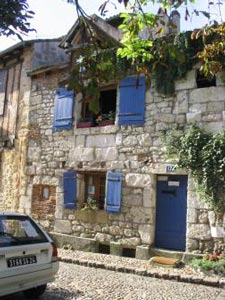 We entered the small town of Bergerac, intending to find a place to stay for the night. The girl at the tourist information office gave us a brochure of lodging in the area, and after we picked one out of the book, she called them to see if they had a room and made a reservation for us. The hotel was on a shady plaza, with trees lining the street, not far from the historical center of the town. The room was small and in spite of the amount of money we paid, it could be called a dump but we were tired and hot and ready to stop. It would be ok for one night. We ferried our stuff up to the room in a couple of trips; the elevator was tiny and made an alarming set of sounds; creaks and groans, clanking and knocking. Mike remarked that the noise could be used for the sound effects of a haunted elevator in a Halloween movie…
We entered the small town of Bergerac, intending to find a place to stay for the night. The girl at the tourist information office gave us a brochure of lodging in the area, and after we picked one out of the book, she called them to see if they had a room and made a reservation for us. The hotel was on a shady plaza, with trees lining the street, not far from the historical center of the town. The room was small and in spite of the amount of money we paid, it could be called a dump but we were tired and hot and ready to stop. It would be ok for one night. We ferried our stuff up to the room in a couple of trips; the elevator was tiny and made an alarming set of sounds; creaks and groans, clanking and knocking. Mike remarked that the noise could be used for the sound effects of a haunted elevator in a Halloween movie…
After freshening up and changing clothes, we went out to explore. Our first stop was a bakery where we bought a couple of pavés; cookies fresh out of the oven, like a thin, square shortbread cookie with a fruity jam filling. We stood in the shade of the bakery’s awning juggling the hot cookies from hand to hand, unwilling to wait for it to cool before devouring the delicious treats. Map in hand, we 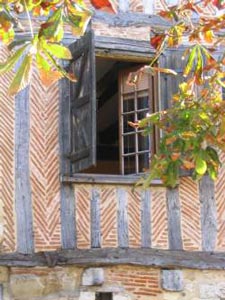 headed off down the street which sloped down towards the river and the old town.
headed off down the street which sloped down towards the river and the old town.
We found ourselves in a plaza hemmed in by old half-timbered houses and shops, an old mill house, a church and a round fountain where women would come to wash clothing. A couple of restaurants spilled out onto the plaza, tables and chairs shaded by large umbrellas. Huge pots full of flowers added color. A tourist brochure I had picked up explained that this was the square of the pelt merchants in olden times, evidently a wealthy group judging by the old buildings in the quarter. We went into a nearby shop which sold local wines and typical products from the region (lots of duck, foie gras and pates), to learn a little about the Bergerac wines. The shopkeeper gave us a taste of a few different red wines but we found them a bit light and not much to our taste.
Leaving the wine shop we walked out onto another tiny square, Place de la Mirpe, blazing with color (trite description maybe, but the effect of all the flowers in the sun really was dazzling!). A white stone statue stood modestly behind the display of flowers, and looking at it, I gave myself a mental head-slap. I had been wondering why the name Bergerac was so familiar but didn’t think much of it until I saw the statue, dedicated to Cyrano de Bergerac. (DUH!). Apparently, the story of Cyrano was inspired by a real person, a man named Savinien de Cyrano, whose active life inspired the author Edmond Rostand in 1897. I don’t think Monsieur Savinien was from Bergerac, but the city has adopted him enthusiastically.
Ringing the Place de la Mirpe were a collection of super atmospheric, drenched-in-charm buildings that had once been the homes of master bargemen. Most of them were built with stone on the ground floor while the upper stories were half timbered. The half timbered walls were filled with loam, a mix of mortar and straw, and thin bricks laid in an unusual herringbone pattern. In the midst of these houses sat one that was built entirely of stone, periwinkle blue shutters framing the flowery window boxes in the window. We noticed a small sign (in English and French) in front which announced that it was a bed-and-breakfast, so we knocked on the door.
A French woman answered our knock, and realizing that we didn’t speak French and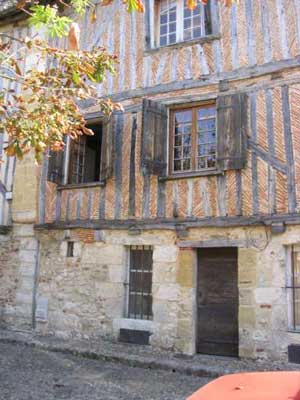 she didn’t speak English, she got her partner to come and talk to us. The partner turned out to be an American and the owner of the house, and loved to talk about the history of the town and his house. He explained that the house was built in the early 1600’s and was the oldest house in town. He has only a few rooms and was apologetic that he couldn’t show them to us as they were occupied. One room was in the former pigeon loft overlooking the square. The price was quite reasonable too, at 50 to 58 euros for two people including breakfast. Boy, I sure regretted having settled for the place we were staying in…
she didn’t speak English, she got her partner to come and talk to us. The partner turned out to be an American and the owner of the house, and loved to talk about the history of the town and his house. He explained that the house was built in the early 1600’s and was the oldest house in town. He has only a few rooms and was apologetic that he couldn’t show them to us as they were occupied. One room was in the former pigeon loft overlooking the square. The price was quite reasonable too, at 50 to 58 euros for two people including breakfast. Boy, I sure regretted having settled for the place we were staying in…
Continuing our chat, he told us about how Bergerac had been in the middle of a religious war. King Henri IV had signed an edict authorizing the Protestants to freely practice their religion, but when Louis XIV came to power, he decided that he wanted to return the town to Catholicism. He ordered the destruction of the protestant temples and the homes of those who would not agree to convert. Fires that were sparked quickly spread from house to house; homes that were close-set within the confines of the city walls. The half-timbered construction of wood and loam proved to be highly combustible and soon most were burnt to the ground. The only house left standing on the square was the little stone B and B. When the other houses were rebuilt, one concession was made to reduce future fire hazard, and that was to build the ground floor with stone instead of half-timber.
From Place de la Mirpe, we walked a short distance down to the Dordogne River, where we saw a couple of old-style barges moored. This was the riverport of Bergerac, once a very busy place, importing wood from the Auvergne for making wine barrels, and shipping out Bergerac wines, much of it destined for England. The barges in the water are recreations of the barges traditional to the area and now ferry visitors up and down the river on sight-seeing trips.
The next day we were back on the road again. The noisy elevator was in the process of being dismantled by a repairman, so we made three trips back down three flights of narrow marble stairs with our bags. This place was definitely not worth 70 euros, and I was half mad at myself that we had stayed there. Especially in view of what could be had for 50 euros elsewhere. Oh well, next time we come back to Bergerac, we’ll stay in the B and B.
Another gorgeous day. The sun was shining and the morning air had a brightness to it, clean and crisp. It was one of those stellar days that filled me with a feeling of something close to elation to be riding through this beautiful country road on such a wonderful day. As we left Bergerac, the Cyrano theme was reinforced by the names of the wineries and shops along the road; we saw one winery called Cyrano et Roxanne. Following the road in the direction of Auvergne, we passed more tobacco fields in the process of being harvested and barns full of drying leaves. From time to time we would pass by a chateau or castle built upon a hilltop. One such place was a small town called Beynac, its castle built at the apex of a cone-shaped hill with the town built on the slopes below; densely packed houses spiraling up as if to reverently touch the walls of the castle. This region of the Dordogne is definitely an area worth exploring in more detail, loaded with history, medieval castles and picturesque villages.
From the Dordogne we rode back through the Auvergne, hoping to see an autumn display of colorful leaves. I have to report that it was either still too early or the wrong types of trees but in spite of this the ride was still nice. The days are feeling autumnal, and the mornings are cool enough for us to see our breath. Heated clothing makes our morning ride pleasant and soon it is warm enough to turn the heat off all together.
A few more days of riding however, and both Mike and I decide that we are (gasp! Dare I say it?), tired of traveling, and the fully loaded bike is heavy and a lot of work to maneuver around the curves. Ever since our fall in Italy, we never did get back in the groove of riding, we were feeling more nervous and less trusting of the bike. We decided to go back to Paris early to spend the last few weeks of our stay in Europe in the comfort of our favorite hotel, the Suitehotel and visited with many of our friends there as we prepared to get on a US-bound plane.
